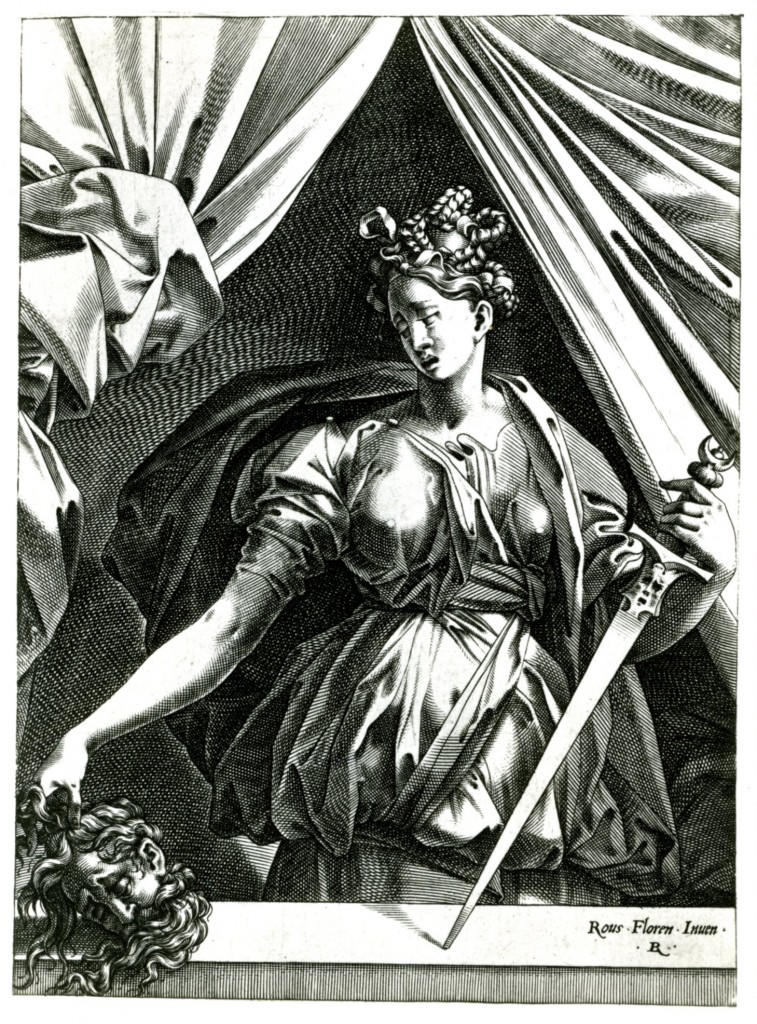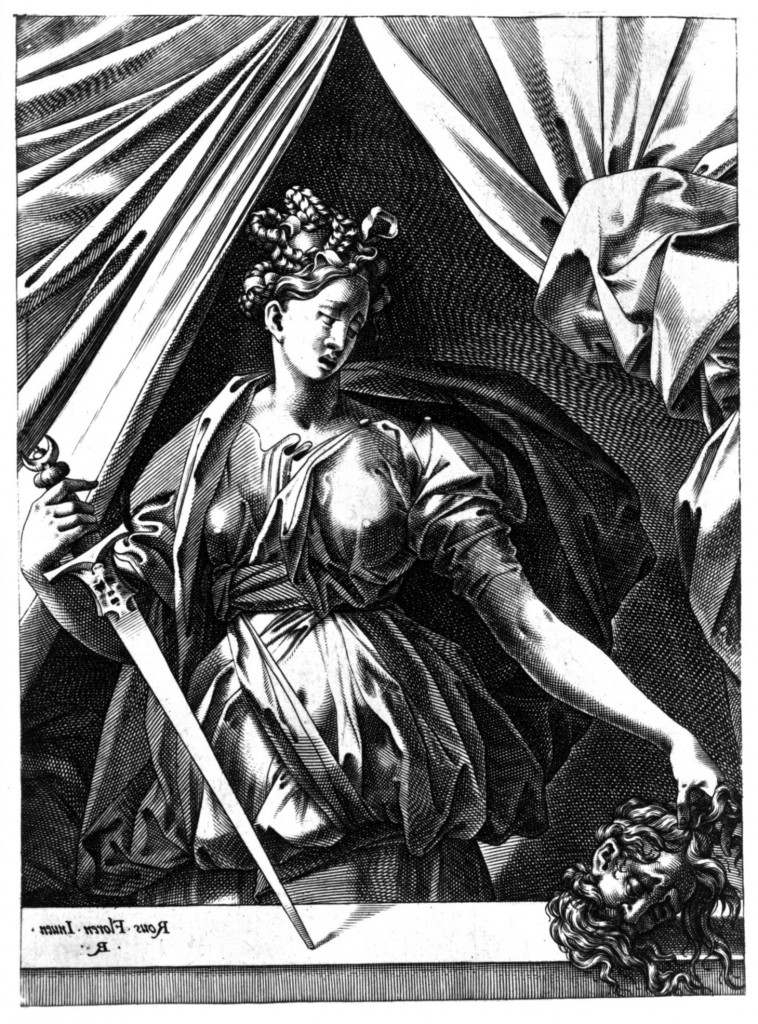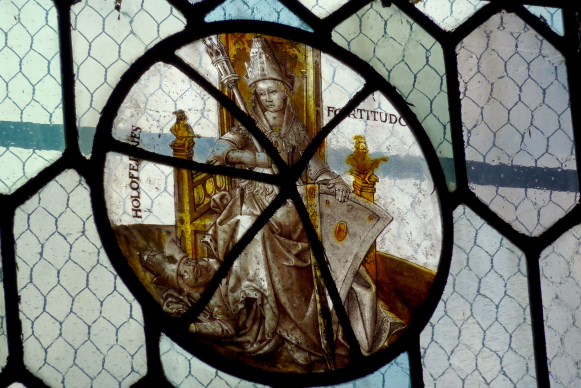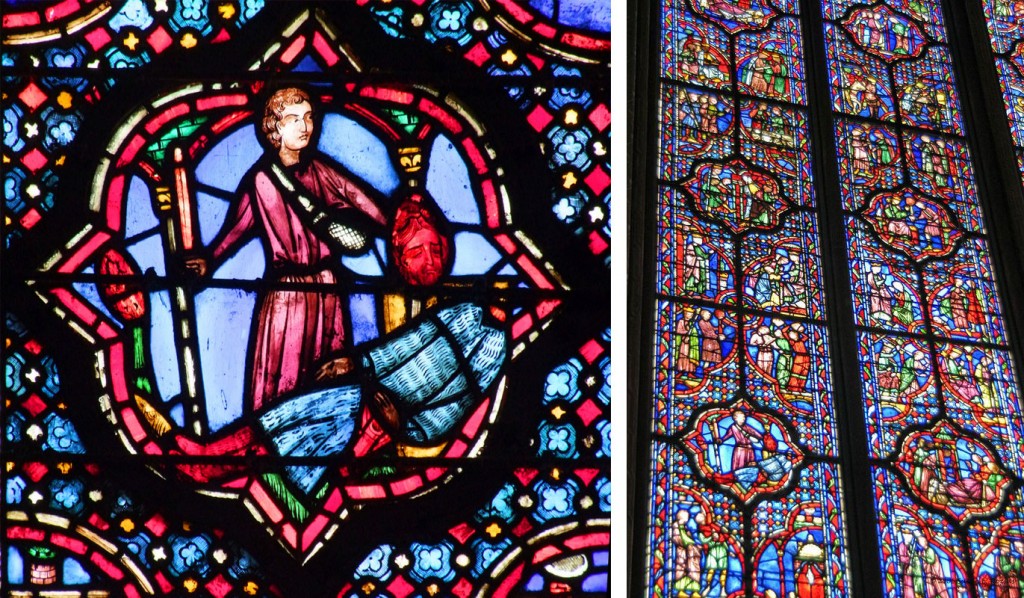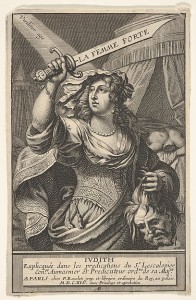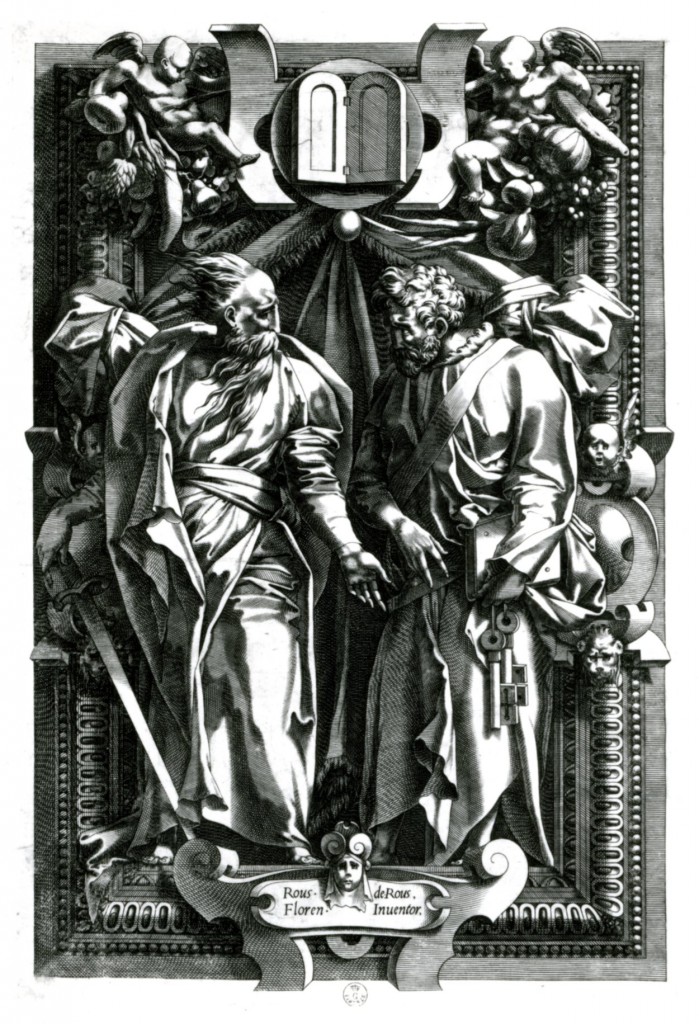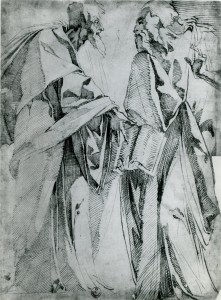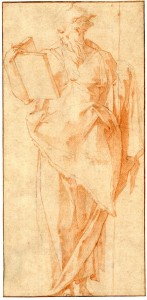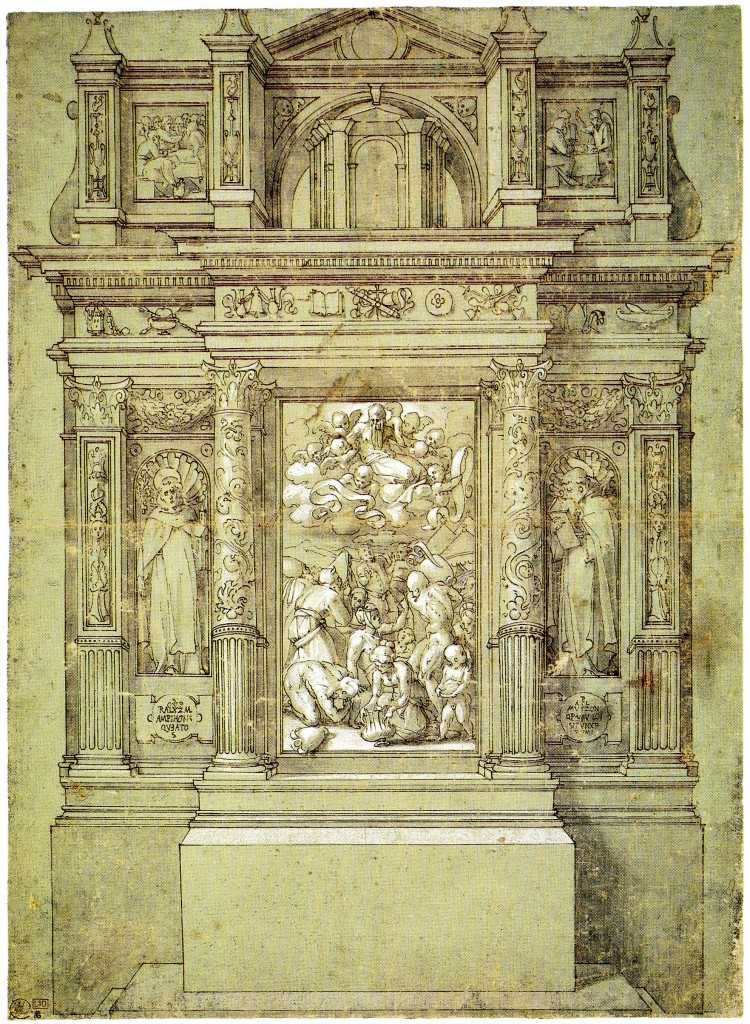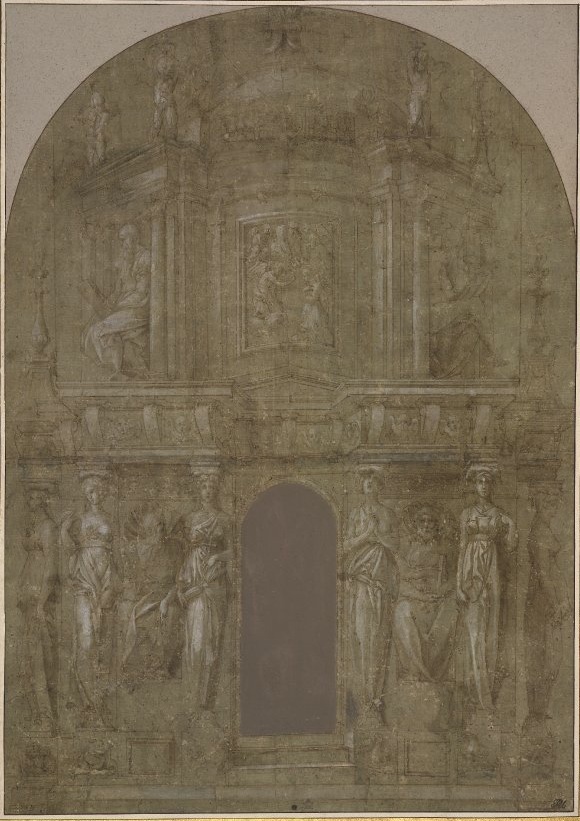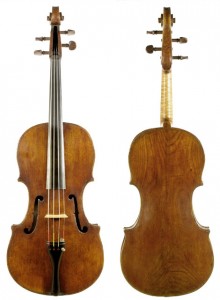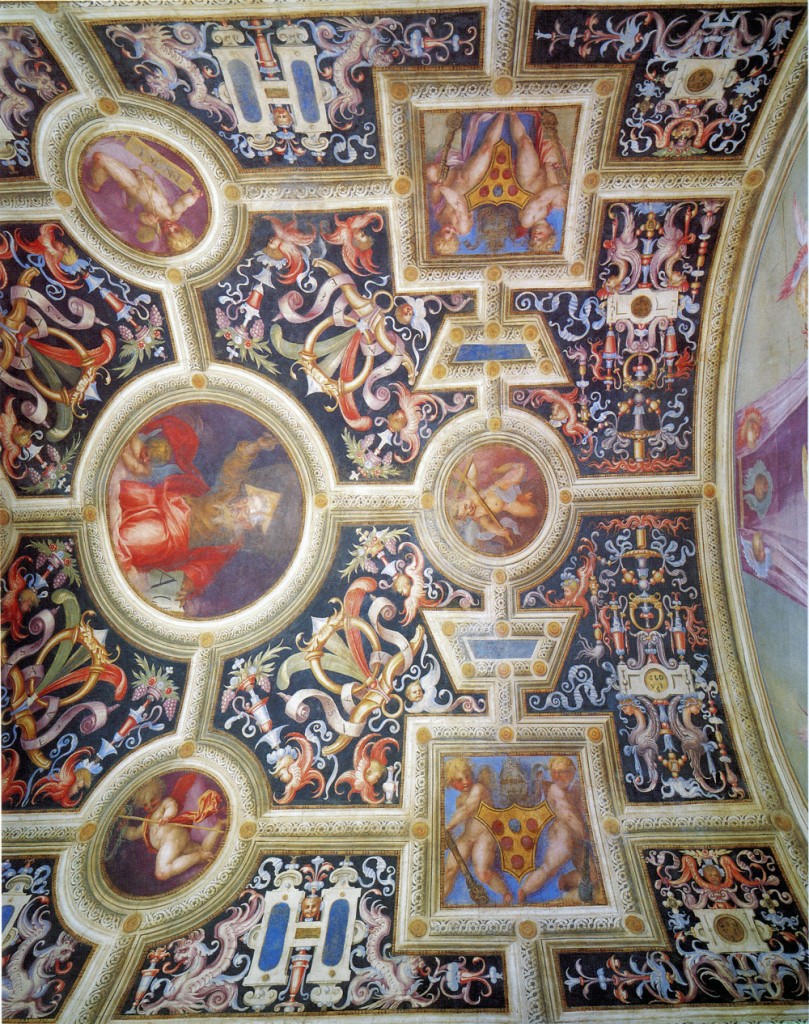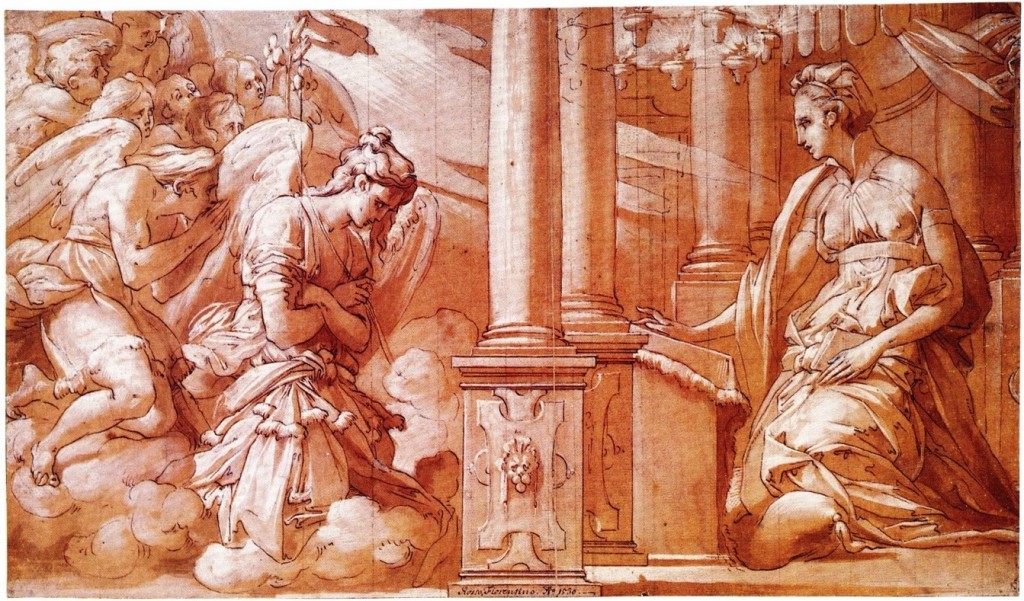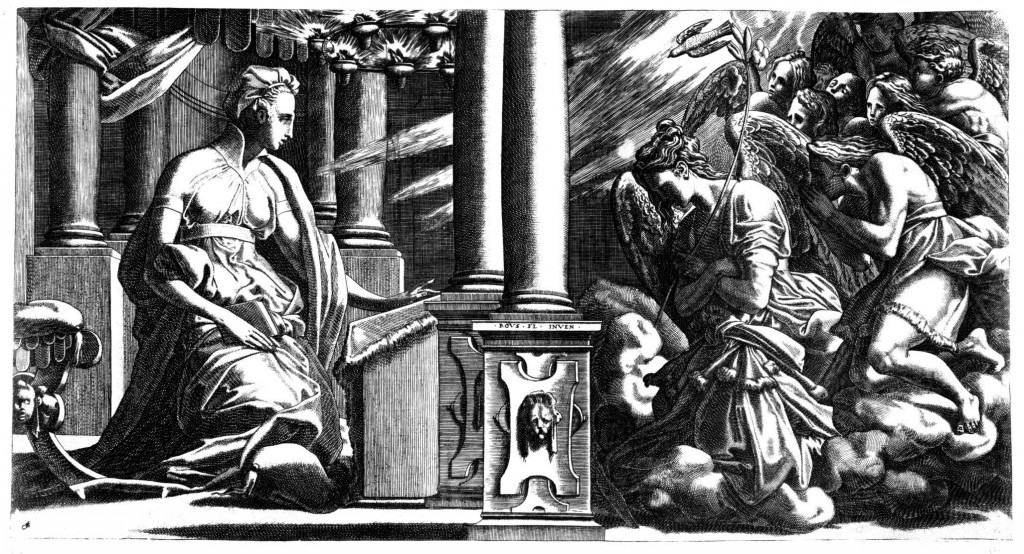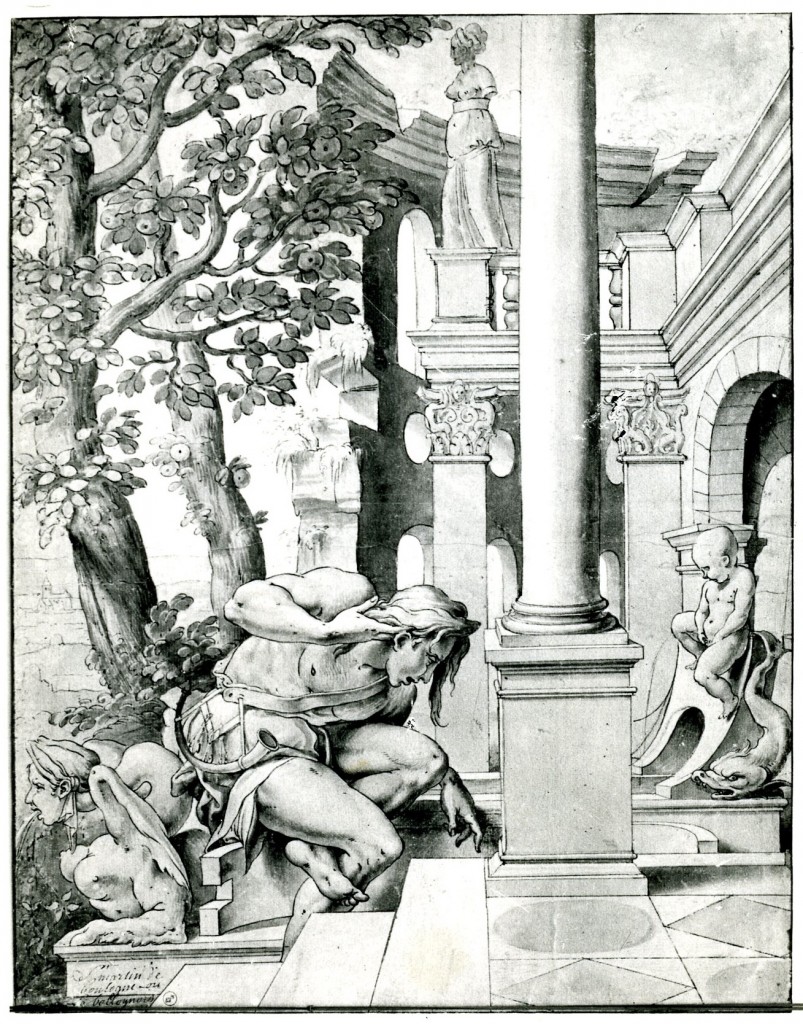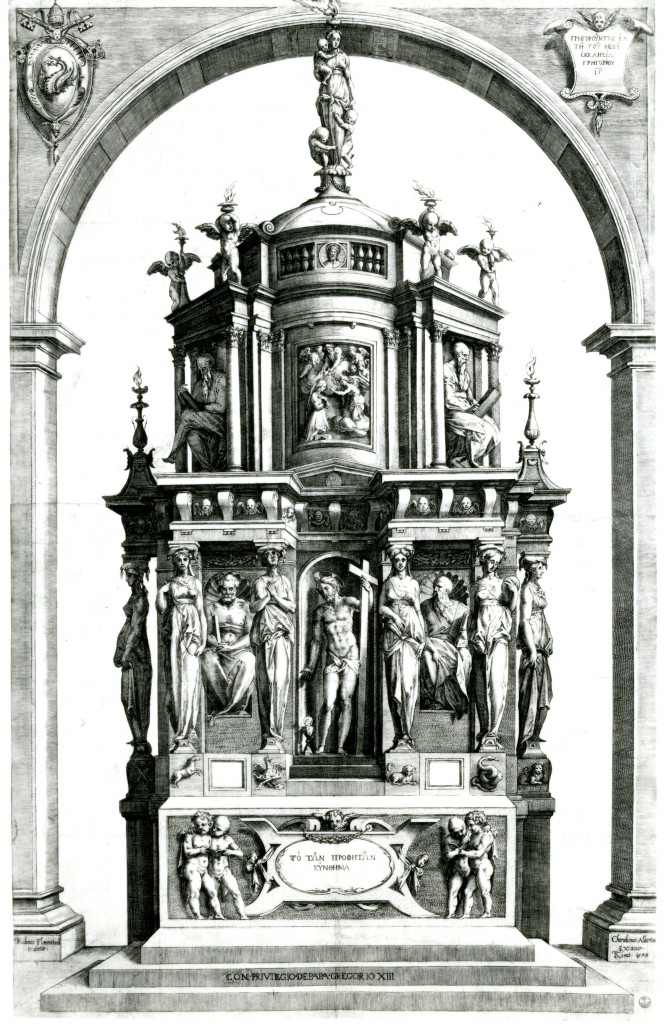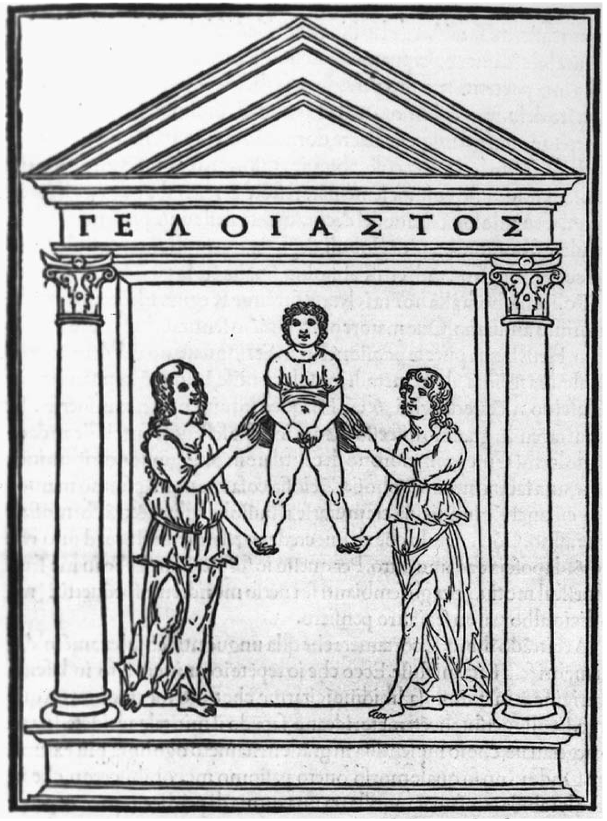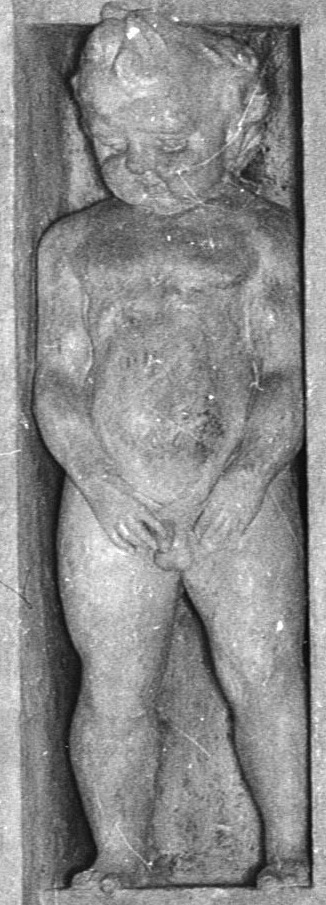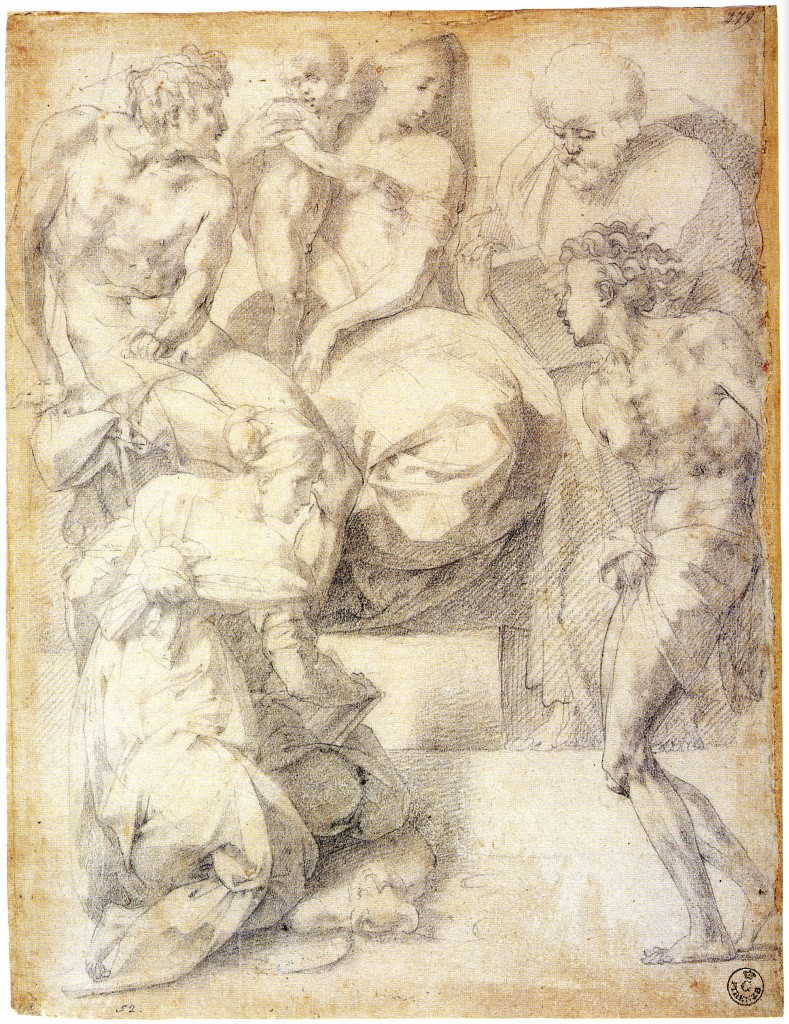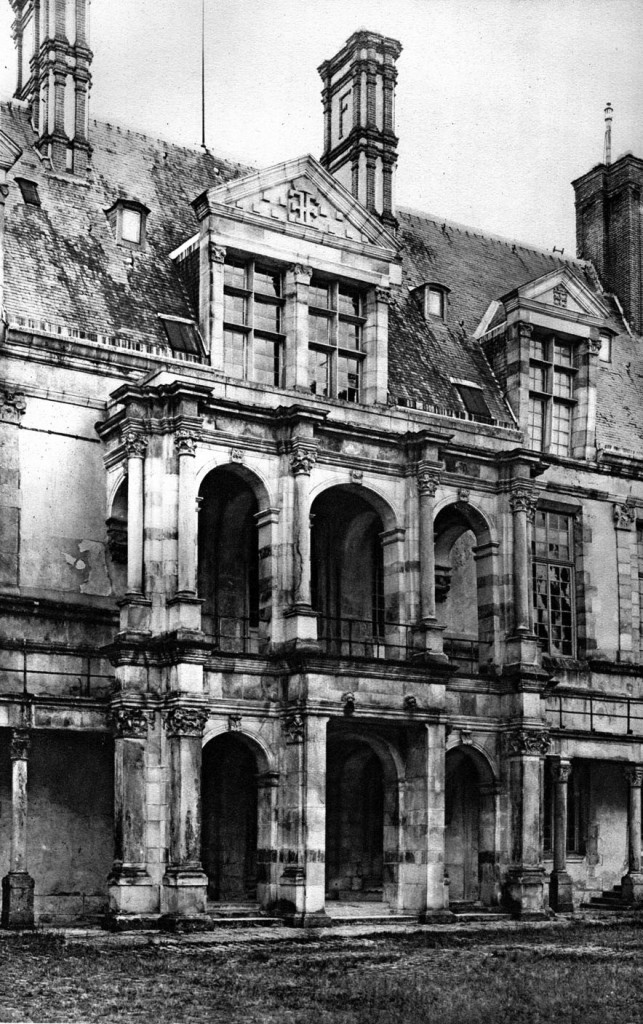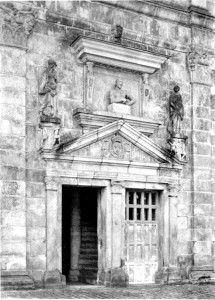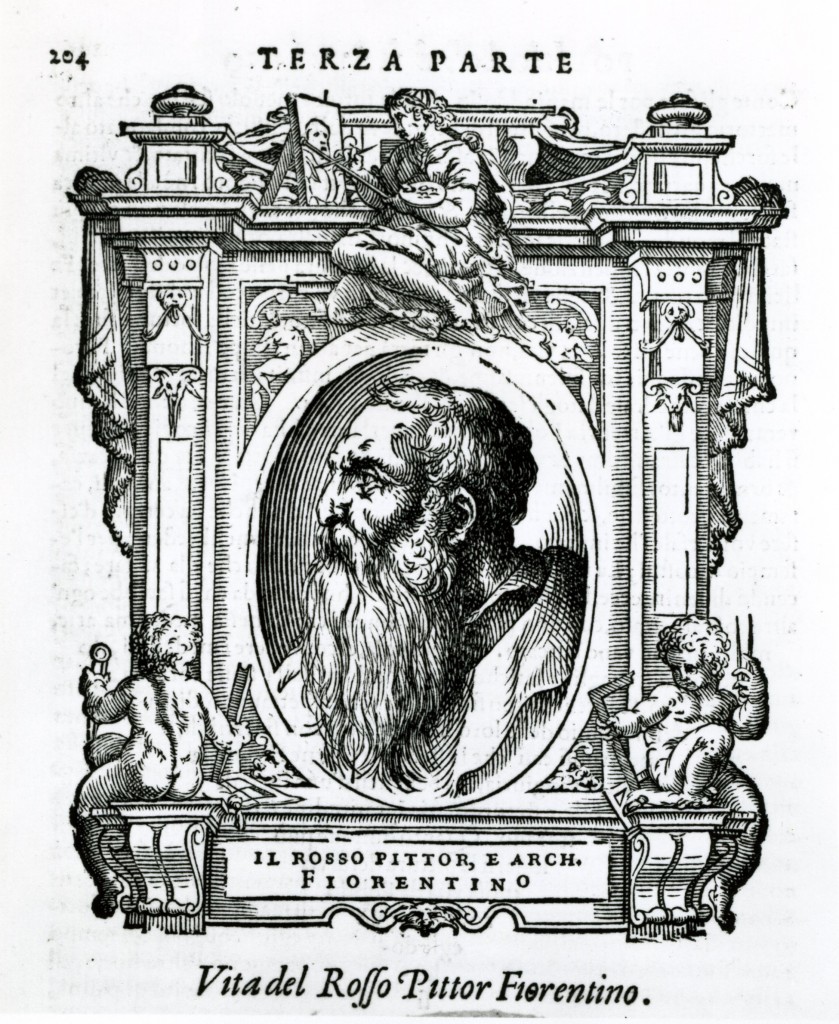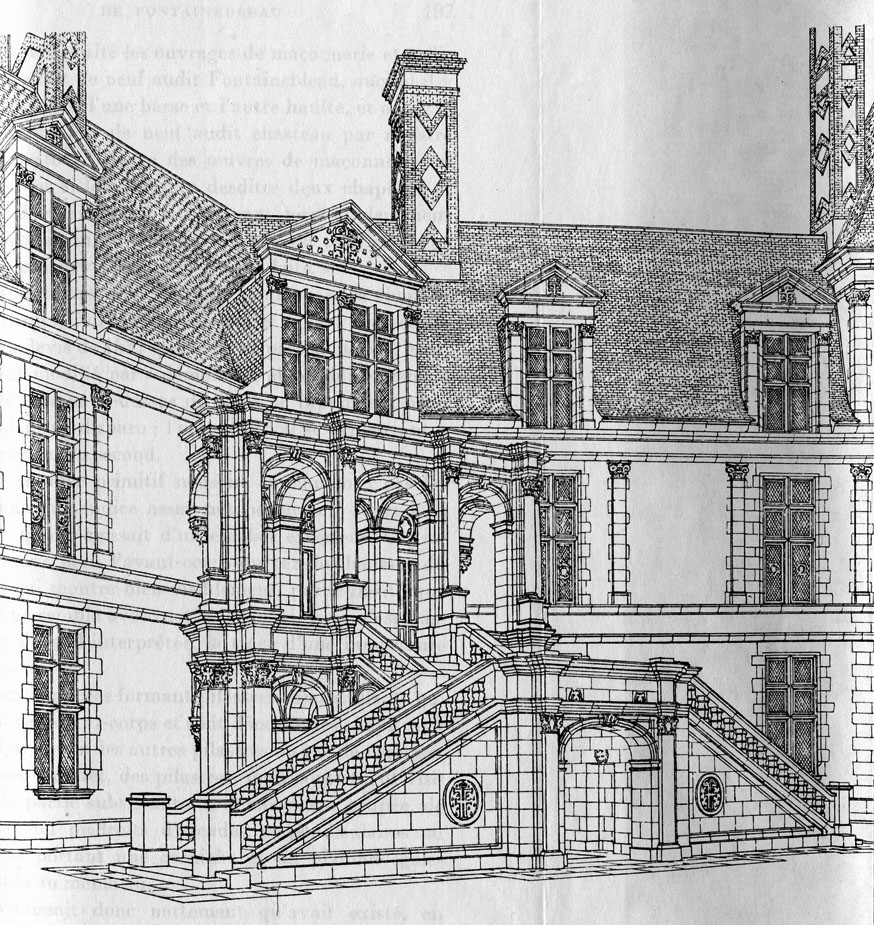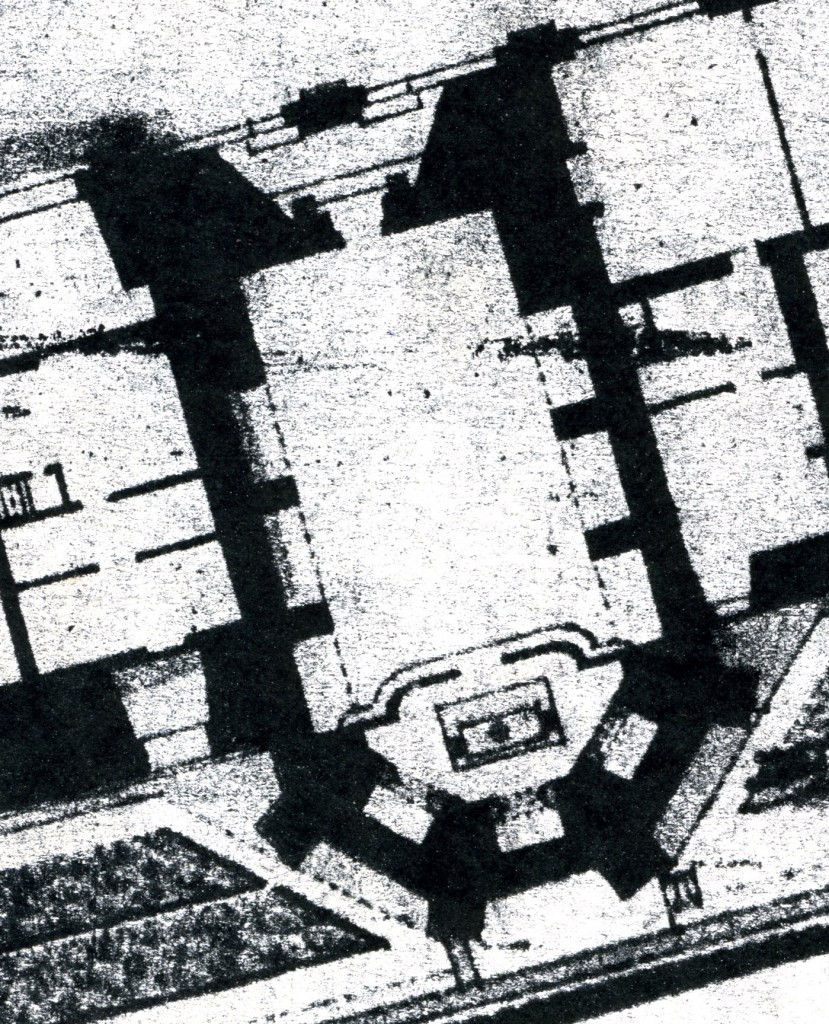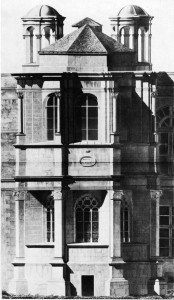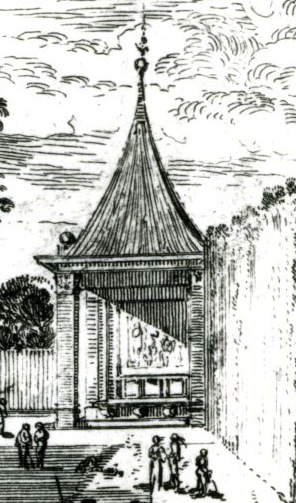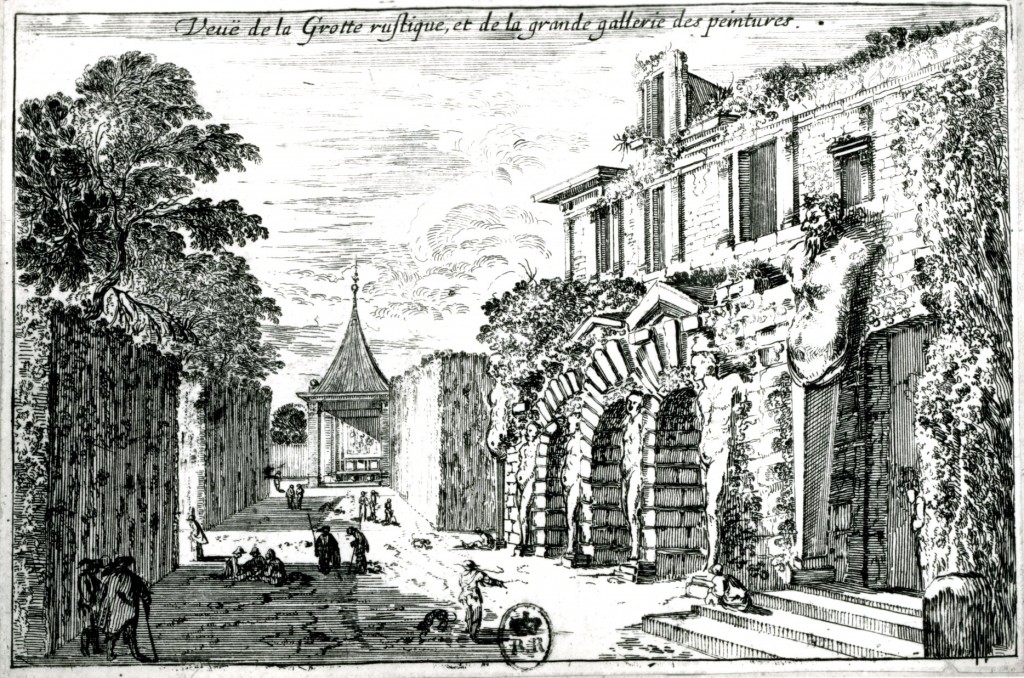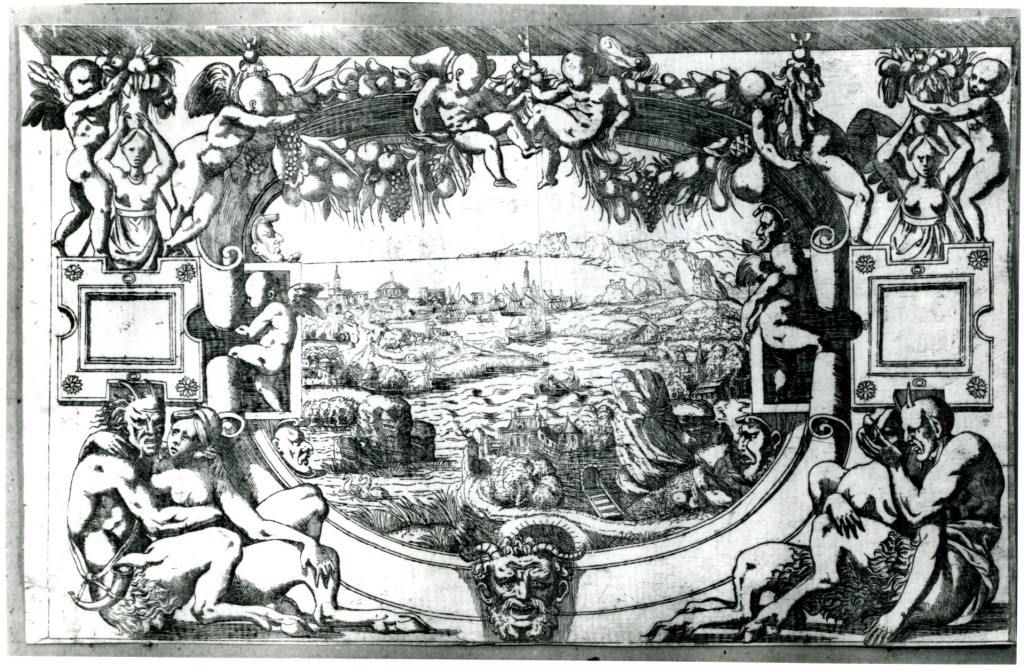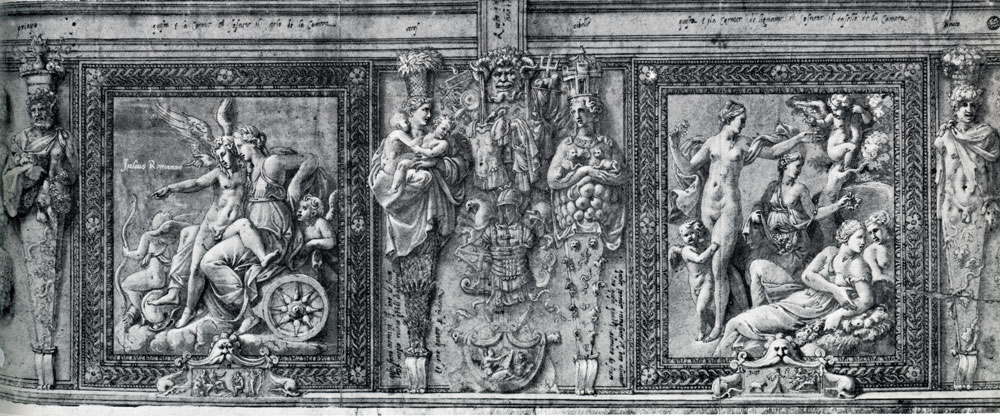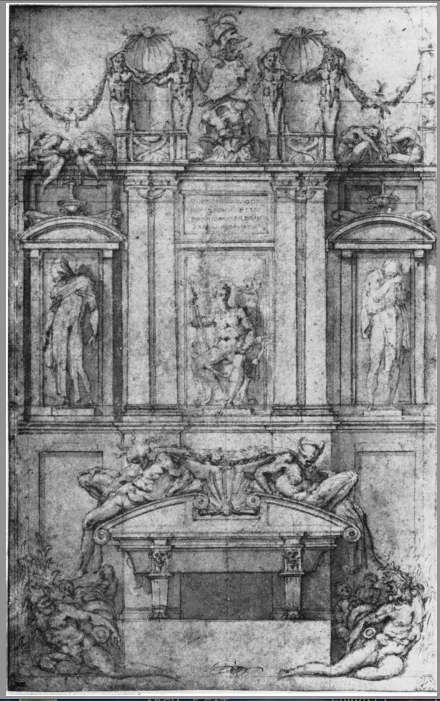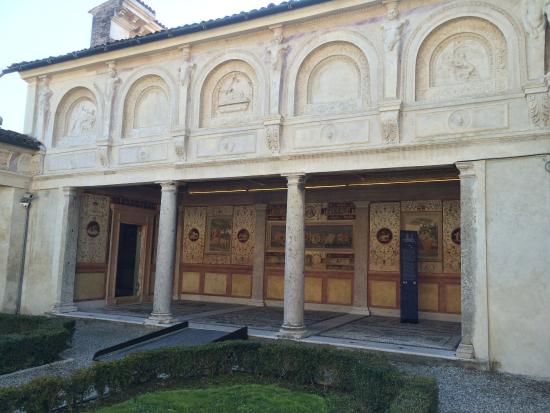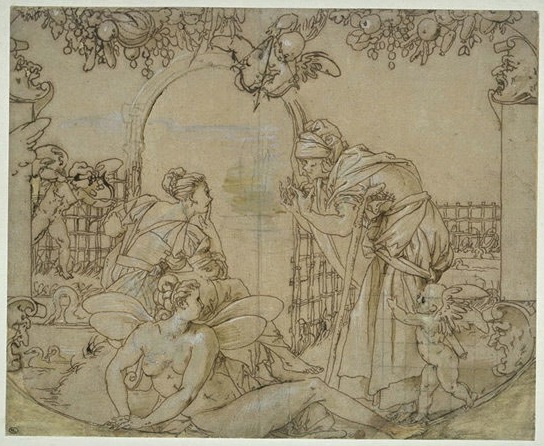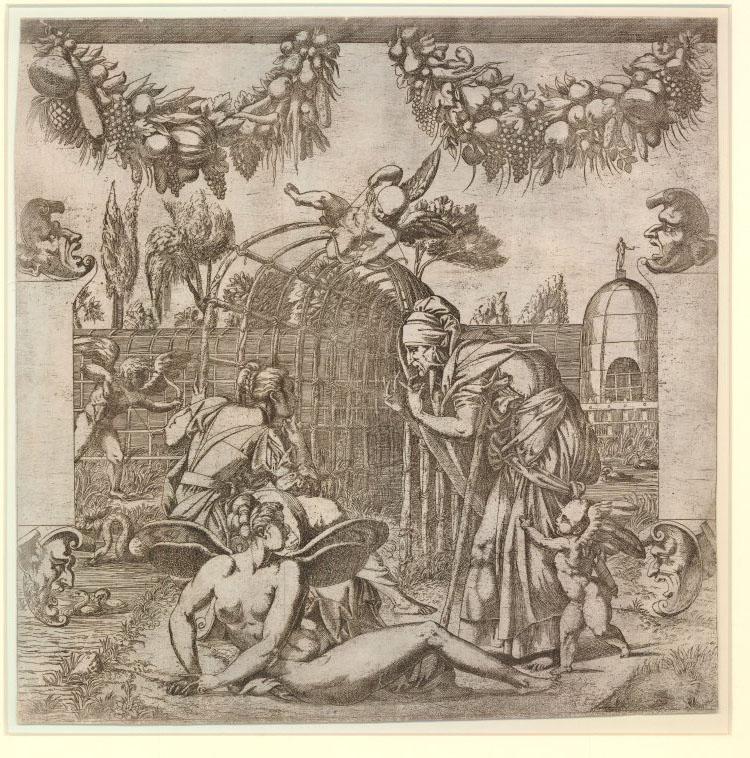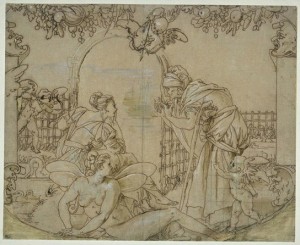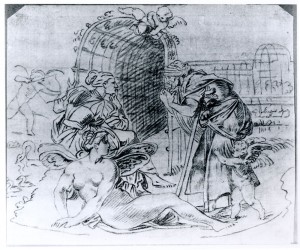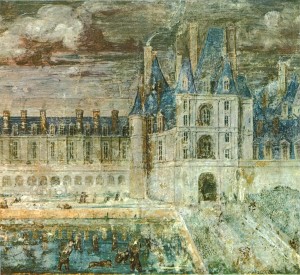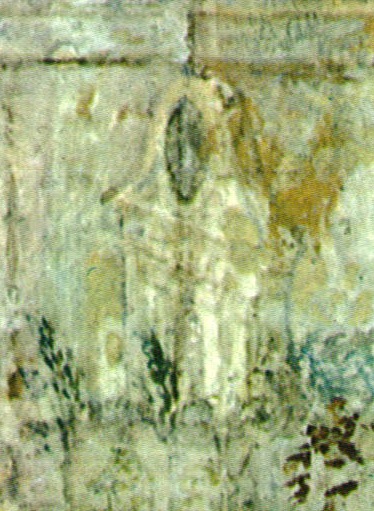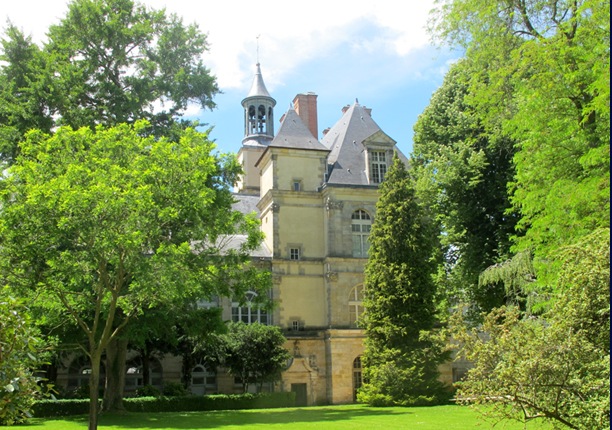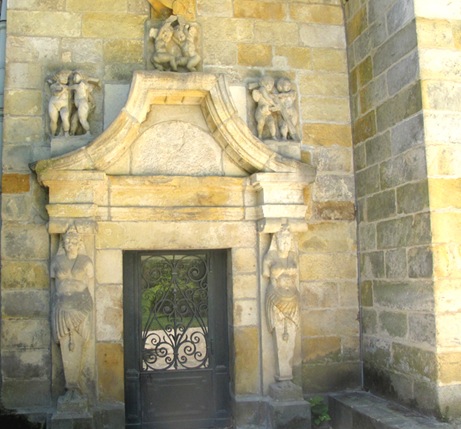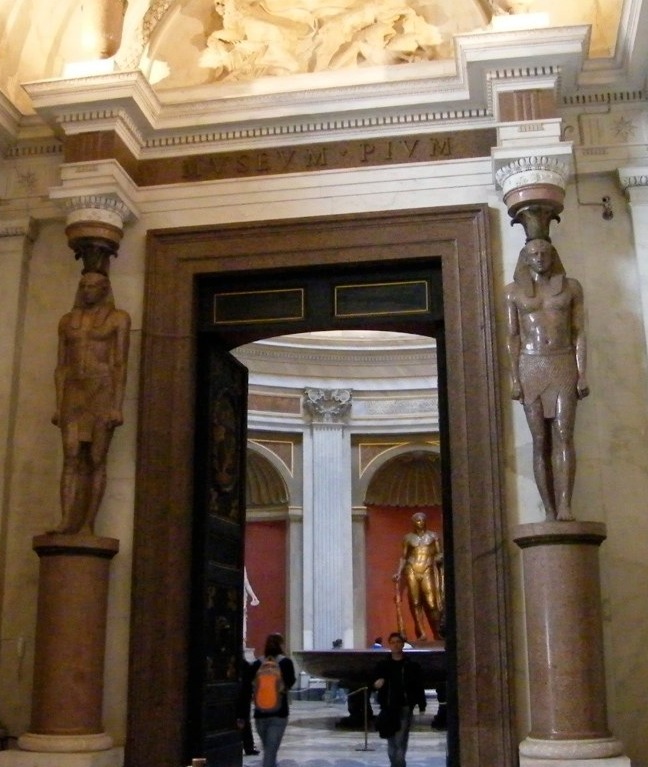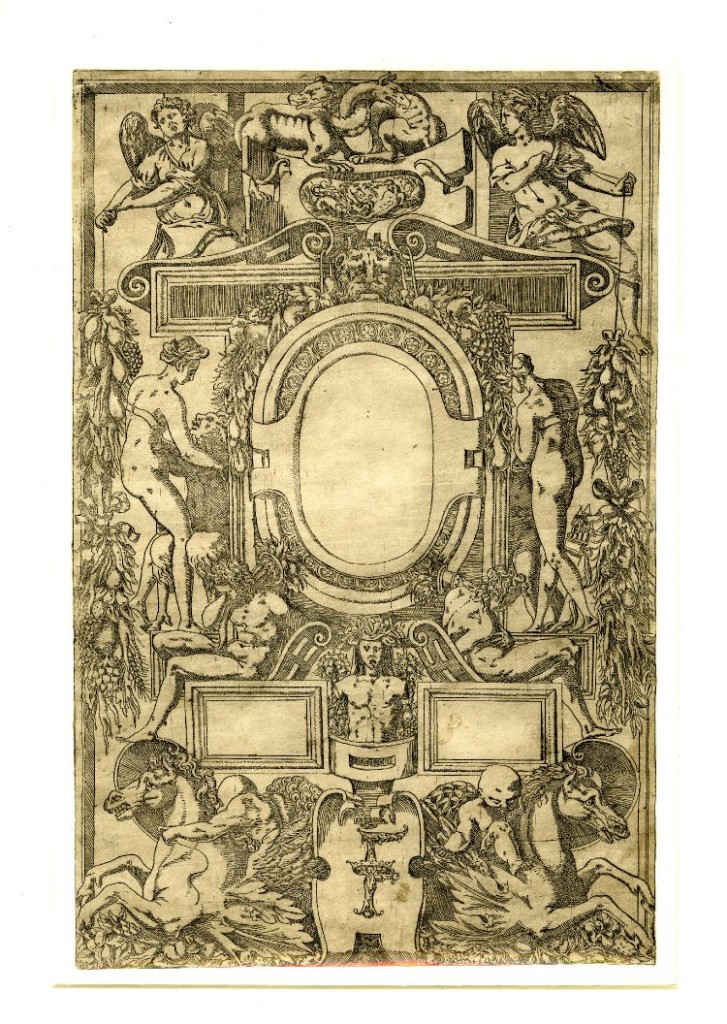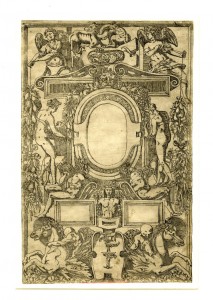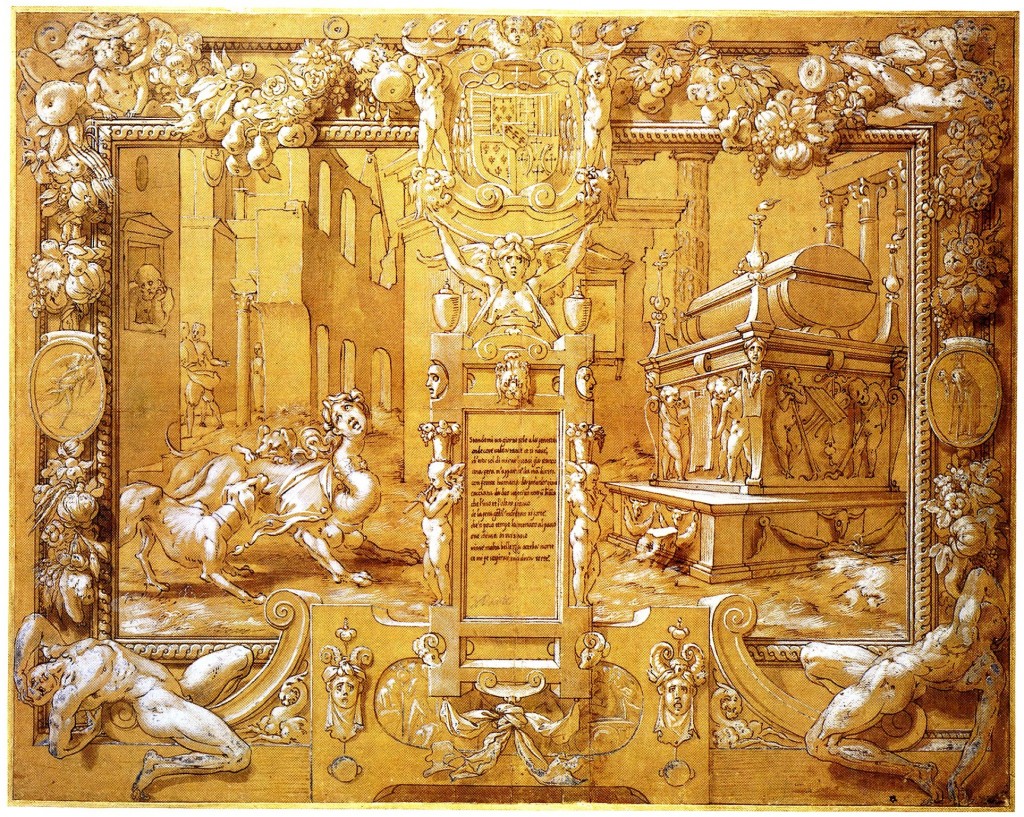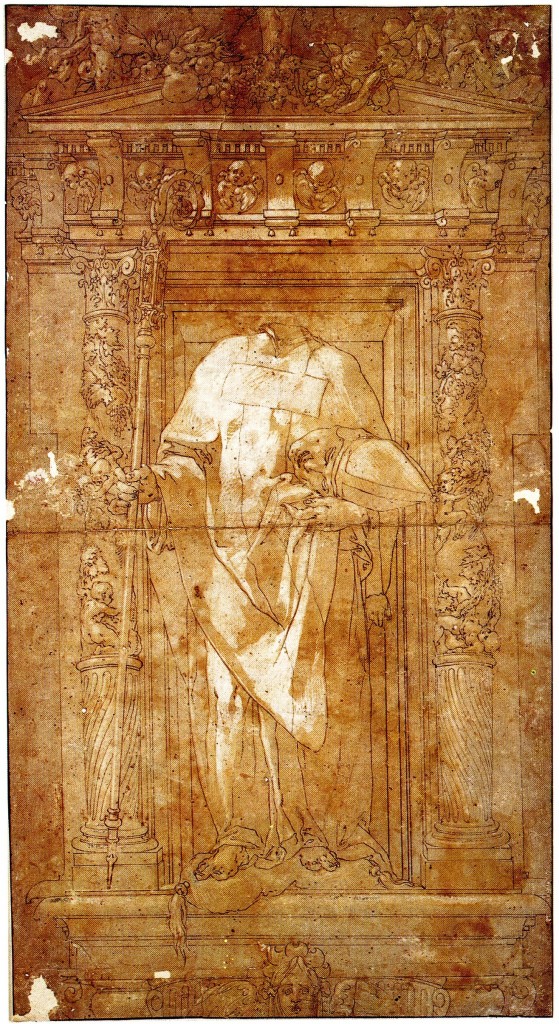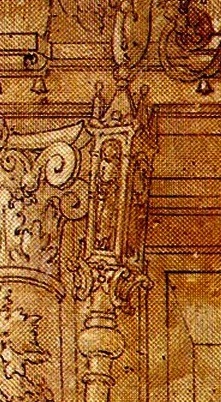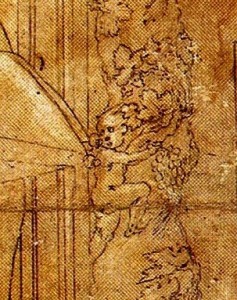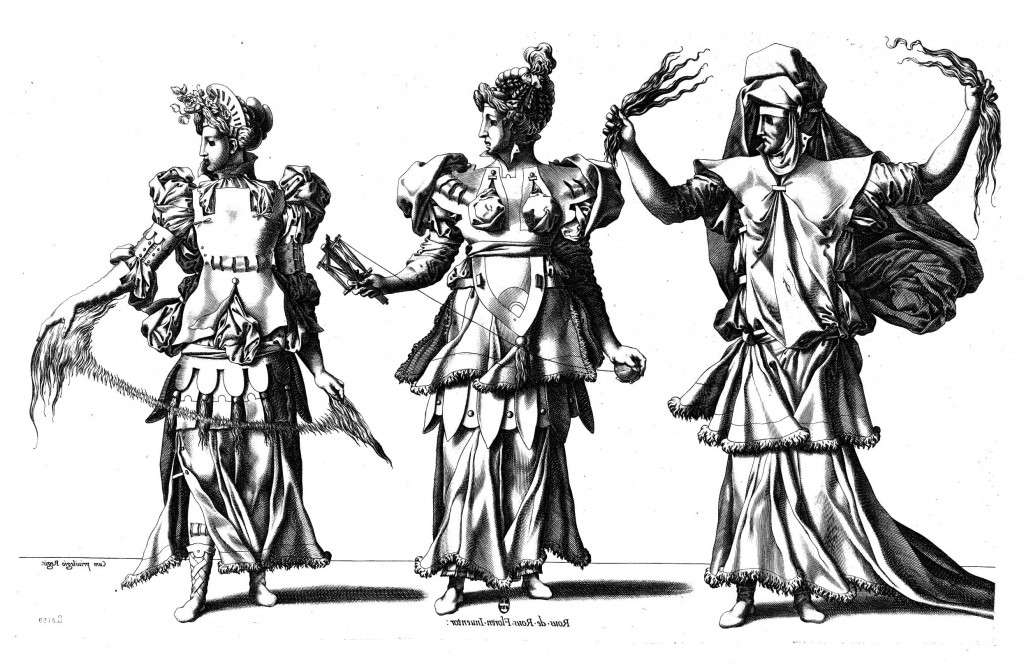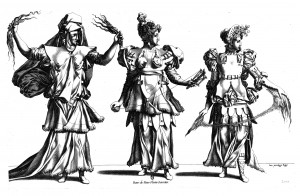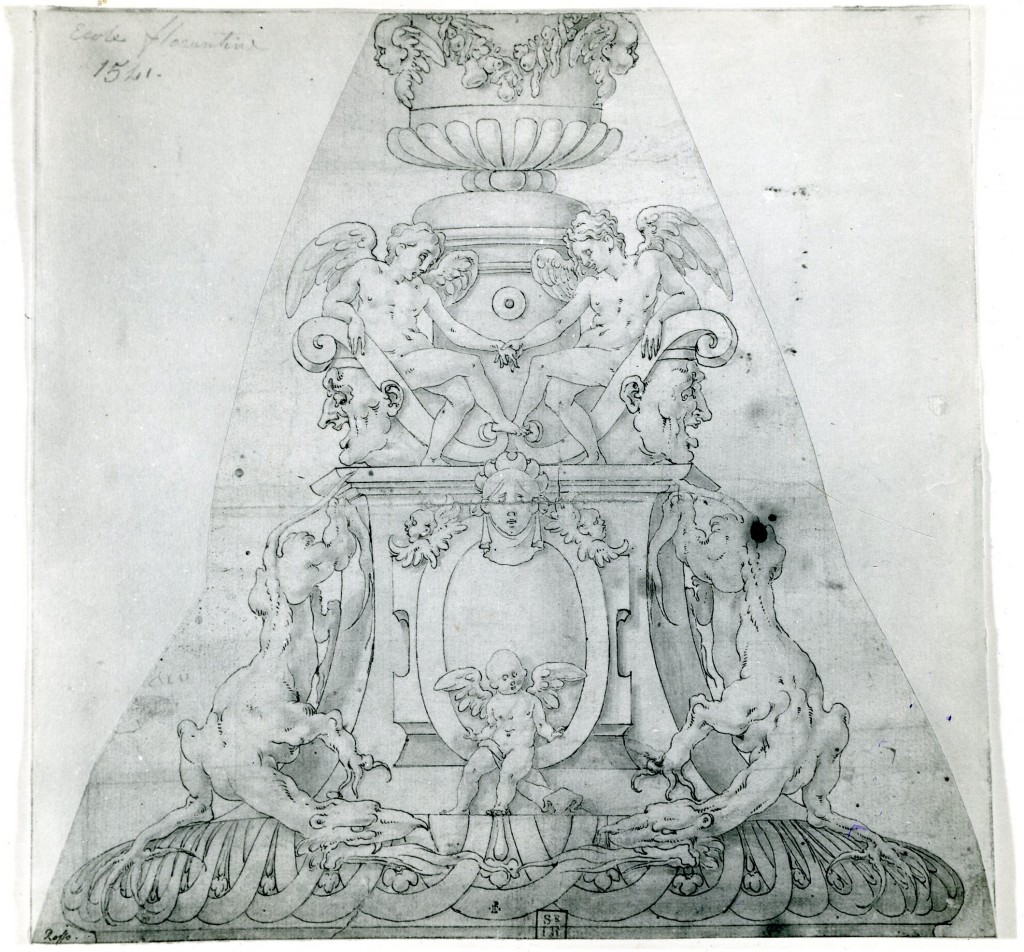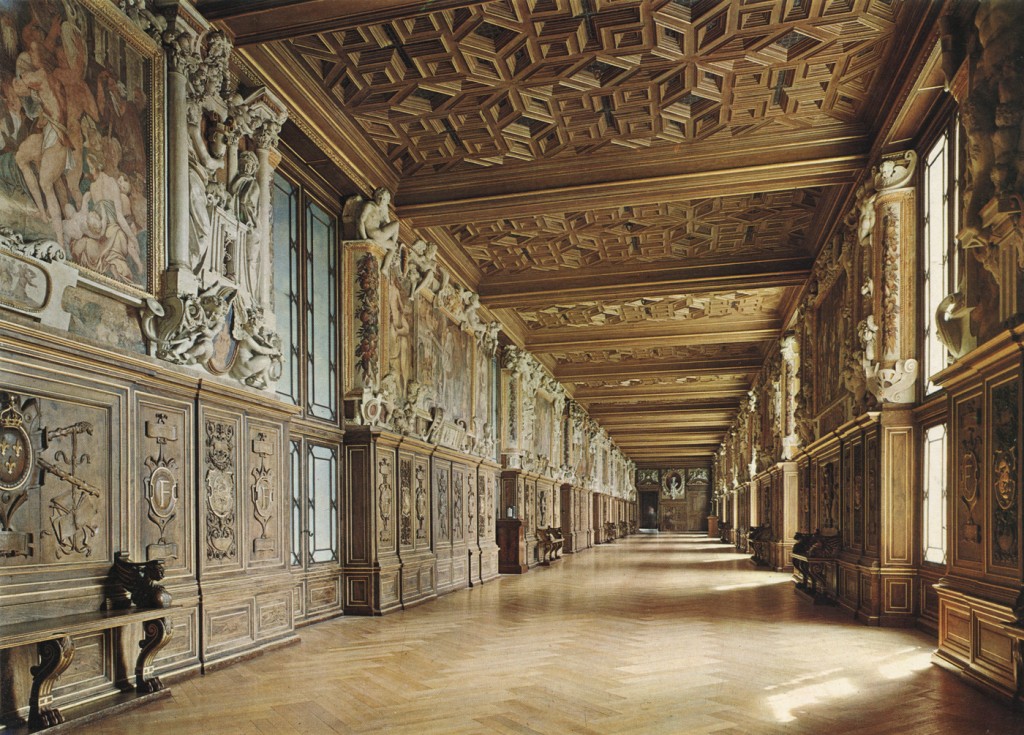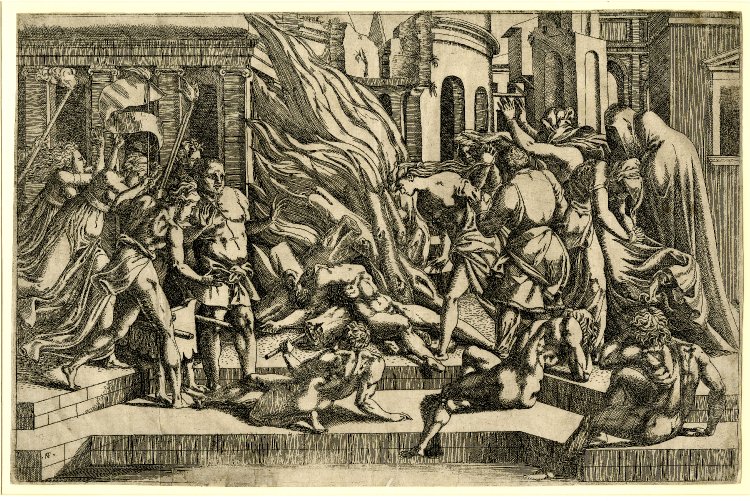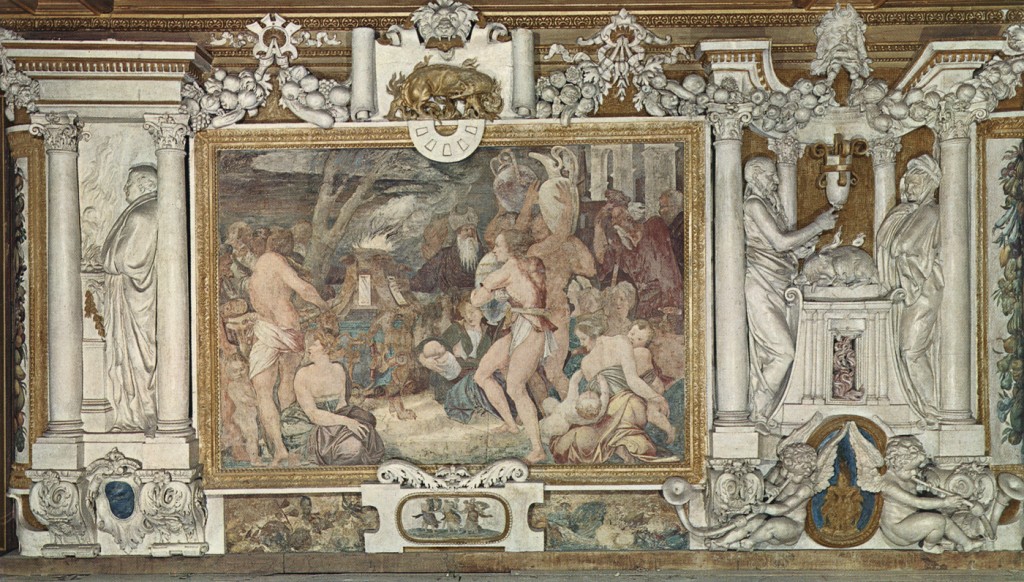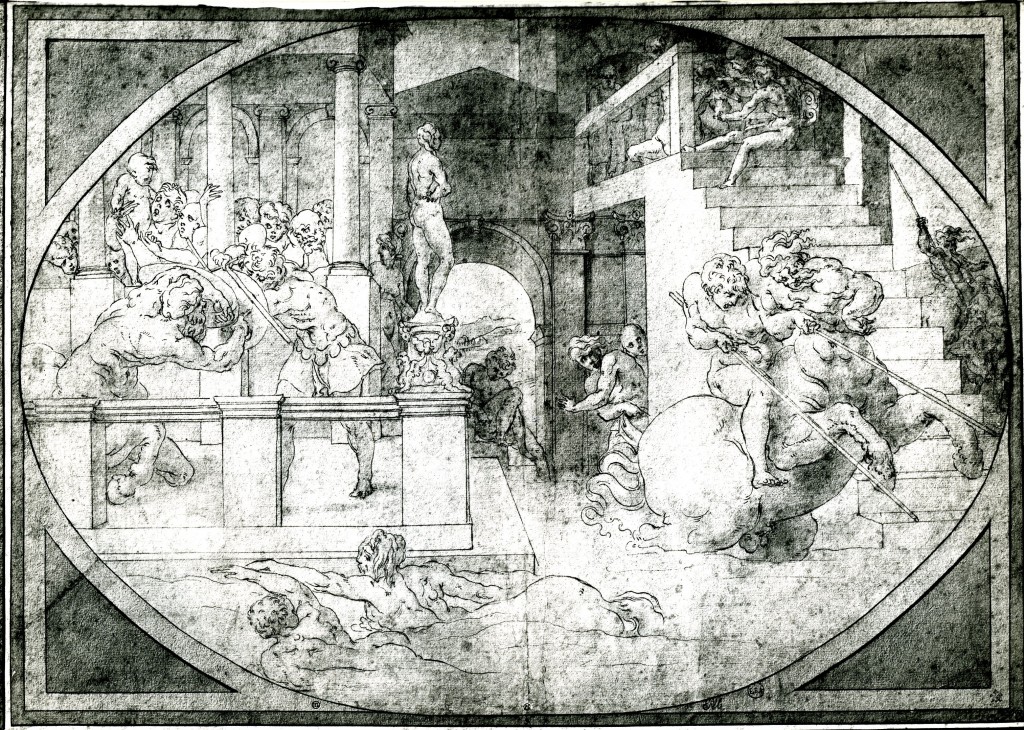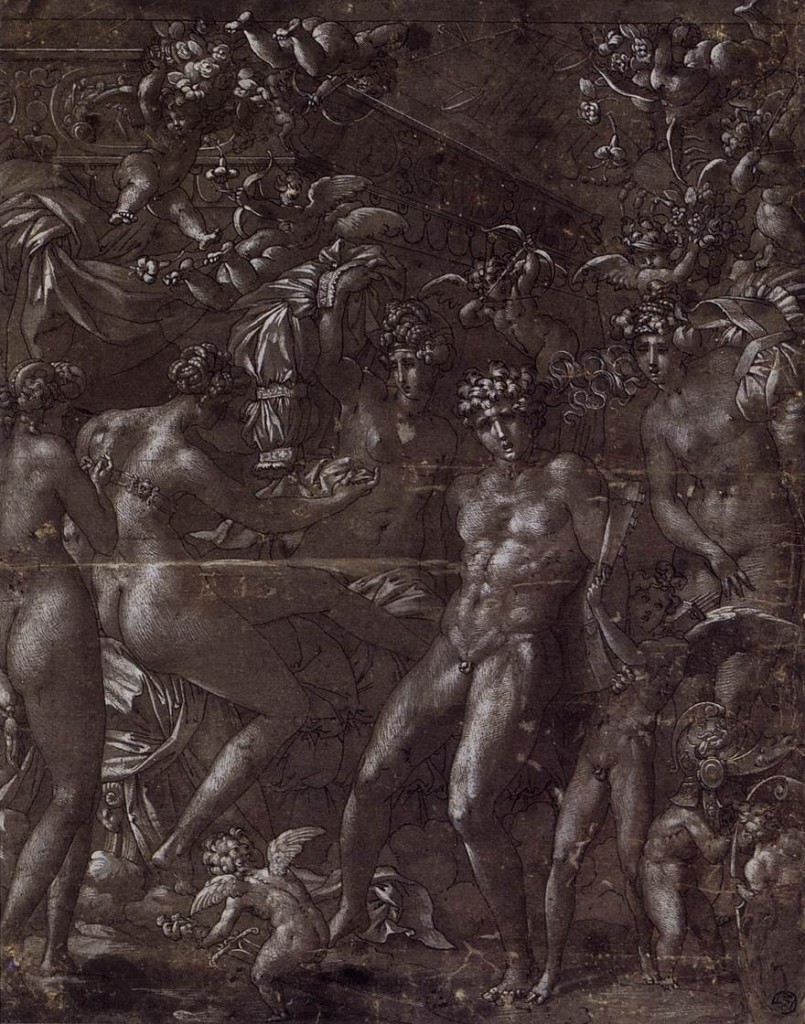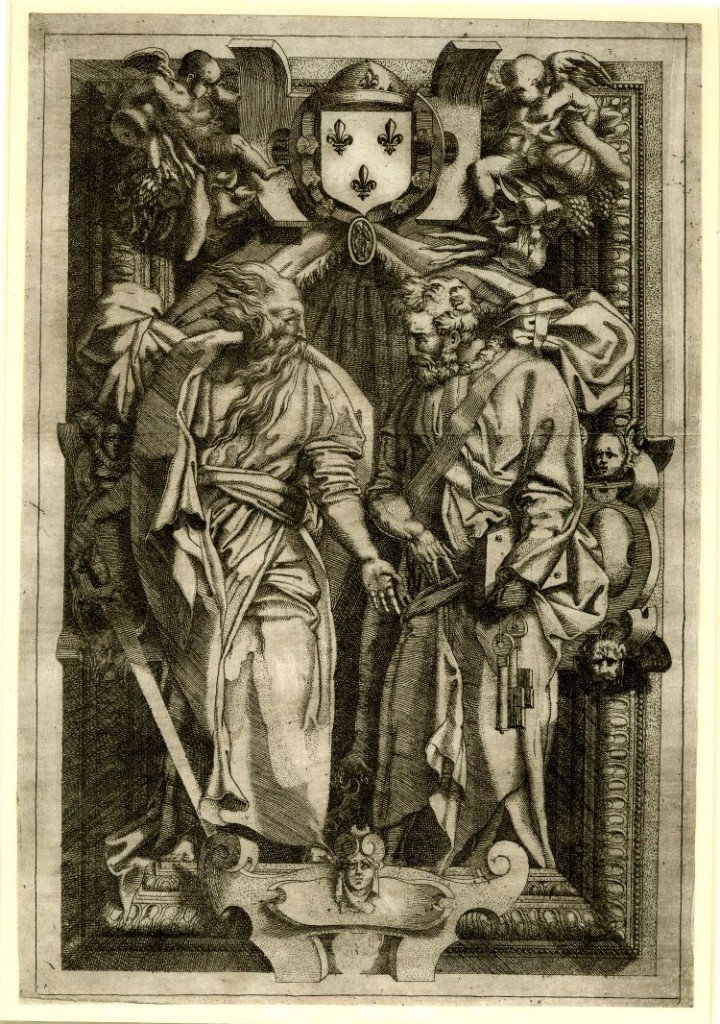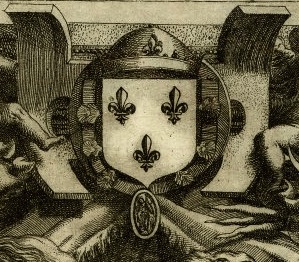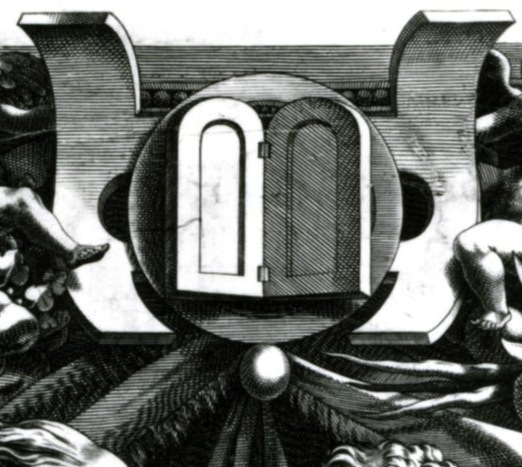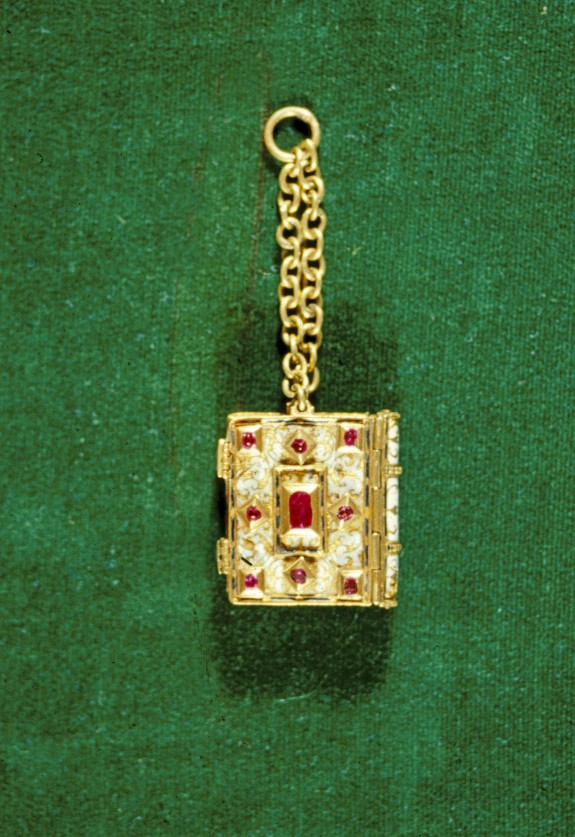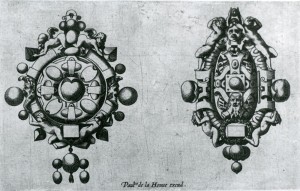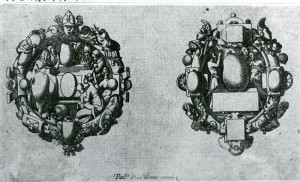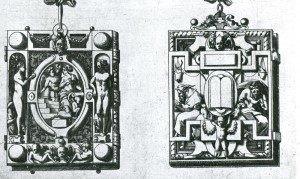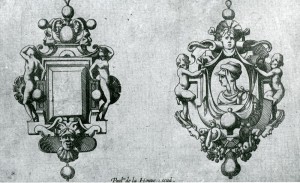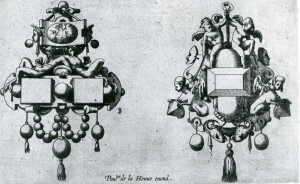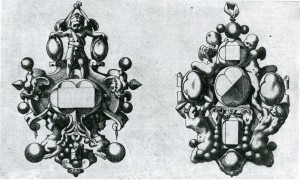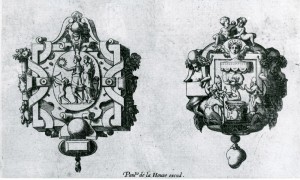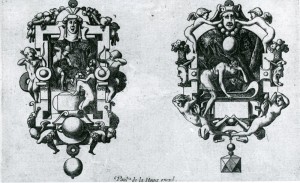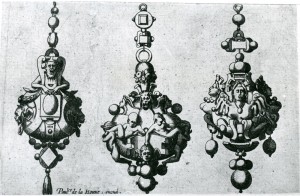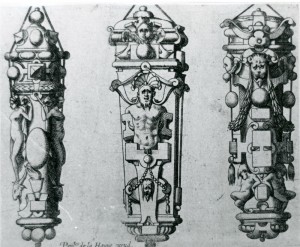“The theme of the [Mars and Venus] together with the identity of its recipient [Francis I] and the context of sophisticated culture, stimulated a recollection of the manner Rosso had used in his designs for mythological engravings in Rome, but he has infused this with the brittle brilliance of his re-won Toscanità, and with a higher stylization, elegant as well as precious, of the theme and form. The drawing attains the precise style that Rosso was to employ at Fontainebleau, …
“The temperament that bred Rosso’s radicalism, however, also made his art so personal and extreme that, despite the power of its invention and ideas, it lay towards the periphery of the main historical development. In France there was no historical framework to which Rosso’s art referred; it was his art that created it for the subsequent French sixteenth century.”1
Sydney J. Freedberg, Painting in Italy 1500–1600, 1971
Rosso’s career in France presented no more of a clear sequence of events than was presented by his varied and sometimes contradictory activity in Italy. Although it might be supposed that his support by such a grand patron as the king of France and his removal from the important artistic centers of Italy would have channeled his talents into a consistent manner of expression—a view that seems vaguely held about Rosso’s work during his years in France—the surviving evidence indicates that such was not the case. The opportunity and inclination to shift from one artistic mode to another and from one kind of emotional expression to another continued. And now, it appears, Rosso could even more freely invent without the threat of censure. For he alone was bringing the grandness of Italian art to France and no one there had the comparable artistic knowledge to judge his performance. At the same time, however, his artistic expression underwent a process of maturation that followed through the new and sophisticated tenets it had acquired in Rome and that, to a limited extent, was modified in the Umbrian and Tuscan towns to which he was confined before his departure for France. While the changes to his art, since 1524, tended to reduce its emotion and frequency of stylistic change, in France Rosso’s art eventually assummed again some of its pre-Roman feeling and range of expression.
The visual evidence of Rosso’s French career is extensive. It is largely in the form of prints and drawings, which must be considered to the same extent as the sculpture and paintings in the Gallery of Francis I at Fontainebleau and his two surviving French easel pictures in Paris and Los Angeles. There is also the evidence of his activity as an architect of lost and surviving buildings. All of this material supports Vasari’s claim at the beginning of his biography of Rosso of 1550 that, “la gloria di lui [in France] pote spegnere la sete in ogni grado di ambizione, che possa il petto di qual si voglia artefice occupare.” Vasari went on to say that, “sopra un’altro del suo mestiero, da si grand Re come è quello di Francia, fu ben visto, & pregiato molto.”2 At the end of the enlarged biography of Rosso published in 1568 Vasari added that when the news of Rosso’s death was taken to Francis I, “senza fine di dispiacque, parendogli aver fatto nella morte del Rosso perdita del più eccellente artefice de’tempi suoi.”3
The earliest reference of Rosso in France places him there in November 1530. Vasari wrote that Rosso went to France from Venice, which it can be safely assumed was the last place of his artistic activity in Italy.4 The iconography of the Mars and Venus drawing in the Louvre—the drawing, in all likelihood, that Vasari said Rosso made in Venice—supports the probability that his French career was indeed launched from that city with the help of Aretino who “in 1529… attached himself to the circle of scholars and artists formed by Lazare de Baif, the French ambassador to Venice.”5 Lazare de Baïf, who was to be contacted from France on Rosso’s behalf a year or two later (DOC. 14), may very well have had a role in Francis I’s decision to call Rosso into his service.6 That the king himself called the artist is specifically stated in the letters patent he received from Francis I in 1532 (DOC. 24). It was Baïf who had written to Francis in October 1529 to tell him of the possibility of attaching Michelangelo to his court at the moment that Michelangelo, in flight from Florence, was in Venice and thinking seriously about going to France. However, he left Venice and was again in Florence around 20 November, 1529.7 At this time Rosso was in Borgo Sansepolcro, having fled from Arezzo in mid-September.
In the 1568 edition of the Vite, Vasari says after his comments on Rosso’s activity in Sansepolcro: “Ora avendo egli sempre avuto capriccio di finire la sua vita in Francia, a tòrsi, come diceva egli, a una certa miseria a povertà, nella quale si stanno gli uomini the lavorano in Toscana a ne’paesi dove sono nati, delibera di partirsi; ed avendo a punto, per comparire più pratico in tutte le cose ed essere universale, apparata la lingua latina, gli venue occasione d’affrettare maggiormente la sua partita;” whereupon follows Vasari’s story about the argument with a priest on Maundy Thursday and Rosso’s flight … “facendo la via di Pesaro, se n’andò a Vinezia.”8 Because Vasari wrote “come diceva egli” there is reason to believe that he is recalling sentiments about misery and poverty that Rosso actually expressed to him in 1528 in Sansepolcro and Arezzo.9 At the same time, he may also have learned from Rosso of his “capriccio” to spend the remainder of his life in France. That he actually was preparing himself for a career in that country, as further suggested by Vasari’s remark that Rosso was educating himself for such an eventuality, seems, very possibly, also indicated by the nature of several possessions that Rosso left behind in Arezzo in 1529: “uno Plinio legato in assi”, “uno Sepontino legato in assi” [referring to Niccolò Perotti, Archbishop of Siponto, and hence probably to an edition of his Latin grammar, Rudimenta grammatices], “uno libro vocato ‘il Cortiggiano “‘, and “uno Victruvio sciolto” [Vitruvius’ On Architecture] (DOC. 13). Castiglione’s Il Cortegiano had only very recently, in 1528, been published for the first time by Aldus in Venice. As it is possible that Pietro Aretino, who might have met Rosso in Rome in 1524 or 1525, was in correspondence with him when he was in the former’s native town, it could have been Aretino who had sent Rosso a copy of Castiglione’s book. A relationship between these two men before the spring of 153o would account for Rosso’s trip to Venice to see Aretino as a means to gain employment by Francis I. On his way he would have stopped at Pesaro not to seek employment but to see what artistically was going on at the Villa Imperiale—not unlike what would be required at the château at Fontainebleau, at this moment in the process of being enlarged. Later, on his way from Venice to France, he could easily also have stopped at Mantua to see what Giulio and his young assistant Primaticcio were doing at the Palazzo del Te.10
Arriving in Venice, probably at the end of April 1530, it was only six months after the time that Baïf had written to Francis I about Michelangelo, who, however, was on his way back to Florence before the king’s reply was received. Consequently, the spring and summer of 1530 were very much the time for Aretino to push his advocacy of Rosso.11
What may have been a “capriccio” of Rosso’s in 1528, or even earlier, could have already become a more substantial possibility in Arezzo in 1529 through Aretino’s solicitations. If such was the case in 1529 it might be another reason, in addition to the one mentioned by Vasari that Rosso “fu sempre nemico del lavorare in fresco”, for Rosso’s dilatoriness in Arezzo over the S. Maria delle Lagrime project. The possibility of his leaving Italy could also account for something of the slack character of some of his later Italian inventions. It might, too, partly account for the changes of the Christ in Glory from the complex composition seen in the early drawings to the rather rigid symmetry of the finished picture. One cannot help but wonder again why specifically Rosso did not, after Rome, settle again in Florence. He sought instead employment elsewhere and yet a man of his talents and background might be expected not to stay for long at the peak of his powers in the limited environments of Borgo Sansepolcro, Città di Castello, and Arezzo.
The attenuation of Rosso’s talent, if such is what can partially be recognized as an element in a few of his late Italian works—and at this moment it is sometimes talent more than genius that seems to be an issue here—was not to remain for long a condition of his art. Certainly the stylistic brio of the Mars and Venus drawing gives evidence that Rosso’s powers of artistic inventiveness were not seriously impaired for long. The artistic character and quality of this drawing are, in spite of the difference of subject, identical to those of his Pietà in Borgo Sansepolcro. There is in the drawing some of the same distancing of real emotion and the same kind of replacement of the latter by studied rather than felt poses and gestures. Whatever these may mean in the Pietà, in the Mars and Venus, destined almost certainly for Francis I, they would have conveyed and signified to the king something of the range and quality of Rosso’s talent without, however, revealing to the French monarch what deeper and more passionate concerns had been at times the substance of Rosso’s art.
UNE GRANT TABLEAU
The earliest document concerning Rosso’s residency in France that records payments to him “pour son entretenement” in Paris from November 1530 though July 1531 states also that “durant lequel temps it a fait ung grant tableau pour le Roy (L.45).” Francisque Scibec de Carpi was paid for making the wood frame for this picture and Jehan Poulletier for the gilding of it between 8 and 17 July. In addition “Archangelle de Platte” was paid “pour ung voiaige dudict Fontainebleau à Paris, pour faire venir led. tableau.” It can be concluded from this information that Rosso’s large picture was painted in Paris and sent to the king who was living in Fontainebleau in July and August 1531. Unfortunately, the subject of this picture is not mentioned but we know that Rosso was again active as an artist soon after his arrival in France, and that he was occupied with a commission for an easel picture, which, though executed in Paris, was sent to Fontainebleau. There is no evidence, however, that this framed painting was made for any decorative scheme at Francis I’s château.
JUDITH
It would have been about now that Rosso painted the lost Judith (L.35) that is known from an engraving by Boyvin. This print almost certainly reproduces, in reverse, the composition of the panel picture that Cassiano del Pozzo saw at Fontainebleau in 1625 and which he described as “grande poco men del vero”. Given this remark, and what we see in Boyvin’s print, the lost Judith must have been almost a meter and a half high by around a meter wide. It could, therefore, very well have been the “grant tableau” that Rosso made for the king in 1530–1531, and for which Scibec de Carpi carved a frame that was then gilded.
Stylistically the Judith, as we can judge it from Boyvin’s reproduction probably made from a lost drawing by Rosso for his picture, so closely resembles the Mars and Venus drawing that very little time could have separated the creation of these two works. The picture must have fulfilled in painting what Francis I would have expected of Rosso from the drawing made just before he arrived in France. But, as the style of that drawing was itself not absolutely novel in relation to the style of Rosso’s earlier art, so too the Judith has close stylistic precedents in Rosso’s late Italian works. The young heroine in the engraving corresponds to the woman in the drawing in Rome for the Christ in Glory and to Eve in the Uffizi Allegory of the Immaculate Conception made for S. Maria delle Lagrime. In all likelihood the execution of the Judith painting was very much like that of the Città di Castello altarpiece.
What the Judith shares especially with the Mars and Venus is the particular elegance of elongated proportion paired with graceful limbs and posture of its figures. There is also in both an expression of almost painful seriousness. Judith, standing in back of a parapet, derived possibly from Venetian art,12 and under the parted curtains of what is probably meant to be Holofernes’ tent but also serve as a canopy for the figure of Judith. Behind her can be glanced the drapery of Holofernes’ bed. Judith holds his severed head at arms’ length, a head so small as to prevent too vulgar a reference to the actual horror and heroism of her act. Yet, compared to the richly filled and complexly composed Mars and Venus, the Judith is a simpler and even a more eloquent work of art. While this is partly true because it presents but a single figure and also, in its greater simplicity, very probably because of Boyvin’s reduction of the fine nuances of Rosso’s original drawing for his painting, it is nevertheless observable that the spacing of the elements in the Judith also reveals a clarification of style of the Mars and Venus. The rumpled curtain on one side of the composition complements the drama of Judith’s glance and gesture of holding Holofernes’ head. The other curtain, pulled straight, meets the oppositely slanted diagonal of the sword that Judith holds, the hard and pointed character of which heightens the supple appearance and grace of her extended parallel arm. It is possible that the forms in Rosso’s drawing were plastically fuller and more continuous than in the Venetian drawing, although this apparent difference may have been, partly at least, provided by Boyvin’s engraving.
For the fullest understanding of the picture Boyvin’s print must be reversed. In this direction Judith holds the sword in her right hand making it the major symbol of the picture. It is gently held in her hand without any indication that it had been used in the violent decapitation of Holofernes. She looks with distain at Holofernes small head set at the far right upon the ledge before her. The tip of her large sword touching this ledge near the center of the picture gives a sense of poignancy to the image but, again, not of violence. Although without the representation of the actual narrative of the beheading of Holofernes the story implied to the knowledgeable viewer in all picture’s details. Judith’s coiffure may still reflect a recollection of Michelangelo’s and Rosso’s own teste divine but it seems here more exotic to further indicate that, as told especially in St. Jerome’s version of the Book of Judith in the Vulgate, that she had prepared for her visit with Holofernes in a seductive manner not those of a devout and modest widow. The light on her left breast, almost at the very center of the composition, and the very evident nipples of both breasts suggest the sexual encounter that lay behind Judith’s intentions.
It is with clear intentions that what may be Rosso’s first work for Francis I is an image of a woman, and of Judith, both beautiful and brave as the defender of her people. The sexual allure of Judith would be anticipated to please Francis as would the indication that she is the savior of her people. The subject could also have been intended to supplant the image presented by Rosso’s Mars and Venus of a hero too under the sway of a woman’s amorous intentions.
But Rosso’s is a rare image of this heroine, “rarely seen in French literature before the sixteenth century” or in the visual arts in France. Images of Judith of the sixteen century in France do not appear in any of the fairly numerous recent publications on her although some as stained glass windows can be found online (at judith2you).
[Fig. Church of St. Martin, Triel-sur-Seine]
Around 1500 Judith was the subject of a theatrical drama attributed to Jean Moliner, Le Miroir des vefves; Tragédies sacrée d’Holoferne & Judith and appeared in collected biographies of famous women such as one by Alfred Dufour in 1502. Already in the mid-thirteenth century Judith was identified with the French monarchy in forty panels of a window in Sainte-Chapelle in Paris devoted to her story as part of the narrative of sacral kingship. But her royal appearance at Sainte-Chapelle has not yet been studied in its subsequent importance and Rosso’s depiction of Judith appears unprecedented in France.
[Center Fig.Judith and Holofernes,Sainte-Chapelle]
But in Florence the heroine as savior of her people was a frequent subject of art and could have been easily recalled by Rosso and other Italians at the French court when the artist was seeking a subject for his painting. There is every reason to conjecture that he knew the depictions of Judith’s story in the panels at Sainte-Chapelle and became aware of their importance in his need as painter to the king to identify with the French monarchy. Judith was also seen as defender of the Faith and became a symbol of it in the later sixteenth century for both Catholic and Protestants. What seems to be the earliest French work by Rosso shows him establishing his new position as painter to the King of France, already suggested in the Venetian Mars and Venus drawing, and to the French monarchy.
Judith was presented as La Femme Forte in Abraham Bosse’s engraving published in Paris in 1645 in an image that could just possibly reflect knowledge of Boyvin’s print.
[Center: Fig.Abraham Bosse, Judith]
At the time that Rosso executed his “grant tableau pour le Roy” it had been two or three years since the rebuilding of the château at Fontainebleau had been prescribed, in April of 1528, with the construction placed under the supervision of the master mason Gilles Le Breton.13 Rosso’s activity as a decorator there does not seem to have begun until late 1531 or in 1532, although he would almost certainly have become acquainted with the tasks that he would have to face at Fontainebleau immediately upon his arrival in France. It is very probable that he knew where his large framed picture was going to hang in the château even though he may not have actually designed the setting for it. This would be distinct from the frame carved by Scibec for which Rosso could have supplied the design, as later he did for the frame of Michelangelo’s Leda.
Another image engraved by Boyvin, or by someone in his shop, and showing a disputation between Saint Peter and Saint Paul, could also be associated with the rise of the Protestant movement just at the time Rosso arrived in France.
Stylistically the image gives, as in all Boyvin’s engravings after drawings by Rosso that survive, an accurate record of another lost drawing by Rosso done about the same time as the lost original drawing used for Boyvin’s Judith. The forms in the engraved St.Peter and St. Paul have the same kind of emphatic plasticity and similar composition concentration that, however, is increased in the St. Peter and St. Paul by its very restricted space. The pairing of the two saints in conversation and the intensity of their discourse bring to mind Rosso’s Florentine Disputation between Old Men of around 1518 (Fig. D.2). Also that year Agostino Veneziano engraved Rosso’s Disputation of the Angel of Death and the Devil. In the S. Maria Nuova Altarpiece a dispute appears between the young St. John the Baptist and the old and bare-chested St. Jerome. Rosso’s St. Peter and St. Paul presents a return to this aspect of the Florentine years.
In the figure of St. Paul there is also a recollection of his Standing Apostle of around 1529 in the British Museum (Fig.D.36). But there is a stillness and a disembodied quality about that elegant figure that have given way in the figure of St. Paul to a physical and passionate physicality of the two saints that is unlike the planar character of the figures in the earlier drawing. The St. Peter and St. Paul also appears more vigorous than the Judith that is probably slightly earlier in date.
St. Paul, gesturing toward St. Peter (in the lost original drawing with his right hand), would be arguing, with reference to the pair of rounded slaps above that signify the Mosaic Tablets of the Law, his position on issues that were brought up first at what is often referred to as the Incident at Antioch.14 Peter is listening intently, his Keys of the Church appearing in bright light. (Paul’s sword is half in show.) Paul held the position that Gentiles converting from Paganism to Christianity need not be circumcised or follow the dietary laws of the Jews and the Laws of Moses. The main sources of this famous incident are Paul’s Epistle to the Galatians, 2:11–14, his Epistle to the Ephesians, 2: 11–22, and the speech of Peter and the decision of James the Just in the Acts of the Apostles, 15: 7–11, 19–20. Here the law of the commandments is made void and both the Jews and the Gentiles who are converted to Christianity are brought together “that he might make the two in himself into one new man” (Ephesians 2: 15). Also fundamental to the understanding of this Incident is the authority held by the Church of disputation itself. The strength of this authority that goes back to St. Augustine’s original disputation, is enforced by the authority of Rosso’s image. [ADD INFORMATION: see 1530 translation of bible and rise of Protestantism in France]. The engraving gives no indication of a conclusion that is reached by the disputants. In this respect Rosso’s St. Peter and St. Paul could have been meant to offer the viewer a sense of the Church’s ability to face, with the strength of its historic authority and responsibility, the threatening issues of Protestantism. That authority reached a turning point early in the French Reformation when “the king and his courtiers manifested their orthodoxy after the Affair of the Placards,” during the night of 18 October 1534, in a procession held in Paris on 21 January 1535.15 This authority and its orthodoxy may have gathered strength by the publication of the first printed translation of the Bible into French by the French theologian Jacques Lefèvre d’Étaples in 1530 in Antwerp.
The importance of this engraving, or more importantly the lost drawing by Rosso from which it was made, in relation to confronting Protestantism can be seen also in the designs of two pendants referring to the New and Old Testaments, which are actually the covers of miniature books. The cover of the New Testament shows the naked figures of the Temptation of Adam and Eve standing at either side of an Annunciation set in an oval, while the cover of the Old Testament has set at its center the Tablets of the Law with a seated bearded scholar studying a book at either side. The appearance of these tablets to signify the Old Testament has its correspondence in the St. Peter and St. Paul to indicate the context of the disputation that is shown below them. That these small testaments are conceived as pendants seems a remarkable expression of piety of the person who would wear them.16
Zerner pointed out that the St. Peter and St. Paul looks like the design for a relief rather than a painting. The limited space of the composition, as well as its decorative forms and their relationships, could support this suggestion. But the original drawing may have been meant as the model for an engraving, the medium of sculpture imitated instead of illusionistic painting to give a sense of solidity to the concept of the image. However, as a relief, actual or imitated, the design gives evidence of Rosso’s concern with sculpture early in his career in France. In Italy he had given some consideration to the design of sculpture, not only in his pictures and drawings, but in images for actual sculpture. In Florence in 1515 he had designed a triumphal arch that was surmounted by a sculptured group and that also had painted sculptured stucco festoons of pomegranates and pine cones (L.9). Furthermore, we know he was commissioned to design the stucco decoration of the Cesi Chapel in Rome (P.16). The Design for a Chapel (Fig.D.37) is his earliest surviving Italian architectural project that contains sculpture set within it. Only slightly later in the Design for an Altar (Fig.D.38) does he use sculpture more extensively and imaginatively set within the architecture and as architectural elements themselves.
Whatever its ultimate realization, should that even have been a painted imitation of sculpture (as may have appeared on the Florentine arch), the whole conception of the St. Peter and St. Paul is plastic. This includes not only the two figures of the saints, but also all of what might be considered the decorative elements of the composition. Only the fringe on the curtain behind the saints seems pictorial in its definition. The saints are set within but also very much in front of a large rectangular frame made of flat and carved moldings more or less classical in inspiration. Attached to this frame are four large decorative units composed of abstract planar forms and realistic elements. From the unit above, and attached to it presumably by a large bead, hangs the fringed cloth that falls behind the saints and is tied back at the sides. By their size the saints dominate the composition, but the surrounding elements, because of their plasticity, richness, and density have their own artistic emphasis. Not in the least is this true because of their novelty.
The large motif above is composed of a broad lyre-shaped element, the top and bottom of which are bent forward. On this element is placed a large round disk under which is a barely visible flat disk with a beaded rim. Upon this base is set a pair of blank hinged tablets that resemble the Tablets of the Ten Commandments. Flanking this large central motif are two winged cherubs leaning back on garlands of fruits and vegetables. The smaller motifs at the sides of the saints are composed of similarly cut and bent elements with a winged cherub’s head above and a lion’s head below each. Beneath the two saints is another decorative motif composed of fiddlehead shaped volutes, a broad rounded disk bent forward at the sides, and a head with a curled headdress and a cloth hanging down behind it. These decorative elements are unusual and seem little related to the vocabulary of decoration that Rosso would have known in Italy or met with in France. The broad, sharp-edged, curved, and bent forms do not appear strictly architectural in their origins but neither do they seem to come from the grotesque ornament derived from ancient Roman painting. In fact, their size and large planarity makes them seem not to function merely decoratively although they are attached to the richly ornamented frame of the composition. Like the vocabulary to describe them, these large motifs are musical in origin (of string instruments) and offer the implied resonance of sound to the voice of Paul. ADD Figs. of 16th c. instruments and their parts.
The uppermost unit is clearly emblematic with the Tablets of the Law appearing as a device against the field provided by the disc and lyre-shaped element, and this whole center piece is flanked and partly held in place by winged cherubs, which appear frequently in the display of coats-of-arms. Although unusual because they are composed of vegetables, swags, too, are common armorial accessories. The decorative units at either side of the saints also look emblematic, each composed of a shield-like center held in place by a bracket above and below and with a cherub’s winged head at the top and a lion’s head below. The latter might refer to the Throne of Solomon. The large unit beneath the saints forms a decorative base to the composition; its lower extensions are flat on the bottom and the side volutes are extended upward from that base, giving this piece the aspect of the bridge of a stringed instrument. To it is attached the decorative head and the plaque inscribed with Rosso’s name, an inscription that may not have appeared in Rosso’s drawing.
Shearman suggested that the kind of planar curved elements that can be found in the St. Peter and St. Paul have their source in the small tongued plaques of grotesque decoration as Sarto’s in the Scalzo in Florence and in the similar plaques of the ornament by Feltrini on the ceiling of the Cappella del Papa in the cloister of S. Maria Novella in Florence. SCAN FROM COSTAMAGNA P.117 (Fig.Feltrini)17 Plaques of this general kind do appear at the Scalzo and the small head at the bottom of the St. Peter and St. Paul is similar to some of the heads in Feltrini’s decoration. In Rosso’s own earlier work there is a plaque of similar kind attached by ribbons to the front of the priest’s headdress in the Marriage of the Virgin of 1523. This plaque may be bent forward along the top. It is possible that such elements by Sarto and Feltrini stimulated the creation of the larger motifs of planar and more flexible bent forms that characterize Rosso’s decorative system in his St. Peter and St. Paul and in the Gallery of Francis I. But these small-tongued plaques may not be the only source for his very bold ornamental devices.
Closer to the flat and bent shapes that appear in the St. Peter and St. Paul are those of some early sixteenth century shields that support coats-of-arms. The Medici emblem of the arms of Leo X on the vault of the central bay of the Vatican Loggie are affixed to a sculptured shield, the four upper corners of which are split and curled forward as two flat-surfaced volutes. These forms do not, however, resemble the kind in Raphael’s painted and stucco grotesque decoration. Another coat-of-arms of Leo X in a drawing in the Louvre given to Feltrini has a viol-shaped shield with the broad upper and outer elements curled forward in a scroll-like manner.18 The actual carved shield of Leo’s arms on the portico of SS. Annunziata is similarly viol-shaped, with the upper parts curled forward and backward.19 Beneath the oculus in one of Pontormo’s lunette drawings in the Uffizi for Poggio a Caiano, the Medici balls are placed on a shield with four broad extensions that are curled backward.20 Similar shields can be found elsewhere early in the sixteenth century.21 It may be relevant, here, to recall that in 1513 and in 1515 Rosso was paid for executing several coats of arms at SS. Annunziata (L.4, L.6, L.8).
While it is not certain that the St. Peter and St. Paul is the earliest surviving example of Rosso’s work showing an extensive use of this kind of decoration, the conciseness of each unit of it suggests the beginnings of its use. (Only the vase in the foreground of the Gathering of Manna of Rosso’s Aretine Design for a Chapel and the ribs of the dome of his Aretine Design for an Altar suggest something similar before he went to France.) The completeness of each unit and its attachment to the frame in the St. Peter and St. Paul also support the probability that they are, in their shapes, related to shields. When such units become more complexly joined with a wider variety of motifs it still may be necessary to recognize some implied emblematic meaning in them. Although these decorative units in the St. Peter and St. Paul would appear to date early in Rosso’s French period, their invention is not in the least tentative. The shapes of which they are composed and their interrelationships are precisely determined to create a new kind of decoration that seems truly inspired. Detached from the flora and fauna of antique grotesque decoration and from its lightness of effect, Rosso’s decoration has the abstract force of a blazon, but with an accompanying enigmatic wit. The decoration is both abrupt and lyrical, with certain of its forms cut off sharply while others terminate in finely fashioned curves. To them are attached or associated heads and figures and garlands, but these only emphasize the fundamental abstraction of the basic forms. These are sculptural in their conception even though in the St. Peter and St. Paul they must be appreciated in pictorial translation.
It may be to the point to consider if Francisque Scibec de Carpi had any part in inspiring the invention of Rosso’s decorative scheme. We know that in 1530 and 1531 Scibec made the carved frame for a picture by Rosso (see L.36), and he may have carved the elaborate frame that Rosso designed for Michelangelo’s Leda in 1532 (see L.38 below). He could also have provided the “model d’une sépulture” (L.37) for which Rosso was paid in 1531. Later, Scibec carved the wood paneling in the Gallery of Francis I with its elaborately shaped and curled armorial shields that are set within a decorative context of the paneling that is not of Rosso’s design. It might have been through Scibec’s escutcheon designs that Rosso was inspired to invent his wholly new kind of decorative scheme. This association with Scibec may explain why this kind of invention occurred and took hold in Rosso’s art at this early time in France.
The frame that Rosso had made in 1532 for Michelangelo’s Leda (L.50), in possession of the king, was noted by Antonio Mini in a letter to Michelangelo as being large and heavy. It also has the novelty—”uno aonovato”—of a small picture set within it. These features suggest the kind of settings, although in stucco, that Rosso would design for his pictures at Fontainebleau.
Between October and December 1531 Rosso was paid by the king “pour ung model d’une sépulture” (L.49), a lost project that must have been for the burial of someone closely connected to Francis I. It may have been partly architectural in character, and it may be supposed that it contained sculpture. The document that mentions this model for a tomb also records sums that were paid “pour le louage dune maison loude A Paris pour la demourance de me Roux, painctre” and “pour l’amesnagement de lad. maison.” Rosso had now been living in Paris for a year and it was probably there that his activity was centered. But, as has been indicated, he probably had, in this period, already become familiar with the château at Fontainebleau, had painted a picture for it, and possibly designed a grand staircase for the Cour Ovale. As will be shown, he also began to plan the decoration of parts of the château although the execution of any decoration there probably did not begin until mid-1532 at the earliest.
There are several French works by Rosso the style of which, close to that of his late Italian works and to the Mars and Venus, seem to have been done before he began his decorative schemes at Fontainebleau. The style of these early French works suggests, however, that they may be slightly later than the Judith known from Boyvin’s engraving.
In its elegance, in the plastic wholeness of its forms, and in its spatial clarity the Annunciation drawing in the Albertina [CENTER LARGE Fig.D.43] is similar to the Judith. The eloquence and dramatic focus of the Annunciation also relate it to the Judith but also differentiate it from the slightly earlier Mars and Venus. In all these aspects it is almost identical in style to the St. Peter and St. Paul.
The decorative aspects of the Annunciation are largely confined to the rich folds of the figures’ drapery. Compared with Judith’s coiffure and the coiffures of the women in the Mars and Venus, the Virgin’s headdress is simple in keeping, one might say, with her traditional modesty and with the general gravity of the Annunciation as Rosso envisioned it. The media of the Albertina drawing—pen and ink, brown washes, and white highlighting applied to light brown paper—are fundamentally the same as those of the Mars and Venus drawing. And yet, the handling of them is significantly different. Though in both an overall penumbral tonality is created by the dark paper and the dark washes, the highlights in the earlier drawing are small and scattered while in the Annunciation they are broader and more fluid. Forms in the latter consequently appear denser and are revealed by a light that gives the impression of moving continuously through the half-dark scene. The courtly splendor of the scene, with its spacious columned hall, its baldachin and flaming oil lamps, and elaborate chair—only fully visible in the print—give weight and authority to its drama. The royal splendor of the scene is not merely the refinement of the Mars and Venus or even that of the decorative elements of the Judith, but more a kind of dense richness that contributes to the seriousness of the event. No element of aloofness is felt. There is a recollection in the Annunciation of the loveliness of Rosso’s Marriage of the Virgin and yet realized here after Rosso’s Roman activity and his last years in Italy. In its use of architecture there is some precedent in the St. Roch drawings, in the Sabines composition made in Rome, and in the Adoration of the Magi designed for Alfani in Pereugia. But, no earlier depiction of architecture in a picture by Rosso creates such a grand and noble environment. Only the portrait in Naples gives a comparable sense of the completeness of the surroundings of the scene. In the figures of Gabriel and the angel behind him, there seems revived something of the Michelangelesque robustness and complexity of pose of the figures in the early study in Rome for the Christ in Glory (Fig.D.29) and the, approximately contemporary, Allegory of the Immaculate Conception (Fig.D.30), in a German private collection. However, the solemnity of the Annunciation carries some of the reserve of the figures in the altarpiece in Città di Castello (Fig.P.20a).
But as the Annunciation can in many ways be recognized to revive several of the most inventive and vigorous aspects of Rosso’s Roman and post-Roman art, it also presents them in what must be seen as quite a different manner. It is remarkable, coming after the Mars and Venus and after the two Michelangelesque drawings mentioned above, how impressive the Annunciation is in its conception without the pretension of the Venetian drawing that Rosso made for Francis I. Gabriel and the other angels, accompanied by the dove of the Holy Spirit in a radiance that outshines the light from the chandelier hanging above the Virgin, have come not only to announce the incarnation, but to worship the Virgin who kneels on a cushion before a lectern. The postures and gestures of reverence are experienced as felt, with the lion’s head on the foremost column base suggesting here not the Throne of Solomon—as in the Aretine drawing in Besançon (Fig.D.34)—but the House of Wisdom as symbolic of the Virgin.22 One is reminded of the late Raphael and of the tapestry cartoons with their grave figures and architectural settings. Nothing in the Annunciation specifically recalls the Holy Family and the St. Michael by Raphael that Francis I owned and yet their large and clear designs, and grandness in general, could have been inspiring to Rosso. Rosso’s grace is less pervasive than Raphael’s and the style of his Annunciation on the whole is less magnificient and less brave than that of Raphael’s pictures. If at this time he had already studied Raphael’s pictures in Francis I’s collection, then the clarity and fullness of Rosso’s composition may well have been inspired by Raphael’s example. Or should we see the style of the Annunciation more simply as an extension of the architectonic conception of the Città di Castello altarpiece with its own Michelangelesque and Raphaelesque antecedents? While, however, this drawing reflects the artistic attitudes of the Christ in Glory, it also presents a style that is less eccentric. Vasari, knowing it only from the engraving, referred to it as “una Nunziata bizarre”. But rather than bizarre, as one might characterize Rosso’s Last Supper in the Marucelliana, the Annunciation is a remarkably serene and elegant invention that reveals a new consolidation of Rosso’s artistic abilities at the court of Francis. Even more than the Judith, the Annunciation presents a new refined vigor in Rosso’s art that marks the beginning, if not the very beginning, of his activity in France.
The size of the squaring of this drawing may suggest that it was intended as a study for a rather large picture. No record of an Annunciation painting exists and Vasari’s reference to the engraving of this work does not indicate that a painting of it was, in fact, ever executed. However, although such a picture may not have been painted, the drawing itself nevertheless reveals the kind of intentions that were Rosso’s, it may be assumed, around 1531 or 1532.
????EDIT ABOVE ON THE ANNUNCIATION AND COMMENT ON ITS RELATION TO THE STYLISTICALLY IDENTICAL PETER AND PAUL.
The very same style is shown in a good copy of a lost drawing of Narcissus in Turin. The composition is also known from a very small engraving of 1569 by Étienne Delaune, in the same direction and inscribed to Rosso, that shows slightly more of the composition at the left and especially at the right and bottom where the drawing has been cut. As in the Annunciation, there is a large architectural setting with two unfluted columns on high bases (the right one visible only in the print), behind which is a portico placed before the ruins of a large two story structure. There are also several pieces of sculpture in the scene: a partially draped but armless female figure on a pier above the portico at the top and center of the scene, a harpy spurting water from its mouth into a basin of water at the lower left, and a fountain composed of a peeing putto, a dolphin, and a pool at the right side in the middle distance of the scene. In addition, there are two sculptured capitals, one with satyrs, the other with griffins. At the left are two fruit-bearing trees and a landscape with a small building that, with its spire, looks somewhat like a church.23 Narcissus is shown almost nude with a hunting horn decorated with feathers hanging at his side. He is seated at the edge of the semi-circular pool, which is in front of the pool with the peeing putto, and immediately behind the bases of the unfluted columns. The surface of the water of the pool at which Narcissus looks is not visible. Seated with his left foot hooked behind his right knee he holds his hair back with his right hand as he gazes down at his reflection that is not seen by us. His left hand gestures toward the invisible face he sees on the surface of the water. Although Narcissus is the largest single element in the scene, the setting that surrounds him occupies more of the composition than in any earlier work by Rosso. Only the setting of the contemporary Annunciation in the Albertina bears comparison with it, and that of the Narcissus is more complex in a setting of new architecture and ruins and more elaborated with sculpture. It is imagined with the myth that is represented. There is a special concern with space and perspective resembling that of the Roman St. Roch drawings. But, space is even a greater issue in the Narcissus, as can be most fully appreciated in Delaune’s print where the entire foreground perspective is preserved and where the youth’s placement in the middle ground can clearly be seen.
The Narcissus is no mere illustration of the story in Ovid’s Metamorphosis (3:402–514);24 for Rosso’s setting has nothing to do with the secluded woodland pool describe there. In the drawing, and in the print, water settings are emphasized with three constructed pools and two fountains but no visible water. The putto as a fountain appears in Francesco Colonna’s Hypnerotomachia Poliphili of 1499 [Fig.Peeing Fountain].25 The harpy as a fountain is unusual, and possibly novel at the time.26 The putto may be an allusion to the sexual aspect of the story, and it is possible that the dolphin at his side is meant to suggest Venus, born from the sea.27 A similar boy, but standing and not represented as a fountain, is found at the side of the Death of Adonis in the Gallery of Francis I where its meaning seems to be sexual in relation to Venus’ love for Adonis [Fig.Peeing Boy]. Or, the putto may have been intended as a detail to lighten, with implications of fertility and good fortune,28 the narration of Narcissus’ intense and threatening passion. The harpy in the Narcissus may be related to one of the functions of harpies in antiquity which was the abduction of the souls of the dead.29 Perhaps there is an allusion to the unfortunate aspects of the Narcissus legend, the young man’s death as the result of his pride and self-love. The satyrs that decorate one of the capitals in the background could refer to sexual behavior, while the griffins on the other capital may be there as symbols of Nemesis or death.30
Whether all elements of the image have a clearly defined meaning is open to question, including the fruit trees at the left which could be a commentary on Narcissus’ abundant endowments, or, by contrast, on the lack of issue that the homoerotic aspect of the story implies. What can be recognized as the meaning of the ruined architecture in relation to the newer building in the foreground, which, nevertheless, is decorated with a broken, armless statue? Is the dolphin on the fountain of the peeing boy there merely because it is aquatic? However, to whatever extent one may be inclined to find meaningful the individual details that appear in the setting of Rosso’s Narcissus, many of them lead one to interpret the image in the same way as one does the scenes that decorate the Gallery of Francis I. If done in 1531 or 1532 it is likely that the Narcissus is the earliest work by Rosso that shows so copious an arrangement of meaningful effects.
This correspondence with the decoration of the gallery and the setting of the Narcissus, so different from Ovid’s description of the site of the legend, makes one wonder if this composition was intended for Francis I’s château at Fontainebleau. The emphasis on water beyond what is required by the story suggests the origin of the name of the site of the château as presented by the scene of the Nymph of Fontainebleau planned for the Gallery of Francis 1.31 Furthermore, Narcissus as hunter, clearly defined by the horn that hangs from the strap across his body, is not a major aspect of the legend. Yet in the context of the château, which had its beginnings as a hunting lodge, this detail assumes significance. One is also struck by the appearance in Rosso’s scene of fruit trees and landscape with the architecture of civilized life. The new architecture placed before the ruin also suggests the renewal of that civilized life in a pastoral setting. It cannot be proven that Rosso’s composition was intended for this site, but it has to be recognized that the Narcissus introduces, at a time when Rosso was beginning to concentrate his activity on the decorations for the château at Fontainebleau, a kind of artistic conception that he would employ there.
If the Narcissus was intended for a painting, the inscription from Ovid (3:466)—”What I desire is with me, Abundance has made me poor”—that accompanies the scene in Delaune’s print would, most probably, not have appeared with Rosso’s original image.32 Without this line the image need not be so specifically tied to Ovid’s narrative, and the setting of Rosso’s scene suggests a separation from that text. Nevertheless, one is struck by the richness of the scene, filled with nature at the left and with architecture and sculpture elsewhere, an abundance (Alberti’s copia) CHECK THIS of effects that must be taken into account as one contemplates the meaning of the Narcissus legend as depicted here.33 In this abundance we do not see what Narcissus is looking at, his own image. Instead, we concentrate on his act of seeing and are meant to imagine what he sees; a recollection of what occurs in the Roman Apollo in a Niche also with its Ovid inscription. Thus, it is possible that another theme of the picture may be the invention of painting as indicated by Alberti in his De pictura, in which he wrote, with reference to Narcissus as the inventor of painting: “What is painting but the act of embracing by means of art the surface of the pool” (“fontis” in Latin, “fonte” in Italian).34 This idea may stem from the opening line of Philostratus’ description of a painting of Narcissus in his Imagines: “The pool paints Narcissus, and the painting represents both the pool and the whole story of Narcissus.”35 We do not see the illusion that Narcissus sees but rather, through the art of painting—Rosso’s image—the youth seeing what is hidden from us, the reflection that Rosso might well have recognized could not be effectively represented.36 It might, thus, be possible to interpret Rosso’s Narcissus both as a picture of the invention of painting and, at the same time, as a complex telling of Narcissus’ story with its implications of pride, self-love, and death. Both aspects of this subject could have been meant for a painting that was to be placed in the château at Fontainebleau, where the art of painting was, through Rosso, to have a new beginning in France under the patronage of Francis I.
The emotion and action in Rosso’s red and black chalk St. Jerome in the Louvre has some of the dramatic impulse of the figure of St. Paul in the engraved St. Peter and St. Paul. However, the ample space around St. Jerome relates this drawing more to the Narcissus in Turin and to the Annunciation in the Albertina. But in all of these works, evidence of an ambitious grandness of purpose and of emotional intensity is, in spite of the degree of successful realization, guarded in its effects. The large forms and movement of St. Jerome are reduced in their formal and emotional impact by the attention that is given to detail, by the regularity and dryness or granularity of its draftsmanship, and by the pictorial effects created by the use of red and black chalks.37 His anatomy is precisely rendered and the drapery placed around, but not covering, his body is piled up on the ground before him and is carefully turned and folded. The nude saint reminds one, to some extent, of the bare backed man in the Volterra Deposition and his drapery recalls some of the drapery passages in that altarpiece. Certain aspects of the anatomy and drapery in Rosso’s Madonna and Child with Four Saints of around 1519 [Fig.D.4] may also be called to mind. A degree of the feeling of these early works seems again to exert itself in the St. Jerome, as in the St. Peter and St. Paul. These similarities give some indication, in what appear to be his early French works, of concerns that were Rosso’s at his first maturity. And yet, the visionary implications of the St. Jerome are undercut by a certain literalness that is far from the brave abstraction of Rosso’s pictures of 1521, which also differentiates it from the red chalk Madonna delta Misericordia of 1529 with its fluctuating emotional fervor and its subtle pictorial cohesion of form and chiaroscuro.
There is no documentary evidence that the Judith, the Annunciation, the Narcissus, the St. Peter and St. Paul, and the St. Jerome were done between late 1530 and, as it has here been assumed, around 1532. Furthermore, the possibility exists that other works, different in style, were created within the same period. Nevertheless, these five works may represent a particular mode of expression of a certain moment of Rosso’s career rather than an intermittently recurrent mode throughout his years of activity in France. If this is true, what is remarkable about these works is the consistency of their style that is unusual for any group of works earlier in his career. There is not an absolute sameness about these works; for the requirements of each subject have inspired Rosso’s imagination to respond especially to it. One has the sense, however, that the necessary differences that do exist are contained within a set of artistic terms that Rosso has recognized as forming, now, the proper currency of his expression. Though impetuosity of feeling and individuality of detail are not eliminated, they are strongly controlled. One is reminded of the restraint of the Dei Altarpiece and of the Marriage of the Virgin following the passionate expression of the Volterra Deposition and the obsessive severity of the Villamagna altarpiece. Yet, the control in the early French works is more complete than in the Florentine pictures of 1522 and 1523. As it appears in all five of these works, this control also seems now more stable. The surety of style of these French works suggests a new confidence as well as a new sobriety. As painter to the king of France and, with a position in which he could work without the expectation of adverse criticism, Rosso’s art in these early years in France may well reflect his new sense of security. It could also reflect his appreciation of the nature of his new responsibilities at the French court that may have led him, however, to limit too free an expression of his extraordinary imagination.
DOCUMENTS OF ROSSO LIFE 1531–1532
Several documents of late 1531 and 1532 attest to the stabilization of Rosso’s life in France after a period of activity of less than two years. Around 1o December 1531, Antonio Mini, on his way to France, wrote to Michelangelo from Piacenza, saying, “Credo, sechondo the ciertti Fiorentini the venchano di chortte [de’] Re esi m’àno detto, ch’e’ Rosso dipintore è diventantto gra’maestro di danari a d’attre provisione ch’e’ Re à dantto loro” (DOC.17). Writing on 23 December to Michelangelo from Lyons he mentioned “Rosso dipintore” in the same vein: “…e’ Rosso àne avunto gra[n]disima provisione,…” (DOC. 18). On 2 January 1532, he wrote again to Michelangelo from Lyons saying that he had heard from many who had seen Rosso that he “chavan[c]ha [c]hon tanti servidori e [c]ho [c]hovertine di setta a usso d’isingniore grande” (DOC. 19). Very soon, then, after his arrival in France, Rosso had exchanged the “miseria e povertà” that were his in Italy, according to Vasari, for a life of luxury as a painter to the king of France. Francis I paid Rosso very well—a salary of 1400 livres a year and additional payment for his works of art—and further rewarded him with letters patents granted in May 1532 (DOC. 24). These state, first of all, that the king had called Rosso into his service and that the privileges he was being given were “Pour l’excellante et grant industrie qu’il a en cest art.” In addition to the rights of ownership of real and moveable property and of inheritance, Rosso was granted the privilege of holding ecclesiastical dignities and benefices, both secular and regular, and of obtaining from them up to one thousand scudoes of revenue a year. Only three months later, on 14 August 1532, he was made a canon of Sainte-Chapelle, a position he held until the end of his life (DOC. 25).
None of the French works thus far considered probably date later than 1533. None can be shown to belong to any large decorative project. The subject and details of the Narcissus do, however, suggest a possible connection with the château at Fontainebleau, the decoration of which was Rosso’s major occupation in France. Furthermore, the decorative motifs of the St. Peter and St. Paul are closely related to some of those employed by Rosso at Fontainebleau. In other words, it is very possible that in the first years of his activity in France, Rosso was considering schemes of decoration to be executed at Francis I’s favorite residence, the enlargement of which had begun in 1528. It has already been suggested that he was engaged on architectural designs there in the second half of 1531.
FONTAINEBLEAU, ARCHITECTURE
It was proposed by Chastel, that Rosso may have been responsible for the design of the grand escalier that Gilles Le Breton was directed to build in the Cour Ovale at Fontainebleau on 5 August 1531 (A.2). The staircase was destroyed and only its portico rebuilt shortly after Rosso’s death. But its plan, known from the excavations made by Bray, is of such a character to suggest that someone other that Breton was the designer of it. Blunt found Chastel’s theory persuasive, and Guillaume thought that the portico and staircase were probably designed by Rosso. Hence, as a possibility, at least, Rosso’s authorship of the conception of this staircase and portico must be seriously considered. Adding to what we know of Rosso’s architectural ideas from his Aretine Design for a Chapel (D.37) and Design for an Altar (D.38), the staircase may give some further support to Vasari’s claim that, “Nell’architettura [Rosso] fu eccellentissimo e straordinario.”38 It may also give support to Vasari’s remark made early in his account of Rosso’s career in France, that Francis I, “lo fece capo generale supra tutte le fabriche” at Fontainebleau, although this may be an exaggeration.39 He is presented as a painter and an as an architect in the frame of his portrait in the 1568 edition of Vasari’s Lives [Fig.Portrait].
As reconstructed in Bray’s elevation drawing based upon the excavated remains, the staircase projected from the north side of the Cour Ovale near to the place of the presently rebuilt large entrance portico that leads to an interior stairway. In 1531, the north side of the Cour Ovale turned at a wide angle toward the southeast, just where the new exterior staircase was to be placed. The new staircase partly masked this angle at the same time that the shallow depression formed by it provided the space from which the staircase projected with some sense of being framed by the building behind it. Furthermore, the spatial richness of the projecting forms of the new structure gave a dramatic focus to the conglomerate of buildings that surrounded the Cour Ovale, especially as seen from the windows of the Small Gallery which was probably built about this time directly across from the staircase. Its possible decoration by Rosso shortly thereafter will be considered below.
The staircase was formed of a forward part composed of two flights of stairs rising across the front of the building and ending in a platform joining the two flights at the top. Beneath this platform was an archway that led into the ground floor of the building. From the platform, a less steep single flight of stairs rose, like a bridge, to the level of the first floor. Against the building was set a shallow portico, open by a single arch projected at each end and by three arches across the front. This portico, which was narrower than the length of the two flights of steps and the platform in front of it, was placed upon a similar one at ground level. At the lower level, arches were probably flanked by pilasters and square piers with capitals carrying entablatures. The upper level may have had full round columns in front of the piers of the arches. Without protruding too far into the courtyard, the staircase provided clear access to the building and its royal apartments on two levels. As an escalier d’apparat and an immense construction dressée théâtricalment, quoting Babelon, it presented a grand setting for exits and arrivals with ample space provided on it and within the portico for spectators at ceremonial occasions.40 Such ceremonies could also have been watched from the windows of the Small Gallery across the way.
Although the form of the staircase with two straight ramps leading to a platform from which a third is directed to the first floor of the building has precedents in France, Chastel pointed out that its design at Fontainebleau shows two important innovations. First of all, its forward element is more geometrically conceived than was that of any earlier example of this kind of staircase in France. And second, the entire structure gave the appearance of a triumphal arch now on two levels and not simply as a feature of a portal at entrance level. This elevation of the triumphal arch motif was new in France and does not seem to have precedent in Italy. Although the details of the elevation seen in Bray’s drawing are to some extent conjectural, they do follow out the implications of the plan that almost certainly required the regular distribution of piers, pilasters, columns, capitals, and entablatures that are shown in the reconstruction. These present a degree of plasticity that is quite unlike the flatness of Gilles Le Breton’s Porte Dorée that was constructed about the same time. In other respects, too, this entrance, with its slightly asymmetrical design and its strips that link the windows vertically, is unlike the staircase. In spite of the design of the central arch under the platform that resembles the central arches of the Gilles Le Breton’s Porte Dorée, it is very probable that the grand escalier was not designed by him even if he was responsible for its construction. Rosso’s authorship of it may not be absolutely provable, but it is very likely. Its design has details in common with his spatially complex Design for an Altar, in the British Museum, which seems to have been done just before Rosso went to France.
CHAPEL OF SAINT SATURNIN
CHAPELLE HAUTE DU ROI
Beginning in 1531, the portico and staircase in the Cour Ovale are mentioned in the same documents with the chapel that was built across from them. This was actually two chapels, the Chapel of Saint Saturnin and the superimposed Chapelle Haute du Roi (A.4).
The similarity of exterior details of the two level apse—the designs of capitals, in particular—to details of the portico has long been recognized. Chastel thought the chapels, portico, and staircase may have been related to a monumental scheme, and Babelon actually attributed the plan of the Chapel of Saint Saturnin to Rosso.41
Until more is discovered about the design and construction of these chapels the extent to which they can be associated with Rosso will remain unclear. Certainly, details of the apse point to a relationship with the portico and staircase, and the few dates related to the construction, if not completion, of the chapels before 1540, make possible Rosso’s participation in their design. While a contract of 5 August 1531, calls for a chapel at ground level, the building soon became designed as two chapels one on top of the other; the Chapelle Haute du Roi being on the same level as the Small Gallery, from which it could probably be entered. This private chapel for the king could have been a substitute for the chapel that in 1528 was planned for the east end of the Gallery of Francis I and which would almost certainly have been the king’s private chapel. It was eliminated when the plan of the gallery was enlarged. But the design of the two-level apse of the chapels shows that the decision to build two chapels was made before construction had begun, for the lower and upper parts of that apse appear to be parts of a single design.
The plasticity and Italianate architectural vocabulary of the exterior of the apse of the chapels is in most respects far removed from the planar style of Le Breton whose Porte Dorée is just the other side of the Salle de Bal.
The original forms of the interior of the chapels, as seen through subsequent changes to them, also indicate Italian origins. The robustness of the lower side vaults of both chapels and the upper columns of the upper chapel, have a decidedly Roman aspect. The vaults in the Chapel of Saint Saturnin, resembling the arch under the platform of the staircase, might remind one of the central arches of the Porte Dorée. But the upper vaults of the Chapelle Haute and the fenestration of both chapels have proportions that are less Italianate, and suggest an accommodation of the conceptions of the chapels to French gothic architecture that is not apparent in the entirely secular staircase and portico. It is in these gothic aspects that Rosso’s design of the chapels seems compromised. Such may well have been the case with Le Breton very possibly having his part in their conceptions, as he would have as director of their construction.
CENTERED [Fig.Sylveste,Pavilion]
CENTERED Fig.Sylvestre,Grotte
THE PAVILION OF POMONA
There are no sixteenth-century documents related to the lost Pavilion of Pomona (L.39). Its existence, in fact, was not even recorded until the following century, and it was partially described then, and again in the eighteenth century. Visually, however, it is a remarkably well-recorded work, preserved by several drawings and prints that together give us a good, if not complete, indication of what was planned for it and what was actually executed. One of the two frescoes that decorated this pavilion was by Primaticcio, the other was by Rosso who also designed the stucco ornament that surrounded both paintings. As Primaticcio’s scene was clearly an early work by him, it is unlikely that his picture was an addition to a project left incomplete by Rosso. Consequently, the appearance of these two paintings by Rosso and Primaticcio in a single artistic complex marks a planned collaborative effort, and the only such planned collaboration in the decorative schemes at Fontainebleau where works by both were to be seen in the same space. This fact strongly suggests that the Pavilion of Pomona was done very shortly after Primaticcio’s arrival in France when he might well, for a moment at least, have had to work under Rosso’s direction. It was very likely Primaticcio who executed Rosso’s stucco designs for this pavilion, bringing to realization probably for the first time in France, and at Fontainebleau, that kind of association of sculpture and painting that was to become the hallmark of the decorative schemes at Francis I’s château. The pavilion could have been done as early as 1532, in which case, the request, mentioned above, to Lazare de Baïf for “couleurs à fres” could, partly, at least, have been for the execution of the frescoes of this pavilion. It is likely that it was not done after the middle of 1533 when Primaticcio was occupied with the decoration of the Chambre du Roi.
The Pavilion of Pomona was a small square structure, open on two sides, set into the northwest corner of the walls that enclosed the large garden to the south of the Cour de Cheval Blanc. In 1731, Guilbert described it as follows: “Le corps bâtiment qu l’on voit dans l‘angle septentrional de ce Jardin [des Pins] prés de la galerie d’Ulysse, porte le nom de Vertumne et de Pomone, parce que les amours de ce dieu at de cette déesse sont representés en deux tableaux à fresque du dessin de Saint-Martin, sous un pavillon carré soutenu par quatre pilastres de gresserie d’ordre composite, couronné de frises corniches et chapiteaux aux chiffres de François Ier, qui l’a fait construire et orner de plusieurs têtes de divers animaux et chiens de chasse d’une parfaite beauté.” The two paintings—which Dan thought were by Rosso, Guilbert thought were by Primaticcio, and Mariette gave to both—were on the inner faces of the walls of the pavilion. Rosso’s was on the west wall and Primaticcio’s on the north. Opposite to them the pavilion was open in the direction of the two broad paths that flanked the adjoining garden. The stucco ornament originally planned by Rosso for the pavilion is preserved in an etching by Fantuzzi that shows an oval center, the same shape indicated for the pictures by copies of a lost drawing by Rosso and by drawings given to Primaticcio.
Although oval frescoes with stucco frames containing small scenes within them, as indicated by the blank rectangles at left and right in Fantuzzi’z etching, may not actually have been executed in the pavilion, the combination of large frescoed pictures and large stucco sculpture framing them seems to have made its first appearance here in France in what was planned for the pavilion.42 The possible sources of this remarkable arrangement require some consideration. A drawing in the Louvre [Fig.Louvre, 3497] that has been related to Primaticcio’s decoration of the Chambre du Roi shows a project of stucco herms and moldings framing painted scenes.43 The drawing has been attributed to Primaticcio but its former attribution to Giulio Romano cannot be entirely disregarded. Even if the sheet could be proved beyond any question to be by Primaticcio its basic conception appears due to Giulio. It has been suggested, on the one hand, that the drawing was actually sent by Giulio to Fontainebleau to aid Primaticcio one would suppose, and on the other, that it is a copy by Primaticcio of this drawing sent from Mantua.44 As it served, irrespective of its authorship, the conception of the decoration of the Chambre du Roi, it would have to have been done before 2 July 1533, by which date work had begun in that room.45 Should it date a while before this time it could also have influenced Rosso’s conception of the Pavilion of Pomona. His decorations in the Gallery of Francis I appear to reflect aspects of this drawing.
However, aside from the fact that the Louvre drawing, by Giulio or by Primaticcio, projects a scheme combining paintings with large-size stucco figures and ornament, its style bears little relation to that of Rosso’s original scheme for the Pavilion of Pomona. In the Louvre drawing the pictures are square and are framed with relatively flat classical moldings. The stucco figures simply flank the paintings, one on either side, with trophies piled up between the center two. In its regular alternating order of square pictures and standing figures this scheme reflects its ultimate origins in Raphael’s art, such as the decoration of the basamento of the Stanza d’Eliodoro. Rosso’s first scheme for the Pavilion of Pomona included oval pictures, the shape also of the lost oil pictures first executed for the Gallery of Francis I. It might be appropriate to add to the list of oval scenes the small ones that decorate the entablature of the bed in Rosso’s Mars and Venus drawing. Although oval pictures of the size of those planned for this pavilion seem to be altogether unprecedented, small oval and painted medallions are an integral feature, together with painted grotesques and stucco ornament, of such earlier Roman decorative schemes as those of the Villa Madama and the Sala dei Pontefici in the Vatican. However, there the small oval scenes are placed in a field of slender painted and stucco decorative motifs by which they are lightly held in place. The decorative motifs including figures belong to the world of ornament and are, also because of their small size, not immediately related to the pictures they surround, even when they are thematically related. The stucco sculpture designed by Rosso was large; the figures of satyrs and putti were as big as, and even bigger than, the figures in the painted central scenes. This created, along with the large flat and curled ornament of the framing stuccoes, a density of design that was quite unlike the light and airy decoration in Rome. This density is also an aspect of the Louvre drawing related to the Chambre du Roi, but there the regular spacing and parallel alignment of the parts of the decorative scheme still give a discreet value to each element. While there is a certain amount of overlapping of parts in the Louvre drawing, this is, to a great extent, related to the creation of plausible natural relationships between the various parts. In the Pavilion of Pomona the oval areas containing the central pictures were to be broken into by rectangular stucco niches at both sides, by the wings and limbs of the putti placed in them, and by four masks set above and below these niches. From above, the ovals stucco garlands, as well as the feet of two putti sitting on these swags, were meant to hang down over the pictures. At the bottom of the ovals it seems that the curling horn of a stucco mask and the knee of one satyr were to overlap the painted areas. The independent value of the framing stuccoes and the framed paintings, as appears in the Giulio-Primaticcio drawing, was lessened by Rosso to create a more fused decorative ensemble.
One could say lessened, however, only if Rosso’s scheme is recognized as an extraordinary transformation of what is given in the Louvre drawing. Except for the two small half-length women with baskets on their heads that flank the central oval in Fantuzzi’s etching and which might be considered related to the herms in the Louvre drawing, Rosso’s scheme does not appear seriously connected to the Raphaelesque mode of that drawing. It is likely that Rosso found much more compatible with his own sensibility Michelangelo’s decorative schemes of the Sistine Ceiling and even possibly his early designs for the wall-tombs of the Medici Chapel known from two copies in the Louvre. [Fig.SEE USE OF BOTH ELSEWHERE ]46
The relationships of Rosso’s scheme of decoration to Michelangelo’s art are not so explicit as to give a Michelangelesque cast of form to the conception of the Pavilion of Pomona. It is, rather, the close association of painted scenes, and the projected figures and architecture around them, that suggests a bay of the Sistine Ceiling. Furthermore, the rather free relationship of sculptured figures to the more architectural decorative motifs of Rosso’s design recalls the composition of the Medici tombs as seen in the Louvre drawings. It is possible that the medallion flanked by putti at the top of the drawing for the Magnifici tombs (Louvre 838) was intended to receive a painting, or a pictorial relief. There may also have been intended frescoes in the upper storey of the Medici Chapel, the projected inclusion of which, if not their actual compositions, Rosso may have known something about before he left Italy. There is also the possibility that Rosso was even more immediately stimulated by actual drawings by Michelangelo that Antonio Mini may have brought to France in the spring of 1532.47 Certainly the kind of density of Michelangelo’s conceptions has more to do with Rosso’s than does the relationship of parts found in the Giulio-Primaticcio drawing in the Louvre. It should also be recalled that in 1532 Rosso seems to have designed a large frame for Michelangelo’s Leda that Mini brought to France—a frame that had a small painting set within it (L.50).
The use of stucco and its use on the large scale that was planned, possibly for the first time by Rosso, for the Pavilion of Pomona may have had a precedent in Giulio’s decorations at the Palazzo del Te. Surrounding the Garden of the Grotto the upper walls have large stucco herms flanking arches, half of the background walls of which have stucco scenes in high, if not full, relief; the alternating walls had frescoed scenes that are now lost [Fig. Garden of Grotto]. The date of this decoration is not known but it is possible that it was being executed just at the time that Rosso left for France,48 although it has also been dated later.49 Rosso might have seen it himself, or plans for it, if he visited Mantua on his way to France. In its conception this scheme of decoration is not far removed from that of the Giulio-Primaticcio drawing in the Louvre. As outdoor decoration, bringing to mind in this respect what some earlier festival decorations may have looked like, the combination of stuccoes and paintings of the loggia at Mantua could, most appropriately, have been recalled by Rosso when he was faced with the task of decorating the open Pavilion of Pomona in the corner of a garden at Fontainebleau. There were also large and high stucco reliefs of Mars and Neptune in the Sala degli Stucchi in the Palazzo del Te as well as large stucco reliefs surrounding them [CENTER PAIR Fig.Stucchi & Fig.Mars].
Vasari claimed that these stuccoes were by Primaticcio and hence they had to have been done before his departure early in 1532, and were possibly done before March 1530.50 Rosso could, with even more probability, have seen these works and could also have met the stuccoer that Vasari said executed them. When later it crossed Rosso’s mind that stucco should also be part of the decorative schemes at Fontainebleau it could then have occurred to him to ask Francis I to call Primaticcio into his service.
It is not known if Rosso designed the structure of the pavilion. Guilbert’s description of its exterior does not suggest any details that would necessarily point to Rosso’s invention. Sylvestre Israel’s (ADD DATE AND REF TO L.39) etched distant view of it shows a square building of the simplest kind, but, except for the square corner supports and capitals, it shows none of the other details mentioned by Guilbert. Nor does it show any elements that might indicate Rosso as the architect of the pavilion. The etching depicts a square painting on the west wall of the pavilion surrounded by a plain border without any indication of stucco sculpture, and here Israel’s view may require us to recognize that the oval frescoes and stucco frames that were planned were not executed. His depiction of this small structure is likely correct in showing some kind of paneling, in stone or stucco beneath a square painting, as well as a long bench supported by brackets attached to the wall under it. The north side would have had the same paneling and probably another bench as well. The idea of a permanent garden pavilion made of cut stone and decorated with pictures may go back to antiquity, as the subjects of the decoration of the Pavilion of Pomona certainly do.51
The identical stucco frames above the paneling were designed by Rosso, according to Mariette, as was the fresco on the west wall; the other painting, on the north wall, was by Primaticcio, and its composition shows that it was done in correspondence with Rosso’s. The theme of the decoration was derived from Ovid’s account in his Metamorphoses of the story of Vertumnus’ love for Pomona.52 In Rosso’s picture, known from copies of a lost drawing and from an etching in reverse by Fantuzzi, Vertumnus, as an old woman, approaches the opulently dressed Pomona while three amorini encourage their romance, one by gently shoving Vertumnus and the others by shooting arrows. There is a small body of water behind Pomona and on its bank in the foreground reclines a nude and winged nymph who may suggest a personification of Fontainebleau.
The subject of Primaticcio’s fresco, known most completely from a reversed print by Léon Davent, is not quite so clearly dependent on Ovid’s story, although the picture contained a herm of that nameless god whose single member/ Is pointed as a sickle when it rises/ And frightens certain people when they see it53, although no fright is shown here.
Behind the herm of Priapus is a bearded man who looks at the women in the foreground and who might be connected with Ovid’s passage that He [Vertumnus] saw her often and got permission/ to look his fill from a respectful distance.54 But it is possible that he appears again as the older kneeling woman in the foreground helping a young woman, Pomona, one might presume, pick some small plants, with a small child, perhaps an amorino, between them. There may be a reference here to Vertumnus, as an old woman, telling, in Ovid’s account, of Vertumnus’ love to Pomona, saying: He has a liking for all things that please you/ And he’s the first to touch, appreciate/ Your lovely harvest gathered in his hands.55 Although compositionally Rosso’s and Primaticcio’s scenes somewhat mirror each other, the cloudy, dark sky and the relatively bare land in Primaticcio’s suggest that it may depict autumn as compared to the spring or summer of Rosso’s picture. The two scenes were also contrasted by Rosso’s showing only the pleasures of the pursuit of love in a garden,while Primaticcio’s presents also the occupations of gardening itself. Around both of these scenes high stucco relief was planned with additional amorini, swags of fruits and vegetables, masks, two half-length figures of women holding baskets of produce on their heads and having two picture frames hanging by ribbons from their necks—frames that may have been meant to contain painted scenes in the pavilion but which are blank in Fantuzzi’s print—as well as, below, two pairs of amorous satyrs and a large hornéd head. These latter would seem to be Ovid’s Panish creatures with their naughty horns/ …and well-worn Silenus/ Who kept himself alive with young ideas.56 These lusty figures would not merely have ornamented the pavilion; they simultaneously would have enlarged the implications of passion contained within the frescoed scenes. The putti and garlands and basket-carrying women would have given their effect of abundance and love; the four ugly masks would have lent their references to deceit and perhaps also to the tragedy of the illusion of love.
As visible in Fantuzzi’s etching of the frame, two bands of stucco were planned to be wrapped around the central oval scenes, one band above, the other below, moving forward at the sides to form four volutes.
There is some similarity here to the slabs of flat and curved ornament that appear in the St. Peter and St. Paul, the design of which could have preceded or have been more or less contemporary with the conception of the decoration of the Pavilion of Pomona. In that composition, however, these forms do not frame the central design but are used to create ornamental and escutcheon-like motifs that decorate the molded frame. In the Pavilion of Pomona the longer flat bands at the top and bottom would have lain flat against the wall of the structure establishing at first a simple frame through which the frescoed picture would be seen. But at the sides they would have become increasingly three-dimensional to the same degree as the sculptured figures. In the etching two stucco putti stand in what seem to be very shallow square recessions over which the volutes at the sides of the oval curl. Each putto has a leg in one of the volutes. As the stucco sculpture would probably have been white, and partially gilt, as in the Gallery of Francis I, there would have been no real sense of interpenetration of the illusionary picture by the surrounding sculpture. And yet, there would have appeared an intimate response between the two. In Rosso’s oval painting there would have been a flying amorino seen strongly foreshortened at the very top and center of the scene. This amorino would have appeared immediately below the two stucco putti seated largely in profile on the stucco garlands above. The one and the other of these painted and sculptured figures would have delighted the spectator by their reciprocal similarities and differences, the painted amorino appearing actual by its total illusion in color, the cherubs by their actual—but white—form. Both, in a sense, revealed the artistic conceit of the other. But the separation of the world of the frescoes and that of the stucco was again maintained by the differences in size of the figures in each. The painted figures would have been smaller, and the frescoes of each wall would clearly have been read as set within the stucco ornament that surrounded them. The stucco would have been seen as belonging primarily, if not exclusively, to the architecture of the pavilion, in and against which it was set; the paintings to a world beyond it.
Although the three main figures in Rosso’s painting were placed close to the picture plane with their major forms kept parallel to it, behind them a tunnel of trellis projected the scene backward to considerable depth. The projection of this covered walk followed through the direction of the north garden path leading up to the pavilion as another painted covered path, similar to Rosso’s, carried on in Primaticcio’s picture the direction of the west garden walk. The pictorial avenues were not, however, illusionistic perspective continuations of the actual garden walkways. Across the very back of Rosso’s and Primaticcio’s pictures, another straight and covered path ran parallel to the picture plane joining the two scenes, by suggestion at least, beyond the inner corner of the pavilion. The feigning of garden vistas within the pictures of this garden pavilion may have been suggested to Rosso by his reading of Pliny the Elder, Vitruvius, or Alberti.57
It is very probable that the original drawing by Rosso from which the copies in Paris and in Brussels were made resembled in its draftsmanship the Albertina Annunciation. As in the Annunciation there was likely in the lost Vertumnus and Pomona drawing a similar kind of sumptuousness in the description of garments and stuffs, and of the setting. This would have appeared in the colored fresco as well. The elegantly dressed Pomona reminds us of the women in the Borgo Sansepolcro Pietà and in the Christ in Glory at Città di Castello, figures dressed in garments that appear highly fashionable but are yet not contemporary costumes. Compositionally the Vertumnus and Pomona presents its figures with their largest forms parallel to the picture plane in opposition to the space behind them defined by the perspective of the covered walk. And yet no really dramatic opposition seems intended as in the Albertina Annunciation and in the Narcissus in Turin; or as in the Throne of Solomon done in Arezzo. A certain correspondence exists between the Vertumnus and Pomona and the Mars and Venus of 1530, although the plethora of dramatic and ornament effects in that earlier drawing have, in the later work, given way to greater clarity and grandeur. Only one putto is seen strongly foreshortened in the Vertumnus and Pomona and the perspective of its setting is less obscured by the figures. The postures, grouping, and spacing of the figures achieve a narrative lucidness that makes this scene more poignant than the Mars and Venus. This does not, however, deprive the Vertumnus and Pomona scene of Rosso’s particular wit and charm. Yet that wit is not like the energetic and playful facetiousness of such works as his Roman Loves of the Gods. A certain rich loveliness pervades the Vertumnus and Pomona that would have been set off against the somewhat desperate vulgarity of the pairs of stucco satyrs flanking this scene at left and right. The contrast is not unlike that of the face of the beautiful young man in the Naples portrait to the gross head of the herm that frames the door behind him. It is quite likely that Rosso’s lost fresco had more in common with that portrait than with any other earlier painting by him.
But it would seem from the evidence of the pavilion seen in Sylvestre’s print, and from the format of Rosso’s and Primaticcio’s scenes by Fantuzzi and Davent, that the executed frescoes were square. They would thus have been larger than would have been possible with so much of the wall areas in the pavilion occupied by the stucco frames depicted in Fanutzzi’s etching. Those frames would have overpowered not only the pictures they would have surrounded but also, to some extent, the small space within the pavilion. The square format of the frescoes would thus have been like that of the picture areas in the Giulio-Primaticcio drawing in the Louvre, but there is no evidence that the frames of the frescoes in the pavilion were composed of large figures as in that drawing. As executed, the frames may have had quite small motifs, but of sufficient character to allow Mariette to recognize them as Rosso’s inventions. Perhaps they resembled the frame in Rosso’s Petrarach drawing of around 1534 at Christ Church (see below, and (Fig.D.47)). The change from oval to square frescoes and to more simple frames would have come about by a consideration of what would be most effective to visitors to the pavilion, a reconsideration possibly prompted by the appearance of the pavilion once it was constructed. A similar rethinking of the format of the frescoes in the Gallery of Francis I took place also as its decoration was being designed and the architecture of it was modified.
GARDEN GATE & THE TOUR DU JARDIN
Two other architectural projects related to gardens may have been designed by Rosso; the Garden Gate (L.40), done around 1532–1536, on the causeway immediately before the Porte Dorée and serving as the entrance to the garden that lay to the east and was visible from the windows of the Small Gallery, and the Tour du Jardin (A.3), of 1530–1535, that overlooked the king’s garden.
GARDEN GATE
[CENTERED Fig.Garden Gate color]
The Garden Gate as seen in the view of the château in the Gallery of Francis I shows an isolated structure with arrangement imitative of Roman triumphal arches. It had something of the aspect of structures erected for special occasions, such as the arch that Rosso designed in 1515 for the entry of Leo X into Florence (L.9). But the gate at Fontainebleau, which no longer exists, was a simpler planar structure set within the wall of the garden (L.40). Behind it were stairs that descended to the garden. It had an arched central opening flanked by pairs of pilasters, each framing a rectangular niche with a roundel above it. The rounded pediment with its own roundel, perhaps containing a relief in blue and white glazed terracotta, gives to the gate its own special aspect as a gateway. The niches and roundels could have contained mythological figures that referred to gardens, as in the case of the decoration of the Pavilion of Pomona. But given its architectural style and its placement next to the main entrance to the château, it was very probably not decorated with the heads of animals and hunting dogs that appeared on the more rustic and secluded pavilion.
TOUR DU JARDIN
[CENTERED BIG Fig. Color View of Tour with trees at sides]
Unlike the Pavilion of Pomona and the Garden Gate, the Tour du Jardin (A.3, now called the Pavillon des Armes), is a major architectural feature of the château marking the northern end of the east wing of the Basse Cour (which would soon be matched by the Pavilion des Poles at the southern end, also possibly designed by Rosso). Guillaume attributed its design to Rosso, including its unusual Egyptian portal on the garden side of its east staircase tower. The Egyptian caryatids of this doorway may be inspired by the Egyptian telemons in the Vatican from the canopus of Hadrian’s villa, as Guillaume thought, and may be related to an interest in Egyptian hieroglyphs around 1529, as reported by Geoffrey Tory [Fig.Egyptian telemons].58 If the building housed Francis I’s collection of antiquities and arms, the caryatids may have served to indicate those treasures, as may also the helmet held by the two putti at the top of the portal. In this iconographic respect, the Egyptian figures would have served a function similar to that of the caryatids of Rosso’s Aretine Design of an Altar (Fig.D.38). But the main purpose of the Tour du Jardin, as its name appearing in contemporary documents implies, was in relation to the garden that its east side overlooked. The arches of the ground floor opened directly on the garden, and the first floor had an open loggia on the same side. The second floor, immediately beneath the high-pitched roof, was a loggia open on all four sides. Thus, while rooms with glazed windows may have housed the king’s collections, much of the space of the building was open to views over the king’s garden and the Basse Cour in the other direction. The caryatids may also have functioned as garden sculpture.
If the building was designed by Rosso it was he, then, that was responsible for its relationship to its setting, which perhaps only an Italian would have devised. The openness of the structure also seems to indicate influence from the south. Some of the rooms may have contained frescoes designed by Rosso, and there is evidence that one of his assistants did paintings there in one room in 1538–1540. Other rooms and loggie could have been hung with tapestries. The Tour du Jardin would, therefore, seem to have functioned primarily as a setting for the entertainment of Francis I and his court.
SMALL GALLERY
In addition to the Pavilion of Pomona, there may have been one other decorative project at Fontainebleau that was designed by Rosso before the actual work on the paintings and stuccoes of the Gallery of Francis I was begun. This was the decoration of the Small Gallery (L.41) that extended from the gate pavilion of the château, the Porte Dorée, to the chapels of the cour du Donjon. It was projected in the 1528 plan for the enlargement of the château and seems, because of a later reference to it, to have been in existence by 1535. Dimier identified it as the one and only part of the château that Primaticcio destroyed—to build the Salle du Bal—and connected it to Vasari’s exaggerated statement that “una gran parte delle stanze che il Rosso fece al detto luogo di Fontanableo, sono state disfatte dopo la sua morte dal detto Francesco Primaticcio, che in quel luogo ha fatta nuova e maggior fabrica.”59 According to the written plan of 1528, the Small Gallery was to be “quinze toises de long ou environ, et de dix-huit pieds de largeur ou environs” making it about half as long as the Gallery of Francis I but about the same in breadth. This small gallery was at the same level as the larger one, as can be seen in the small picture of the château situated beneath the painting of Venus and Minerva in the Gallery of Francis I.
In this picture the Small Gallery is visible at the far right with four tall windows; it is possible, however, that there were five, the first hidden by the projection of the Porte Dorée, and it is with five windows that Dimier reconstructed its plan. The windows on the south side looked out upon the large garden of the château; those on the north faced the Cour du Donjon and the new staircase directly across from it. There is no evidence that Rosso had anything to do with its architecture, although he could have modified it to suit his decoration. It is only a hypothesis that he actually decorated the gallery. But in regard to the latter, Dimier’s arguments are sufficiently convincing to make it worth while to suggest what Rosso’s scheme of ornament for it could have been like.
Proposing the Gallery of Francis I as the architectural model for the Small Gallery, it is likely that it had a beamed ceiling and relatively high wood paneling set against the lower part of the walls. The walls would have been divided into bays by the windows with wood paneling beneath them. However, it seems from the painted view of this gallery, and from the proportions of its supposed plan, that the wall areas between the windows were tall and narrow, and not broad as in the Gallery of Francis I. Even above the wood paneling it is likely that the wall surfaces to be decorated were vertical rather than horizontal. Dimier’s plan has six such areas on each side of the gallery. At the ends of the gallery the wall areas were broad.
Although there are no descriptions of the decoration of this small gallery it may be possible to identify the design of one panel of its decoration in an etching by Fantuzzi.60 This vertical print shows at the top two salamanders with their necks intertwined and at the bottom the F of Francis I encircled by a crown. These symbols suggest that the design may at least have been intended for a significant scheme of decoration in the king’s château, as does the elaborate composition that strongly suggests Rosso’s imagination. The design almost certainly shows some stucco ornament with the blank oval center of the panel intended for a small painting. It is possible that the seated figures at the top of the panel, the garlands, and the pairs of figures at the sides of the oval, were also painted as well as other details, such as the strings that suspend the garlands seem to indicate. But the print, and most likely the lost drawing from which it was made, seem not to be wholly clear on the distinction between what would have been stucco and what would have been painting which would need to have been decided when executed in the gallery. While the central picture was not reproduced by Fantuzzi, a certain thematic content for the panel of ornament as a whole can be recognized in the surrounding decoration. The two flameless salamanders above and the sea horses below, with both wings and fins, are found again, one of each, in the small scene of these animals fighting at the top of the panel. At the right of the central oval are a nude woman—perhaps Venus and Cupid with a quiver of arrows—at the left are another nude woman and a satyr. The expressions of the two wingèd figures at either side of the salamanders seem to suggest a response to the small scene of combat between a sea horse and a salamander that they flank. Two small paintings were probably intended for the square framed areas on which two nude youths holding cornucopias are seated. The two putti below attempt to hold back their excited horses, the rein of one of which has broken. The thematic content of this decoration, which seems to be concerned with love, is diverse and complex and must have responded to the subjects of the three missing pictures of this panel. In this respect, the scene of decoration shown in Fantuzzi’s print suggests a resemblance to that of the Pavilion of Pomona.
Stylistically this panel of ornament shares motifs with the decoration of the Pavilion of Pomona, and with the St. Peter and St. Paul. The curved slab above and the shield-like element below bearing Francis I’s initial encircled by a crown, are similar to the motifs attached to the frame of the latter composition. Furthermore, the curled back frame of the center oval resembles the frame planned for the oval pictures in the pavilion. There are also garlands, a lion’s head, rosettes, and square frames that form the decorative vocabulary of Rosso’s other two works. The only new element is the armless herm set below the central oval and behind a pierced slab that joins the two blank rectangular areas.
In the multiplicity of its parts and their complex relationships, and in the poignancy of the expression of its figures, this panel of ornament is richer than the frames projected for the Pavilion of Pomona. The panel is also composed of smaller forms and hence appears more delicate, recalling some of the panels in the Gallery of Francis I. However, other panels in the Gallery of Francis I are composed of larger and bolder forms, recalling more closely the decoration intended for the Pavilion of Pomona. Therefore, the delicacy of the decoration etched by Fantuzzi may represent something of an alternative to what appeared in the garden structure and may have little to do with their chronological relationship. Nevertheless, the supposed greater interrelationship of painting and stucco sculpture in the etching could indicate a later development that appears again in parts of the Gallery of Francis I.
PETRARCH’S RIMA ON THE DEATH OF LAURA
The drawing at Christ Church, Oxford illustrating Rima CCCXXIII by Petrarch, that Rosso made for Cardinal Jean de Lorraine, an intimate of Francis I, was executed possibly around 1534 shortly after Maurice Scève’s supposed discovery of Laura’s tomb at Avignon in the second half of 1533.61 The drawing is composed almost equally of a rectangular picture illustrating the first of Petrarch’s six visions on the death of Laura and an elaborate frame that surrounds the picture and divides it into two parts down the middle. At the top of the central decorative panel is the coat-of-arms of the Cardinal held up by a wingéd female figure from whose heck is hung, on two ribbons, a huge plaque upon which, in Rosso’s handwriting as recognizable from his 1526 letter to Michelangelo (DOC. 9), is written in its entirety the opening stanza of Petrarch’s Rima CCCXXIII:
Standomi un giorno solo a la fenestra
onde cose’ vedea tante e si nove’,
ch’era sol di mirar’ quasi gia stanco
una fera m’apparve’ da ma dextra
con fronte humana da far’ arder giove
cacciata da duo veltri, un nero u biaco
che l’uno a l’altro fianco
de la fera gentil’ mordean si forte:
che’n poco tempo la menaro al passo
ove chiusa in un sasso
vinse’ molta bellezza acerba’ morte
e mi fe sospirar’ sua dura sorte’.
(One day out my window I espied, / Being alone, so many things and new, / That I became almost tired with their sight: / A beast appeared to me from the right side / With a semblance that Jove would love to woo, / Hunted down by two hounds, one black, one white, / That did either side bite / Of the sweet beast, with such a savage breath, / That in an instant they had pushed her on / Where, trapped into a stone, / Her great beauty was slain by cruel death; / And her fate lamented by my faith.)62
The ensemble of picture and frame presents a scheme like that of the Pavilion of Pomona, of the panel etched by Fantuzzi possibly related to the Small Gallery, and of the bays in the Gallery of Francis I. However, no known decorative program by Rosso contains, or is known to have contained, an inscribed passage as appears in the Christ Church drawing. Long inscriptions do not seem to have been used in Renaissance murals of the early decades of the sixteenth century, but they do appear in French tapestries of this period, sometimes on plaques attached to one of the borders as in Rosso’s drawing. In spite of the lack of documentary evidence that Rosso designed any tapestries, the Christ Church drawing looks like a modello for one. If this is true, then it is necessary to recognize another kind of activity that was his in France, although in this case one that, it seems, was never carried to completion. Still, we do know that shortly before his death tapestries were begun of decorations in the Gallery of Francis I. A tapestry workshop may have been established at Fontainebleau before the middle of the 1530s.63 It may be that the modello at Christ Church is one, and perhaps the only one, of a set of six of Petrarch’s visions, the other five of which, of Petrarch’s following stanzas, are either lost or were projected but never actually executed. It is probable that Rosso became too occupied with his activities for the king at Fontainebleau, just at this time, to continue a project for another patron. Recognized as a modello for a tapestry, this drawing would indicate, in its resemblance to Rosso’s other decorative projects, the pervasive possibilities and use of his new manner of decoration.
The Christ Church drawing differs from the decoration first planned for the Pavilion of Pomona primarily in having a square and divided picture in the center of it and in having that picture framed by conventional moldings rather than by large bands of curved strapwork. In this latter respect it resembles the framing of the scenes in the Louvre drawing attributed to Giulio and to Primaticcio and the framing of all the central pictures in the bays of the Gallery of Francis I. Perhaps what appears in the Petrarch drawing resembles the frames that were actually executed in the Pavilion of Pomona. The only curled bands that appear in the Petrarch drawing are the very small motifs placed above the two small oval scenes at the sides, showing a running and winged young woman holding an hour glass at the left and an old woman on crutches at the right. Elsewhere the decorative structure of the drawing is composed of flat and cut out slabs and of volutes that are basically architectural in their derivation. Both are quite thick and hard and look carved rather than cut and bent. These, and all the other figured and vegetal motifs in the drawing, are found throughout the gallery, but in every bay of that room strapwork is also found on a larger scale than in the drawing at Christ Church. The elements of this drawing, which in its fineness resembles the panel proposed for the Small Gallery as etched by Fantuzzi, enlarge the decorative vocabulary planned for the Pavilion of Pomona as well as that of the St. Peter and St. Paul. Together the elements in these four works form a repertoire of motifs of which the decoration of the Gallery of Francis I is almost entirely conceived.
Although Rosso’s illustration of Petrarch’s poem is divided into two scenes, and in spite of the fact that these two scenes pictorially convey two actual phases of this poem, there is also a sense of continuity between them in Rosso’s drawing that follows from the poet’s composition. The background of the illustration is a single desolate view of ruins, a pyramid, a spiral and sculpted column, and part of a portico with three small figures standing and moving by at the left. Drawn on tan paper with brown ink and washes, the background tonality of the illustration is also continued from one side of the drawing to the other. In the right foreground and at the ma(n) dextra of the poet solo a la fenestra is the beast of Petrarch’s rhyme con fronte humana da far arder giove. Her pained expression resembles Judith’s in Boyvin’s print after Rosso’s lost composition and that of one of the figures at the top of Fantuzzi’s print of the frame for the Pavilion of Pomona. Two dogs tear at the beast’s flesh. At the other side of the drawing is an elaborate tomb, the sasso of Petrarch’s poem, a monument that makes one wonder if it resembles in any way the model d’une sépulture, for which Rosso was paid late in 1531. The foreground terrain across the drawing is rough and barren with the stump of a sawed-off tree placed up against the huge tomb. From the metaphorical suggestions of Petrarch’s poem Rosso has envisioned a bizzare and haunting scene with its major features shimmeringly highlighted within a large penumbral space.
In the upper corners of the frame, two groups of nude children struggle with each other amidst rich garlands of fruits and flowers that hang over the central picture and down along its sides where they support the two oval medallions showing the subjects mentioned above. Two putti flank the cardinal’s coat-of-arms and hold lanterns with flames that recall those of the torches set at the corners of the large tomb. Below, two seated nude youths writhe backward in painful response, as it were, to the scenes of death illustrated above them. Cherubs playing flutes flank, as little telamons, the text of Petrarch’s poem. Below, faintly indicated, are what seems to be a small ritualistic scene at the left and a running wingèd figure at the right. Lions’ and rams’ heads, mythical beasts, urns, ribbons, masks, and the heads of women with rams’ horns also decorate the central decorative panel, at the very top of which is a single cherub’s head with wings. The decoration that supports Rosso’s illustration of Petrarch’s poem is exuberant, but though luxurious, it is also poignantly responsive to the imagery that it frames. Petrarch’s vision has been almost literally, if at the same time wonderfully, depicted by Rosso. But he has complemented it with visual metaphors of love and death that are wholly of his own selection and invention and that are not directly dependent on the imagery of Petrarch’s poem. What surrounds Rosso’s scenes is not mere decoration, no more than was what composed the less complex frame of the frescoes of the Pavilion of Pomona. One is, however, reminded more of the panel that may be related to the Small Gallery.
The framing of the rectangular central picture, or divided picture, with regular classical moldings, which appear to run behind the central panel of ornament, recalls the manner of setting off the narrative scenes from the surrounding figures, scenes, and architecture on the Sistine Ceiling and in the tapestries designed by Raphael. Rosso’s writhing nudes hint at least at Michelangelo’s ignudi; the volutes on which they are seated also suggest his designs for the Medici tombs, inverted though Rosso’s volutes are. The rich garlands that surround Rosso’s frame, rather than recalling either Michelangelo or Raphael, seem to go back to the Florentine decoration of the Della Robbia, and perhaps even more immediately to the glazed terracotta decoration that Girolamo della Robbia was making at this time in France.64 The romping boys at the top of Rosso’s drawing recall the energetic putti of Donatello. In general effect, the association of figured representation and rich and unusual decoration in Rosso’s drawing suggests more closely Donatello’s sculpture, his Cavalcanti Annunciation and his Cantoria, for instance, than perhaps any other earlier works of art. The multiplicity of Rosso’s motifs, it is true, is not unlike that of Roman grotesque ornament and that of Michelangelo’s early designs for the Medici tombs (See earlier Figs. of Medici tombs and endnote 45 ).65 But in Rosso’s conception the decorative motifs and figures build a structure of ornament that almost vies in its expressive effects with the images that it surrounds. This does not quite concur in Donatello’s art, nor in Michelangelo’s or Raphael’s. It is as though the pictorial scene was thought no longer sufficiently convincing alone to carry the artist’s expressive intentions. Or that its illustrative function was a limitation that needed the heightened comment of supplementary effects to insure and not merely to embrace its meaning, emotional or otherwise. This is not to deny the value of the ornamental as ornament but to recognize as well a new value and force which it has been given.
SAINT DENIS IN A NICHE
Rosso’s St. Denis (Dionysius the Areopacite) in a Niche in Berlin, possibly done around 1535 or 1536, may have been the model for an actual statue in a niche in a larger architectural setting, or for a painting imitating architecture and sculpture. It could also have been made as a design for a tapestry. Its subject seems to indicate that it was made for a project planned for a site in the city of Paris, of which St. Denis was the first bishop. As the drawing shows no symbolism connecting it to the royal house of France, of which he was the patron saint, it is possible that the project was for a civic site, perhaps the Hotel de Ville that was being newly constructed in the 1530s.
Rosso shows the saint with his head severed at the neck as the church of Paris represented him; the monks at Saint Denis outside Paris believed that only the top of his skull had been cut off. He is shown holding upon his left arm his head that, according to the Golden Legend, he took in his hands immediately after his decapitation and carried on foot to Montmartre. The crozier held in his right hand has a small tabernacle containing standing figures, the forward one wearing a bishop’s mitre [Fig.Crozier Tabernacle]. The saint entirely fills the niche in which he is placed, so much so that were his head attached to his body he would not fit there. By showing him this way Rosso gave the figure of the saint a grandeur that he might not have had if space were left above the neck for the head. So large is he that both the mitered head and the arm holding the crozier project quite far in front of the architecture. The drama of the headless saint filling the niche is all the more effective when it is realized that he could have been represented, as he frequently was, with two heads, one still attached to his neck, the other in his hands. The elaborate niche was specifically designed as the setting for the figure rather than one to which Rosso had to accommodate the saint. DISCUSS FURTHER WHY THE DRAWING IS A MODEL FOR A PAINTING RATHER THAN SCULPTURE, AND RELATE TO THE PETER AND PAUL IMAGE, AND VICE VERSA This is clearly indicated by the grapevines that entwine the upper parts of the columns and that allude to the conflation of the third-century first bishop of Paris and the first-century Athenian St. Dionysius the Areopagite. A defense for the identity of these two saints as one appears in the Golden Legend where both are called St. Dionysius. While the use of grapes and grapevines in relation to a martyred Christian saint could be thought to indicate the blood of Christ, here it must also be a reference to the Greek god of wine after whom the Athenian saint was named. Hence, perhaps, the putti cavorting in a drunken manner among the vines, one, at the right, apparently fleeing from the decapitated head, as noticed by Franklin [Fig.Fleeing putto]. St. Denis stands on a pillow, suggesting a memory of Donatello’s St. Mark in a niche at Orsanmichele in Florence.
Although this drawing resembles the Annunciation in Vienna and the Petrarch drawing at Christ Church, the St. Denis is not executed on prepared paper. The background of those drawings are an even tone upon which the chiaroscuro of each is further built, and all of the highlights in them are applied in white. Some of the highlights in the St. Denis are also applied, but most of them are created by the untouched white paper. The overall brown tonality of the drawing is somewhat mottled, and there are very few, if any, secondary shadows. The technique of this drawing presents an alternative chiaroscural mode.
THREE FATES COSTUMES
The costume design for the Three Fates, known from Pierre Milan’s engraving that reverses the lost original drawing, introduces us to another aspect of Rosso’s activity in France, his “disegni… per abigliamenti… di mascherate” mentioned by Vasari.66 A large number of prints, mostly of masks, that reflect Rosso’s style, suggest the extent of his involvement in this kind of work.67 Only two of these prints, however, can be recognized as representing his inventions, the Three Fates by Milan, and a later anonymous Hercules (E.164), both inscribed with Rosso’s name.
The Three Fates has a fantastic character that brings to mind the Petrarch drawing without actually being related to it in any details. In spite of the subject there is nothing classical about the costumes, nothing, that is, that suggests antiquity. Nor do they look like modified contemporary dress. They are truly theatrical, and in whatever performance or event for which they were designed they would have appeared astonishing, and very probably unlike any costumes by another artist that the audience would have seen. The particular theatrical quality of Rosso’s costumes, from his point of view, is clearly indicated by the fact that they do not resemble the clothing in any of Rosso’s pictures or stucco sculpture, except in his most theater-like painting, the Marriage of the Virgin, in the details of the priest’s garments and Joseph’s high sandals. Unlike the clothing of the figures in Rosso’s paintings and sculpture, aside from his portraits, the costumes in Milan’s engraving were designed actually to be made and worn; they therefore needed not only to appear wearable, they had in fact to be tailored from Rosso’s drawing so that they could be donned by the performers who acted out the roles of the Three Fates.
The youngest of the Fates, Clotho wears over her torso a panel of leather, or some other firm material, that is cut into a square and two rectangles at the top, into a row of small rectangular openings at the waist, and into two slightly flying panels at either side below. The panel, or vest, covering her torso is held close to the body by three buttons at the sides that may be fastened with tongs to a comparable panel at the back. At the breasts this panel is tied to the blouse she wears underneath this vest by two small laces. Her blouse is made of an abundance of soft and yet crisp material that puffs out between the square cut-outs of her vest and puffs out fully and complexly at her shoulders and upper arms; it is then bound tight by long arm bands, composed of scalloped strips, buttons, and tabs, that reach to her elbows, and then hang more loosely from the elbows down over the tips of long gloves. The hands are covered with gloves with the fingernails described on them. The blouse also puffs out from the side vents of her vest and from the slash at the front of it to form three small bundles of material that resemble the puffs of her sleeves. She wears a long skirt hanging from the hips that is trimmed with fur at the bottom and is open at one side to reveal her leg. The upper part of this opening is held partly closed by two tabs. Over the top of this shirt, at the hips, there are two rows of stiff panels, the top one curved and with tassels, the one beneath it rectangular. The curved panels are longer at the sides. Above her mask, representing a young woman, the hair of her wig is pulled back from the center and apparently shaped into a few small bundles behind. A smooth surfaced diadem with small rectangular slits is set on her head and small flowers and leaves are placed in front of this crown. She wears boots formed of interwoven straps; on the one visible leg the boot is worn over a stocking that also has small rectangular slits. Before the lower part of her body she pulls apart a bundle of wool that may be attached to a distaff held (originally) by her left hand.
While the costume of this Fate is fully plausible as a garment, and is loose enough to allow for ample freedom of movement on the part of the actor who would wear it, its design completely transforms the appearance of the actor into a work of art. The costume is a total mask of smooth, tight, sharp, and flapping planes from which break forth lovely puffs of material and a skirt of vertically folded material. The repetition of small motifs lends conviction to the integrity of the design. But the conception of this costume is totally sui generis even as it evokes, when compared to the costumes of the other two Fates, the youthfulness and spring-like quality of Clotho.
The costume of the slightly larger and taller Lachesis who holds a spindle and a ball of thread, a strand of which is pulled out in front of her body, is designed on the same principles as those of Clotho’s costume. There are significant changes, however, to give this second Fate a more mature appearance. Her hair is braided and pulled to the top of her head. Her vest is larger, covering also her shoulders, and is cut and opened above to allow for the projection of two round puffs of material that are her breasts. Clotho’s breasts are barely visible at all. From Lachesis’ waist a large curving and triangular flap falls down with a single large and weighty tassel hanging from its tip. She wears a broad upper skirt trimmed with fur below which extends a double series of rounded and tongue-like flaps. Her lower skirt is similar to Clotho’s but it is not open at the side. The costume of Lachesis is no less fantastical than Clotho’s but it is more complex, broader and more dense in its design to characterize this older and less innocent Fate.
The third Fate, Atropos, who tears her bundle of wool into two pieces, is dressed almost entirely without ornament. She wears a double skirt, as does Lachesis, the edges of which are trimmed with fur. But her lower skirt is long and trailing. Otherwise her costume is composed of layers of loose material, including her vest that is tied by four straps to her body. Her face is old and surrounded by material forming a kind of soft and high turban that falls in an abundance of long drapery down her back and that blows out in the direction of her trailing skirt. She is thin, and her breasts are slightly pendulous. The costume of Atropos is less of an artifice than the costumes of the other two Fates. Her lower arms are bare and strong and she rips apart the filaments she holds.
In performance these three costumes were certainly to be seen together. While they could not have reminded anyone of anything they had seen before, except, possibly, other figures costumed by Rosso, the spectator would have recognized the Fates by the attributes they hold and by their actions with them. Then the viewer would have recognized the careful distinctions that Rosso had made to characterize the three ages of the women. But these distinctions are not made by obvious descriptive means alone. The slightly different sizes of the Fates, the changes in the signs of age of the masks, and the order of the appearance of the three figures would initially have indicated the progression of their symbolic association. But beyond that it was the subtle changes of the closed system of forms of which these costumes are made that would have indicated a kind of transformation of one into the other. In spite of their fantastical nature there is a compositional logic about these individual costumes, and about their relationships to each other, that is almost intellectual in its intentions. This logic is largely dependent upon unnatural elements and consequently has the power of fascination of an arcane experience. This is an experience not unlike what is provided by those aspects of the frame in the Petrarch drawing at Christ Church that support the emotions illustrated in its picture.
In addition to costume designs Vasari reported that Rosso also made in France “infiniti disegni… di saliere, vasi, conche, ed altre bizzarrie, che poi fece fare quel re tutte d’argento; le quali furono tante, the troppo sarebbe di tutte voler far menzione. E però basti dire, che fece disegni per tutti i vasi d’una credenza da re, a per tutte quelle cose… con sì strane a bizzarre fantasie, che non è possibile far meglio.”68 None of these have been identified. A number of prints show what they may have been like, but their designs may only reflect Rosso’s inventions and are not very convincingly attributable to Rosso himself (see L.51). However, a drawing in Leningrad may give a design by him. Although a copy the draftsmanship of the drawing, in pen and ink and wash heightened with white, is specifically dependent upon Rosso’s and thus giving, along with the invention that is represented, rather good evidence that the drawing closely copies a specific lost original drawing. The drawing is cut at the top and the size of the object is not immediately evident so that its use is not obvious. No print is known [to be] made from this drawing. It is possible that it shows a candlestick and that only a very small part of the drawing is missing, the lip of the cup that would hold a candle and perhaps the flaming candle itself. As the object is decorated with two salamanders from whose mouths flames extend it must have been designed for Francis I.
All of the details of this candlestick can be found in the Gallery of Francis I with the possible exception of the loops that form the base. The details of the candlestick are also like those of the St. Peter and St. Paul, the stuccowork of the Pavilion of Pomona, the panel associated with the Small Gallery and etched by Fantuzzi, and the Petrarch drawing. The details are, however, composed in a way—boldly and sophisticatedly but also rather simply and straightforwardly—that reminds one most of some of the apparently more mature, if not the latest, details in the gallery, suggesting that the drawing may have been done around 1535 or 1536. Upon what might be recognized as a kind of architectural substructure are set genii, a putto, garlands, masks, and salamanders. However, it cannot be said that they merely decorate the candlestick for without them it would lose much of its substance. For the object is almost as much sculptural as it is architectural, and the large masks set below the volutes are indeed both. Furthermore, the drama provided by the two genii that look at each other and join hands, and by the salamanders that crawl down the object and appear to stalk each other, tends to dominate the architectural core of the candlestick. As in the case of the frame planned for the Pavilion of Pomona, the Petrarch drawing, and the Fantuzzi etching that may be related to the decoration of the Small Gallery, what is substantive and what might be considered ornamental about the candlestick cannot be separated if the sense of the object as a work of art is to be understood. That sense is, indeed, the product of a strange and bizzare imagination, to use Vasari’s phrase, and of a witty one, that has devised the emblematic salamanders to look like real beasts slithering down and around the candlestick. This is not to say that its appearance is especially charming, for a degree of mock seriousness, while amusing, prevents it from being experienced as light-hearted except for the baby putto that sits upon the frame of the oval at the bottom of the candlestick.
Vasari also wrote that in France Rosso did “disegni … per abigliamenti di cavalli” (L.50) although no visual evidence of them is known. As well, he made designs for festival decorations and for triumphal entries (L.47). Some jewelry designs reflecting Rosso’s style have survived in the form of prints but none can be securely attributed to him. Vasari did not mention jewelry designs by Rosso but it is not at all unlikely that he made them for he seems to have been involved in every other aspect of the artistic requirements of Francis I’s court.69 Rosso “…fece anco di minio a quel re cose rarissime,” again according to Vasari, but none of these miniatures seems to have survived (L.52). Vasari reported, too, that Rosso made in France “un libro di notomie per farlo stampare in Francia, del quale sono alcuni pezzi di sua mano nel nostro Libro de’disegni” (L.60). Unfortunately, his anatomical drawings are also lost. There is no way of knowing when any of these lost works were done and the anatomy book may have occupied him until the end of his life. It is known that he made costume designs in 1539 and it must be assumed that he may also have designed plate and horse trappings and jewelry throughout his career in France. He did festival decorations as well, although the only ones known were done in 1539, and these will be discussed later.
Aside from the paintings and stucco sculpture still in the Gallery of Francis I that were done before the autumn of 1536, not a single other major French decorative work by him before this time survives. Within the period between late 1530 and mid-1536, no more than five paintings, and possibly only three, can be said to have been actually executed by him: the Judith, the two oval paintings that were placed at the ends of the Gallery of Francis I, another unnamed lost painting done between November 1530 and July 1531 if this is not the Judith, and the frescoed Vertumnus and Pomona, if he painted this himself. Given his dislike of doing fresco painting, this picture could have been painted by an assistant, although he may at this early moment in France have needed to demonstrate his own abilities. The stuccowork around it was almost certainly not executed by Rosso, but quite possibly by Primaticcio. The execution of the decoration of the Gallery of Francis I did not begin at the earliest until April 1534, and this was of the stuccowork done by assistants, not by Rosso. When the paintings were later executed they were also largely the work of assistants. These assistants had to have been trained to work under Rosso’s direction before this time, the painters by Rosso himself probably, the stuccoers probably initially by Primaticcio. As mentioned, Rosso may already have employed assistants on the decoration of the Pavilion of Pomona. He would also have used assistants on the decoration of the Small Gallery.
With this in mind, it is possible to look back upon Rosso’s activity between 1530 and 1536 and see his new and various large and small artistic enterprises. As a model for a court artist he would have had Giulio Romano in Mantua, whom it is likely he visited there before coming to France. Although Rosso continued as a painter himself he became increasingly, it would seem, an inventor of ideas to be carried out by others: painters, stuccoers, goldsmiths, jewelers, tailors, mask makers, and carpenters for the construction of festival decorations. Some of these men would have learned to make designs in his style which would account for some of the mask, costume, plate, and jewelry designs that recall Rosso’s art but do not actually seem to be personally his.
Although so much has been lost, what does survive in the form of drawings and prints gives very probably a good idea of Rosso’s activity in these years. They show us a great deal of what he invented in this period and therefore show us, too, the nature of the role that was his as director of the enormous artistic enterprise on which Francis I depended to achieve his cultural ambitions, for himself, for his reign, and for France.
PROLOGUE TO THE GALLERY OF FRANCIS I
At some time before the end of 1532, Lazare de Baïf, Francis I’s ambassador in Venice, was reimbursed for some “couleurs à fres” that he had sent to Rosso upon his request (DOC.14). Although there is no assurance that this supply of pigments, for fresco painting it would seem, was to be used for the decoration of the château at Fontainebleau rather than for a fresco to be painted elsewhere, as in the Pavilion of Pomona, the possibility still cannot be altogether eliminated that already in 1532, and perhaps even in 1531, Rosso was considering the wall paintings to be executed there. As we know from Vasari’s remarks in relation to the S. Maria delle Lagrime project in Arezzo that Rosso “fu sempre nemico del lavorare in fresco” it is probable that he intended a fresco or some frescoes to be executed by assistants after his designs. This was the procedure largely employed in the Gallery of Francis I at Fontainebleau. It seems that the only two paintings in this gallery that were entirely executed by Rosso were the two lost oval panel pictures in oil that were set within the decorations of the end walls of this room.
In the 1550 edition of the Lives, Vasari began his short consideration of Rosso’s career in France by saying that he “fece al Re due quadri d’un Bacco, et d’una Venere, che sono posti in Fontanableo nella Galleria de Re, ch’a lui parvero miracolosi.” In 1568 Vasari first mentioned that in France Rosso “fatti alcuni quadri, che poi furono posti in Fontanableo nella galleria,” and then in his description of this gallery he remarked that “Nelle due testate di questa galleria sono due tavole a olio di sua mano disegnate e dipinte,” the one showing “il Bacco un grovinetto nudo” and the other “Cupido a Venere”. It is likely that these are the same two paintings by Rosso presented in Vasari’s Life of Primaticcio, although as representing Bacchus and Venus and Psyche and Cupid, both of which Vasari specifically mentioned as having been done before Primaticcio arrived in France. Primaticcio left Mantua after the middle or the end of January 1532 and may have arrived in France before 25 March of that year.70 He was working at Fontainebleau by 2 July 1533.71 If we believe Vasari’s various references to Rosso’s two pictures as being about the same two pictures, then we must conclude that they were done not only before the middle of 1533 but very possibly early in 1532, although the chance also exists that they were done even before then, in 1531. Furthermore, as these two pictures—if they are the ones “posti in Fontanableo nella galleria”—were oval it is most probable that they were from the beginning intended for the decoration of the Gallery of Francis I. For oval pictures of the early sixteenth century were always part of a decorative complex, as in the Villa Madama and in the Sala dei Pontefici of the Vatican. Some aspect of the conception of this gallery must then have preceded Primaticcio’s arrival in France.
Whether or not in its first conception the Gallery of Francis I was to contain stucco decoration cannot be absolutely determined. Vasari said in 1568, in his Life of Primaticcio, that “i primi stucchi the si facessero in Francia, e i primi lavori a fresco di qualche conto ebbero, si dice, principo dal Primaticcio, che lavoro di questa maniera molte camere, sale e logge al detto re [Francis I].”72 Except, possibly, for what is implied by the payment to Lazare de Baïf for “couleurs à fres,” there is no evidence that contradicts Vasari’s statement. The first works that Rosso seems to have made for the Gallery of Francis I were two oil paintings and not frescoes. However, these oil paintings would have required some sort of setting as their unusual oval shape suggests that they were not merely to be hung on the wall. Furthermore, it is difficult to imagine that this large gallery was ever only to be hung with a number of simply framed pictures. At first an elaborately carved wooden frame could have been envisioned for each picture to fill each travée, similar perhaps to the very large frame, within which was set a small painting, that Rosso designed for Michelangelo’s Leda in 1532 (L.54). But from his experience in Rome Rosso certainly knew that stucco could be used, although decoratively not on the scale that he came to use it. He would, however, have known of its use for large figures made for special temporary occasions, such as the Entry of Leo X into Florence. Rosso’s own arch made for this event may have had a large stucco group surmounting it. He could also have known the stucco colossi that Bandinelli made for the Villa Madama.73 In Rome, Rosso was commissioned to design, if not necessarily to execute, the stucco ornament for the Cesi Chapel in S. Maria della Pace, possibly of the kind used in the Vatican Loggie and at the Palazzo Madama. If he visited Mantua before arriving in France, which is not unlikely, he would have seen the extensive employment of stucco there as part of the decorations of the Palazzo del Te devised by Giulio Romano. There he could very possibly have met Primaticcio who was one of Giulio’s stuccoers. When Vasari wrote of Francis I’s request to the Duke of Mantua that resulted in the king’s calling Primaticcio into his service, he specifically stated that this request was for “un giovane, il quale sapesse lavorare di pitture e di stucco.” Why should he have wanted an artist who knew how to work in stucco—and it was as a stuccoer that Primaticcio was primarily active in Mantua74—unless the need for such work was already foreseen in France? And who would have created such a need in France but Rosso who was responsible for the decoration of the king’s favorite château at Fontainebleau?
These considerations lead to the possibility that some of Rosso’s decorative schemes that employ stucco and for which visual evidence survives may, in their conception if not in their execution, date from very early in the decade of his activity in France. It is very likely that from the moment of his arrival in France Rosso knew that he would have to design the decorations of the Gallery of Francis I, the construction of which was already planned in April of 1528. Two oval paintings for it, as mentioned above, were probably painted before Primaticcio appeared on the scene. There is no reason that other parts of the decoration of it were not also conceived around the same time. The actual surviving decoration of this gallery, and the evidence of prints and drawings that can be related to it, clearly indicate that it was not wholly designed at one moment. A first general scheme, probably with horizontal oval pictures or with alternating oval and vertical rectangular pictures in the center of each wall area of the long walls, seems soon to have given way to the use of horizontal rectangular pictures in all these areas except the central one of the south wall, where a horizontal oval scene was placed. The two wall areas at the ends of the gallery were always to receive the vertical oval oil paintings. The final decision on the shape of all the pictures in the gallery must have taken place before the stuccoers began their work in, it would seem, 1534, although precisely how much earlier cannot be determined.75 Nevertheless, at least two schemes for the decoration of the gallery can be recognized as having been devised before this time. A later period of invention can be determined by changes in the thematic content of the decoration datable after 10 August 1536, the day of the death of the Dauphin. With this period can be associated a significant change of style as well. This is visible not only in the scene of the Death of Adonis [IN TEXT MEDIUM SIZE Fig.Death of Adonis], which can be related to the death of the Dauphin and which may have replaced a scene of the Funeral of Hector [Fig.E.72], but also in the major stylistic alterations that distinguish the first version of the Scene of Sacrifice—preserved in copies of two lost drawings by Rosso and in an engraving attributable to Delaune—from the painting that was actually executed. [Fig.Gallery Sacrifice] These issues will be more fully considered in the following chapter.
Although a significant change in Rosso’s style beginning in the second half of 1536 can be recognized with some certainty, prior to that year the style of his art in France seems to have evolved more gradually. It is conceivable that the Education of Achilles in the Gallery of Francis I [IN TEXT MEDIUM Fig.Achilles] was designed about the same time as the Annunciation in the Albertina, though the former would only later have been executed in the gallery. What has therefore to be considered is the possibility of other works for Fontainebleau, or for elsewhere, that may also date from before 1536 when a significant change in his style can be recognized. Specifically when these other works were done before this date must remain largely a matter of conjecture based on stylistic and historical evidence. Some may have preceded his first full conception of the decoration of the Gallery of Francis I; if not they can be seen as complementing the early phases of the invention of that extraordinary enterprise.
Rosso’s lost Judith known from an engraving by Boyvin is his only early French work that follows through the style of the Mars and Venus drawing, the work that was instrumental in Francis I calling the artist into his service. The ingenious invention of the drawing, both its subject and its draftsmanship, arose from an intuition of what Francis I would find appealing in a master who would create an art for him that would unequivocally signify his reign. This intuition was, however, not solely Rosso’s but belonged also to Rosso’s advocate, Pietro Aretino, for whom, according to Vasari, the Mars and Venus was made. It was Aretino who sent the drawing on to Francis I. Upon Rosso’s arrival at the French court he would prove the evidence of this drawing in his first painting for the king, the Judith, probably painted in 1530–1531.
The St. Peter and St. Paul shows a bold transformation of the style of the Judith to present the masculine vigor of the disputation that is taking place. Bold and also novel is the decorative frame in which the figures are set, suggesting aspects of the use of stucco ornament that would be used in the Gallery of Francis I.
The Annunciation of 1531 or 1532 in the Albertina has figures similar to St. Peter and St. Paul in Boyvin’s print but very little of its decorative accompaniment. Here, the image is almost entirely figural and of a kind that is very different from the figure of Judith of only a year or two earlier. It is also far removed from the style of the Mars and Venus of 1530 that shows an art of very limited use by Rosso in France, however extensive was its appearance in the creations of the School of Fontainebleau.
From the drama of the St. Peter and St. Paul comes the passion of Rosso’s St. Jerome, the saint rendered with an anatomical precision that gives evidence of Vasari’s comment in the 1568 edition of the Lives that Rosso prepared a book of anatomy in France. This anatomical study would have had it scientific intentions with a long history in his Italian studies involving dissection. But here its use was also as an aspect of artistic expression. Such is it in this drawing that the anatomical precision of the saints’ body all but eclipses any other stylistic effects of the image.
What here seems to be the varieties of Rosso’s earliest works in France also constitutes a source of the varieties of styles that will occupy the bays of the Gallery of Francis I. Other evidence suggests the chronology of the execution of the decoration of that gallery based on other sources of change, the evolution and interweaving of those styles and of the room itself, and the prompting of circumstances of the king’s life. Thus this gallery presents a summation of Rosso’s artistic inventiveness in France. But only in so far as that can be established given all else by him that has been destroyed and of which little evidence survives.
1 Freedberg, 1971, 131–132; 1975, 203
6 On Rosso’s move to France, see Adhémar, 1954, and Chastel and Darragon, 1983, 6, 22.
8 Vasari-Milanesi, V, 166–167.
9 On Vasari’s economic reasons bearing upon artists’ decisions, see André Chastel, “Vasari économiste,” Mélanges F. Braudel, Toulouse, 1973, 145–150 (reprinted in Chastel, 1978, I, 387–392)
10 As suggested by Shearman, 1959, 459. Scalliérez (see D.42) proposed, on the basis of a resemblance between the figure of Mars in Rosso’s Mars and Venus drawing in the Louvre and the lower half of a figure in an antique relief in Mantua, that Rosso went to Mantua on the way to Venice. But the resemblance she reported may not be sufficiently close to affirm Rosso’s knowledge of the relief, and Vasari said Rosso went to Venice via Pesaro, a route that does not go through Mantua. It is more likely that he visited Mantua on the way westward from Venice to France. Eisler, 1973, 639, remarked that Giulio Romano was Francis I’s first choice as artist-in-residence but that he had to settle for Rosso and Primaticcio. Candice Adelson, in a lecture at I Tatti on 26 May 1977, (“Reflections on the School of Fontainebleau in Italy”) said that Francis I had tried to get Giulio but had to settle for his Scipio tapestry designs instead. She also suggested that Primaticcio may have gone in place of Giulio. This could be true but I do not know of any documentation indicating that Giulio was ever asked to come to France. Primaticcio did not get to France until the spring of 1532 as the result of a request made by Francis I to Federigo Gonzaga (see Hartt, 1958, I, 79). On the tapestry designs, see Hartt, 1958, I, 227–231, II, Figs. 474–484, and Giulio Romano, 1989, 467–473.
11 Dimier, 1904, 67, suggested that Giovanni Battista della Palla may have played a role in obtaining Rosso for Francis I as earlier he had gotten Rustici to go to France. Kusenberg, 1931, 46, thought that Michelangelo might have recommended Rosso to the French king. There is, however, no real evidence for either of these suggestions, although there may be some support of Dimier’s suggestion in Caroline Elam’s indication that around 1529 Battista della Palla sent Rosso’s Moses defending the Daughters of Jethro to France (see P.14), preparing thereby the artist’s way to France.
12 As suggested by Hirst, 1981, 79, n. 18.
13 See Laborde, I, 1877, 25–50.
14 See Béguin, 1990, 165, and Réau, 1955–1959, III, 3, 1049, where the phrase “Lex Moisi velat quod sermo Pauli revelat” (What was concealed by the Laws of Moses was revealed by St. Paul’s Epistles) is transcribed from the façade of the Romanesque church of Saint Trophine at Arles. Béguin also pointed out that Sts. Peter and Paul were the patrons of the Abbey of Cluny, the Abbé of which, before 1535, was Jean de Lorraine, the Cardinal of Lorraine, for whom Rosso made his Petrarch drawing around 1534 (D.47). Thus she thought Rosso’s St. Peter and St. Paul might be connected to that order.
She also thought that the cherubs’ heads confirmed an identification with Francis I, “le protégé des archanges et des séraphins,” but she thought the etching by Master I.♀.V (Fig. E.98) represented Rosso’s original conception. That print shows the Tablets of the Law replaced by a shield with fleurs de lys, surmounted by a crown, and surrounded by a chain holding a medallion of the Order of St. Michael [Fig.E.98,Shield]. It might be noted that the large bead beneath the central disk in Boyvin’s print functions better in relation to the drapery beneath it than the medallion in the etching [Fig.E.8,Shield]. Béguin’s thesis rests upon a multitude of interesting details but without the recognition of the major argument of the famous disputation that Boyvin’s print represents. Her argument eludes the larger meaning of the image, whenever it was made and likely not in relation to a single person and place. It is the authority of Rosso’s image from Boyvin’s shop that makes possible the adaption of it by Master I.♀.V. in suggesting that the disputation between the two major apostles of the Christian faith supports the French monarchy in its relation to the Church of Rome. The etching is in the same direction as the engraving, indicating it was not made from the engraving but possibly from Rosso’s drawing.
15 See Knecht, 1978, 12–13; and Knecht, 1982, 248–252.
16 On a miniature prayer book made for Claude de France, the wife of Francis I, Charles Sterling, The Master of Claude, Queen of France, a Newly Defined Miniature, New York, 1975; Charles D. Cuttler, review of Charles Sterling, 1975, The Art Bulletin, Vol. 58, No. 3, Sept. 1976, 442–444; and Barrymore Laurence Scherer, “Small Volume, Big Patron,” The Wall Street Journal, 28 July 2014. A miniature manuscript used as a pendant is in the Walkers Art Museum in Baltimore, W.444, as by Jacobus Romanus, ca. 1550 (Fig.Manuscript pendant).
20 Uffizi 455F; Cox-Rearick, 1964, II, Fig. 124.
21 For examples outside of Florence and Rome, see the central cartouche with curled extremities of the original frame of 1515–18 in the cathedral of Narbonne of Sebastiano del Piombo’s Raising of Lazarus (Teuffel, Christa Gardner con, °Sebastiano del Piombo, Raphael and Narbonne: new evidence,” BM, CXXVI, 1984, 764, Figs. 33–34, 765, with reference also to a frescoed cartouche bearing the inscription I.H.S. beneath the altar of the Borgherini chapel in S. Pietro in Montorio), and the small shield of the relief on the sarcophagus in Titian’s Sacred and Profane Love in the Borghese Gallery; see also the shield above the door of the palace in the painting of The Field of Cloth of Gold, Hampton Court (Desmond Seward, Prince of the Renaissance, the Life of Francis I, London, 1973, 71). A decorated but inscribed plaque with curled extensions and flanked by standing putti appears in a print by Agostino Veneziano (Bartsch, XIV, 399, 581; Berliner, 1925–1926, I, Pl. 43, 3). On “strapwork,” see also Shearman, 1980, 10–11.
22 On the various details of Rosso’s Annunication—the building as a palace, indicating nobility, as the Church, as the House of Wisdom, the light, the clouds, the dove, the cushion, the desk, the book, and the baldachin—see Schiller, I, 1971, 37–38, 41–44, and 47, with an account of the subject in the Meditationes of the Franciscan Johannes de Caulibus; Fig. 32 shows an Ottonian Annunciation with what appears to be a large chandelier above.
23 In the lower left corner of the drawing are some plants that are probably not the flower into which Narcissus was transformed; what seems to be shown are vines with leaves.
24 Ovid-Miller, 1926, I, 152–161.
25 Sig. E7r. See the following note; also Pozzi and Ciapponi, 1963, 331–332; Campana, 1966; and Colonna, 1980, I, 76–77, II, 201.
26 On the history of the anthropomorphic fountain, see Tervarent, 1956, 122–129, and Deonna, 1958, 239–296. None of the fountains discussed or illustrated by these authors are of harpies. See also Claudia Lazzaro, The Italian Renaissance Garden, New Haven and London, 1990, 152, 307, ns. 117–119, with other references.
27 On the peeing putto and Venus, see Christiansen, 1986, with references to representations of other peeing boys. I thank Steven F. Ostrow for bringing this article to my attention. The fountain would not in the context of Rosso’s image seem to represent laughter as does the trick fountain in the Hypnerotomachia Poliphili; see n.25, and Murates, 1973, Barolsky, 1978, 161–165, but also Fehl, 1974, 77–78.
28 According to an inscription on a desco da parto of 1428; see Paul F. Watson, “A Desco da Parto by Bartolomeo di Fruosino,” AB, LVI, 1974, 4.
29 See Bandinelli, 1929. It was as transporters of souls that they entered the iconography of the Christian era, as in Sarto’s Madonna of the Harpies (see Freedberg, 1963, II, 75, 78, ns. 6 and 8).
30 See Enciclopedia dell’arte antica, Rome, 1960, III, 1061, and Louis Charbonneau-Lassay, Le bestiaire du Christ, Milan, 1940, 364–377.
31 The identification of the scene with Fontainebleau could be explained by the French translation of Ovid’s “fons” as “fontaine” as in the Ovid moralisé, although this would not necessitate that actual fountains rather than a spring be shown (See DeBoer, 1915, 296, 332–341, lines 1547–1964).
32 I thank Gregory Leftwich for leading me to the source of this line and for suggesting aspects of the meaning of Rosso’s image. If it could be proven that the inscription was on the lost original drawing, which could mean that it was made to be engraved, then its significance would have to be taken into account in interpreting Rosso’s image of 1531 or 1532. On this phrase in relation to Poussin’s Narcissus, see Bann, 1989, 143.
33 On the reading of Ovid away from allegorical interpretations beginning around 1532 and proposed in the Le Grand Olympe des Histoires poëtiques du prince de poesie Ovide en sa Metamorphose published that year, see Moss, 1984, 41–49, and 51–52, with reference to the story of Narcissus in relation to the Grand Olympe and the earlier Bible des poetes; on “copia” as a means of expression in this same text, see Cave, 1979, 78–101.
34 Alberti, 1972, 61–63, 114. On the interpretation of Alberti’s account of the invention of painting as, in part, “the chance effect of a failed ‘homoerotic’ encounter, see Baskins, Cristelle L., “Echoing Narcissus in Alberti’s Della Pittura,” Oxford Art Journal, 16, 11 1993, 25–33.
35 Philostratus, 1931, 88–93, where Philostratus tells of Narcissus returning from the hunt and stopping at the pool by a cave where there were ruined statues, to which Rosso may have responded in describing his setting. But otherwise the picture that Philostratus describes is not similar to Rosso’s.
36 The woodcuts in early editions of Alciati’s emblems show Narcissus’ reflection, but these images of woodland scenes, which show the flower into which the young man was transformed, have nothing in common with Rosso’s (see Alciati-Daly, 1985, I and II, Emblem 69). In the woodcut of the Paduan edition of 1621 Echo appears, but here as before she is not mentioned in the epigram that accompanies the woodcut. The image is placed beneath the motto of “self-love.” For an extensive account of the subject of Narcissus, including Alciati’s use of it, see Bann, 1989, 105–70. The epigram, discussed by Bann (1989, 129), is about abandoning ancient ways and following fantasies brought about by the love of oneself. It is difficult to see that this is an aspect of Rosso’s Narcissus even as it follows Rosso’s own fantasies on the subject.
37 See Miller, 1972, 111, on the various uses of red and black chalks together in Rosso’s drawings.
39 Vasari-Milanesi, V, 167. Gilles Le Breton was in charge of construction and he, Rosso, and others were responsible to “Pierre Paul dit l’Italian et Pierre Deshostels, varlets de chambre ordinaires du Roy,” who oversaw that all works were “bienet deuement faits” (Laborde, I, 1877, 69, and elswhere). In the documents related to the decoration of the Gallery of Francis I (see P.22) Rosso is generally referred to as “paintre, m(aistr)e conducteur des ouvrages de stucq et painture;” in other documents (see DOC.27) he is called “peintre du Roy.”
40 Babelon, 1989, 202–203, adding that the staircase was “un vdritable symbol.” Babelon stated that the staircase allowed access to the queen’s apartment at the left and the apartment of the “enfants” at the right. But these assignments may have been settled upon only after the death of Louise of Savoy, on 22 September 1531, when the king took her apartment in the donjon carré.
41 The scheme mentioned by Chastel would have been one for the reorganization of the Cour Ovale, on the south side of which, even more directly across from the portico and staircase, was the Small Gallery, now replaced by the Salle de Bal, that Rosso may have decorated before the execution of the decoration of the Gallery of Francis I was begun.
42 The sizes of the stucco figures and those in the oval frescoes can be judged by the masks that appear in both of Fantuzzi’s etchings.
44 Inv. no. 3497. On this drawing and the decoration of the Chambre du Roi, see Hartt, 1958, I, 88–89, and n.26, II, Fig. 149; John Shearman, “Osservazioni sulla cronologia e l’evoluzione del Palazzo del Te, Bollettino del Centro Internazionale di Studi d’Architettura Andrea Palladio, IX, 1967, 438, n.1; McAllister Johnson, 1969, 9–18; Bacou and McAllister Johnson, in EdF, 1972, 135–136, no. 143; Blunt, 1973, 409, n. 26; Béguin, in Acts, 1975, 199–230; Shearman, 1980, 5–6; Bacou, in Renaissance, Quebec, 1984, 324, under no. 190; and Wilson-Chevalier, in Fontainebleau, 1985, 129, 131, under no. 74.
46 Louvre, inv. no. 837 (Fig. ) for the tombs of the Magnifici, and Louvre, inv. no. 838 (Fig. ) for one of the Ducal tombs; see Joannides, 1972, 542–546, and Posner, 1973, 641 and ns. 1–2, with a review of the attribution of these drawings. The drawings reflect Michelangelo’s designs datable between late 1520 and April 1521.
47 See Tolnay, III, 1948, 190–191; see also the comment of R. Reiset (“Une visite aux Musées de Londres in 1876,” GdBA, XV, 1877, 247, n. 1}; “Il est bien vraisemblable que tous les dessins de Michel-Ange qui se trouvaient chez les anciens de France, come Jabach, Delanoue, Bourdaloue, et qui ensuite ont appartenu à Crozat et à Mariette, venaient du trésor apporté par Mini.”
48 Hartt, 1958, I, 141–142, 145–146, II, Figs. 297–301.
50 See Hartt, 1958, I, 147–148, II, Fig. 307. Although Hartt believed Primaticcio is last documented in Mantua in January 1531 and this may instead refer to 1532 (see n. 68 CHECK FINAL NUMBER), he is probably correct in dating the Sala degli Stucchi just before Charles V’s visit on 27 March, 1530. The second visit on 6 November 1532, would have been several months after Primaticcio’s departure and it is unlikely that the decoration of the Sala degli Stucchi would have been conceived in relation to Charles V so many months before this second visit. The relation of this decoration to the emperor is made because of a drawing for it bearing the word “CAROL” (Hartt, 1958, I, 149, II, Fig. 320).
51 See Golson, in Actes, 1975, 236.
52 Ovid-Miller, 1926, II1 344–351, lines 623–697; and OvidGregory, 1958, 410–413.
53 Ovid-Gregory, 1958, 411, lines 10–13. On Priapus as a guardian of gardens, see Denhaene, Godeliere, “Lambert Lombard relit le mythe di Priape,” Scritti in onore di Zeri, Milan, 1984, 362–370; Wilson-Chevalier, in Fontainebleau, 1985, 136–137, under nos. 82 and 84; and Lloyd-Jones, Hugh, “Members Only,” The New York Review of Hooks, 10 November 1988, 21–23.
54 Ovid-Gregory, 1958, 411, lines 30–31.
55 Ovid-Gregory, 1958, 412, line 39–413, line 2.
56 Ovid-Gregory, 1948, 411, lines 7–10.
60 See also E.83. E.84, and E.85, that bear some similarities to E.82, and might be related to the Small Gallery, but they lack any specific references to Francis I.
61 McAllister Johnson, 1984, 133, recognized that the tomb in Rosso’s drawing is quite unlike the very simple one described by Jean de Tournes in 1545. But the truth of the latter’s account of its discovery has been questioned by Saulnier (see under D.43). Furthermore, the tomb in the drawing need not be a record of an actual tomb as it intends imaginatively to evoke the beauty of Petrarch’s poem and the “sasso” it merely mentions. Of course, an interest in Petrarch’s poetry would alone have prompted the making of the drawing, as it did the search for Laura’s tomb. For a Roman document of 20 May 1535, indicating that at that time Rosso was thought to be in Avignon, see under Preface to D.31–D.34.
63 See Gabel, 1928, 499, ns.1–2. A payment of 1537 in Les comptes des bâtiments du roi (Laborde, I, 1877, 115–116, 408) records “A Claude Badouin, pour avoir fait un grand pourtraict pour l’un des tableaux qu’il convenoit faire en l’un des parquets contre les murs dedans la grand gallerie dudit ch(astea)u [at Fontainebleau].” This passage has generally been interpreted as referring to the preparation of the decoration of a wall or part of a wall in the Gallery of Francis I, and it cannot be ruled out that this is what is indicated. The word “pourtraict” is not the word that is shortly thereafter used for tapestry cartoons; the documents of the 1540s concerned with the tapestries related to the decorations in the gallery imploy the word “patron.” Badouin was one of the artists, and possibly the principal one, who made these “patrons.” It may be suggested, but only tentatively, that the document of 1537 uses the word “pourtraict” to mean a copy, in this case a large one, of one wall or decoration in the gallery to be used as a cartoon. This does not explain the phrase “pour l’un des tableaux” which might more straightforwardly be interpreted as indicating that the “pourtraict” is a cartoon made in preparation for the picture to be painted in the gallery. Nevertheless, as this is not certain, and as Badouin was responsible for the tapestry cartoons made later, it may be legitmate to surmise that in 1537 Badouin may already have been occupied with making a tapestry cartoon from part of the decoration in the gallery. A document of the 1540s (Laborde, I, 1877, 191) related to the grotesques that Fantuzzi made for the Gallery of Ulysses uses the phrase “patrons et pourtraits… pour servir autres peintres…” This would seem to mean cartoons and drawings indicating that as “patron” was not used only in relation to tapestries “pourtraict” may not have been used exclusively in relation to paintings.
64 At the Château de Madrid, Paris (see Blunt, 1973, 51–52). It is possible that glazed terracotta was used in the roundels of the Garden Gate at Fontainebleau perhaps designed by Rosso (see above and L.52).
67 See L.58, and RE. 28–30, and RE. 79–80. Although these prints are certainly inspired by Rosso, their designs cannot, except for the two discussed in the text, be specifically attributed to him. Most of them are elaborated in ways that seem to go somewhat beyond the wit that characterizes Rosso’s imagination, suggesting that they are inventions made after Rosso’s death.
69 Boyvin and his shop, Designs for Jewelry, twenty engravings, 9–9.2 x 14.4 (R.-D.), except the first (R.-D. 160), 9 x 42.7. Title page inscribed: Au Sieur Aulbin du Carnay,/Orfebure et ulate de chambre DU ROY (Fig. Duplessis, 24.3; Fig.R-D. 161; Fig.R-D.162; Fig.R-D.163; R-D.164; R-D.165; R-D.166; R-D.167; R-D.168; R-D.169; R-D.170).
R.-D. VIII, 1850, 73–74, 160, and 74–76, nos. 161–170. Duplessis, 1871, 24, 3. Georges Duplessis, Le Livre de Bijouterie de René Boyvin, d’Angers reproduit en fac-simile par M. Amand-Durand, Paris, Rapilly, 1876. Jessen, 1920, 71. Inventaire, I, 1932, 197–200, as Boyvin; Levron, 1941, 79–80, 267–286, under atelier of Boyvin. Byrne, 1981, no. 111, as Boyvin but bearing the name only of the publisher: Paulcs de la Houue excud. COLLECTIONS: Berlin, Kunstbibliothek, OS765; New York, 30.67.4; New York Public Library; Paris, Ed.3, in-folio and Le. 47, pet. in-folio.
The designs of these prints have never been attributed to Rosso. Their style appears to be Thiry’s but may reflect designs by Rosso. The inscription on each plate refers to their Flemish publisher who established himself Paris around 1580 (Adhémar, 1959, 471).
On a pendant “dans l’esprit du Rosso”, see Wilson-Chevalier, “Pendeloque Figurant le Peche de la Femme,” in Fontainebleau, 1985, 98, 101, no. 50 (Fig. du Cerceau, Pendant). On other jewelry of the School of Fontainebleau, see Bertrand Jestaz, in EdF, 1972, 455–460, nos. 659–676; Hackenbrock, Yvonne, “Bijoux de l’École de Fontainebleau,” in, Actes, 1975, 71–74; and in France, Hackenbroch, Yvonne, Renaissance Jewellery, London, Munich, Totowa, NJ, 1979, 53–104.
70 Vasari (Milanesi, VII, 407) said Primaticcio went to France in 1531. But Dimier (1900, 12, and n. 4) pointed out that the Mantuan documents dated 23–28 January 1531 must actually refer to 1532 and that Vasari’s reference may also mean 1532, by modern reckoning, before March 25 when the new year began then in Mantua. Hartt (1958, 148, 318, Doc. 112) gave the date of the last Mantuan document that mentions Primaticcio as 16–21 January 1531, without explaining whether or not this should be read as 1532. McAllister-Johnson (1969, 9) gave the last Mantuan date as 23 March 1531, but also did not say if this should be read as 1532. Vanaise (1973, 170, 174) stated that Primaticcio arrived in France at the end of March and after 23 March 1532, (n.s.), but he did not cite any document. Béguin, 1960, 50, said he arrived at Fontainebleau in 1532, as did Antoinette Fay, in EdF, 1972, 130. Béguin, in Actes, 1975, 200, said the king called Primaticcio to France. A date after 23 March 1532, for his arrival seems likely.
74 Although Vasari (Vasari-Milanesi, VII, 446–407) said that Primaticcio also painted in Mantua, he described specifically only some stuccowork that he did there in the Palazzo del Te. Hartt (1958, 151–512) said that “We have no documentary authority to attribute to Primaticcio any painting in the Palazzo del Te, where his role seems to have been restricted to that of stuccatore.” On the relation between Federigo Gonzaga and Francis I that made possible the latter’s request, see Shearman, 1980, 36.
75 See P.22.

